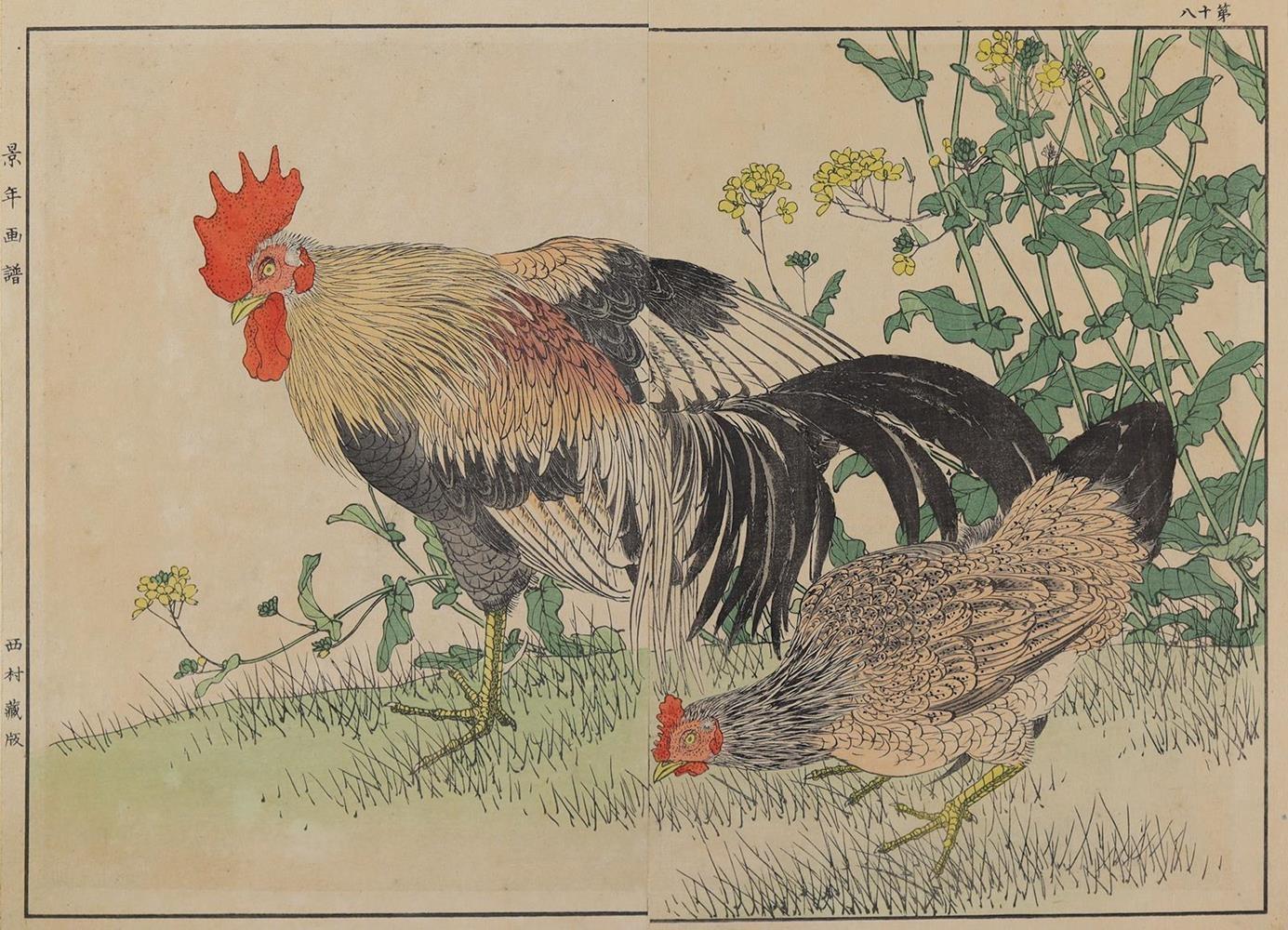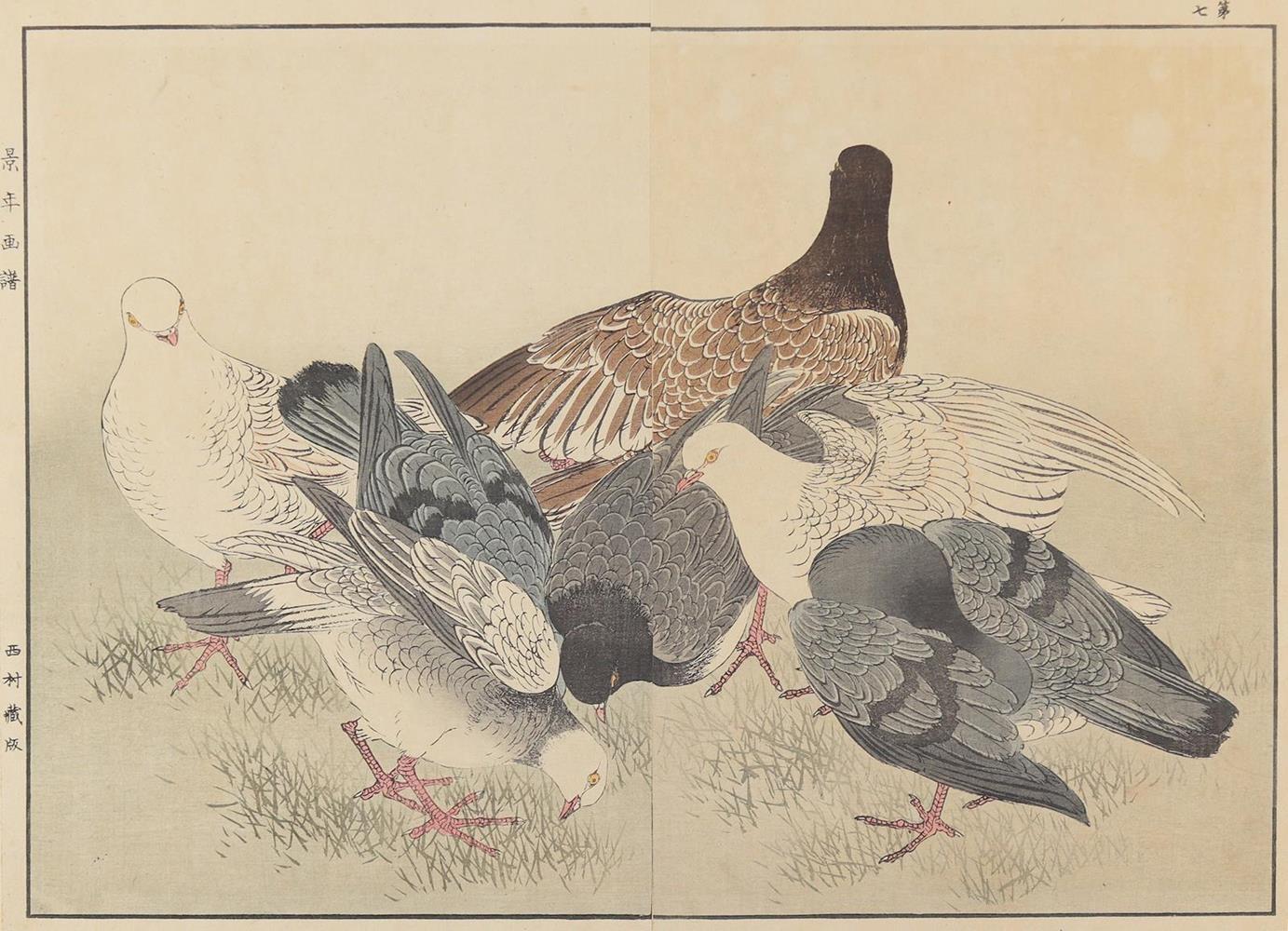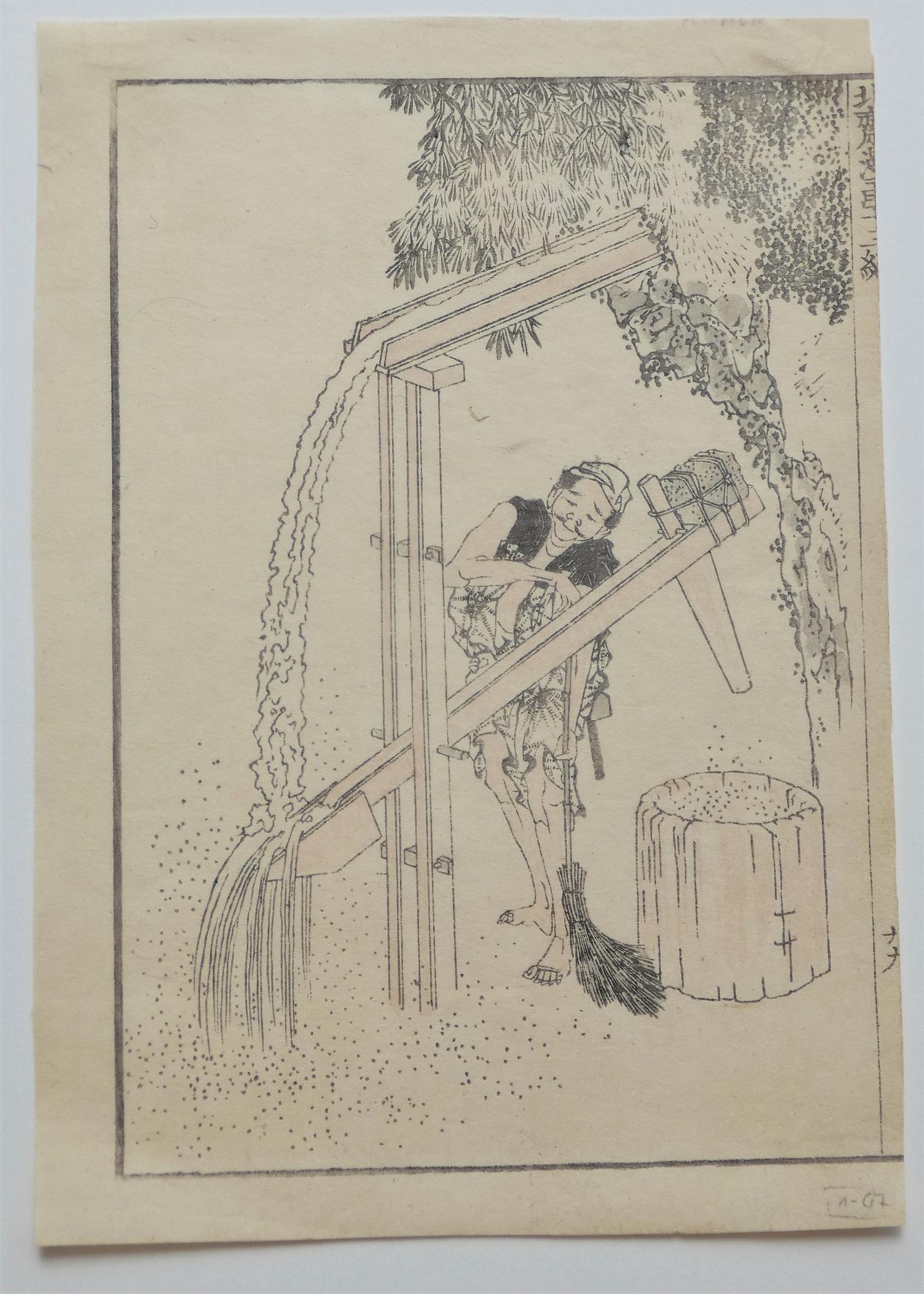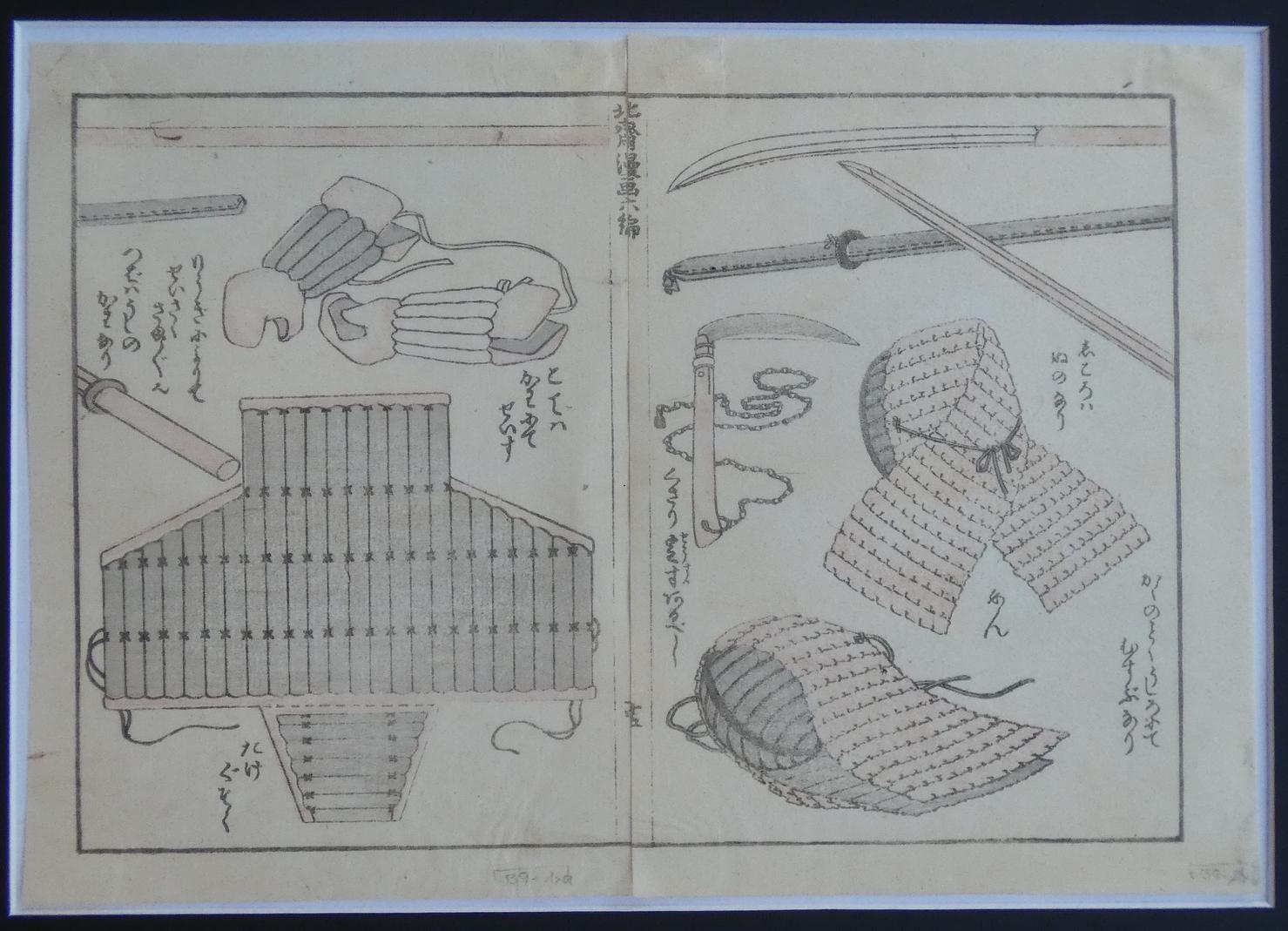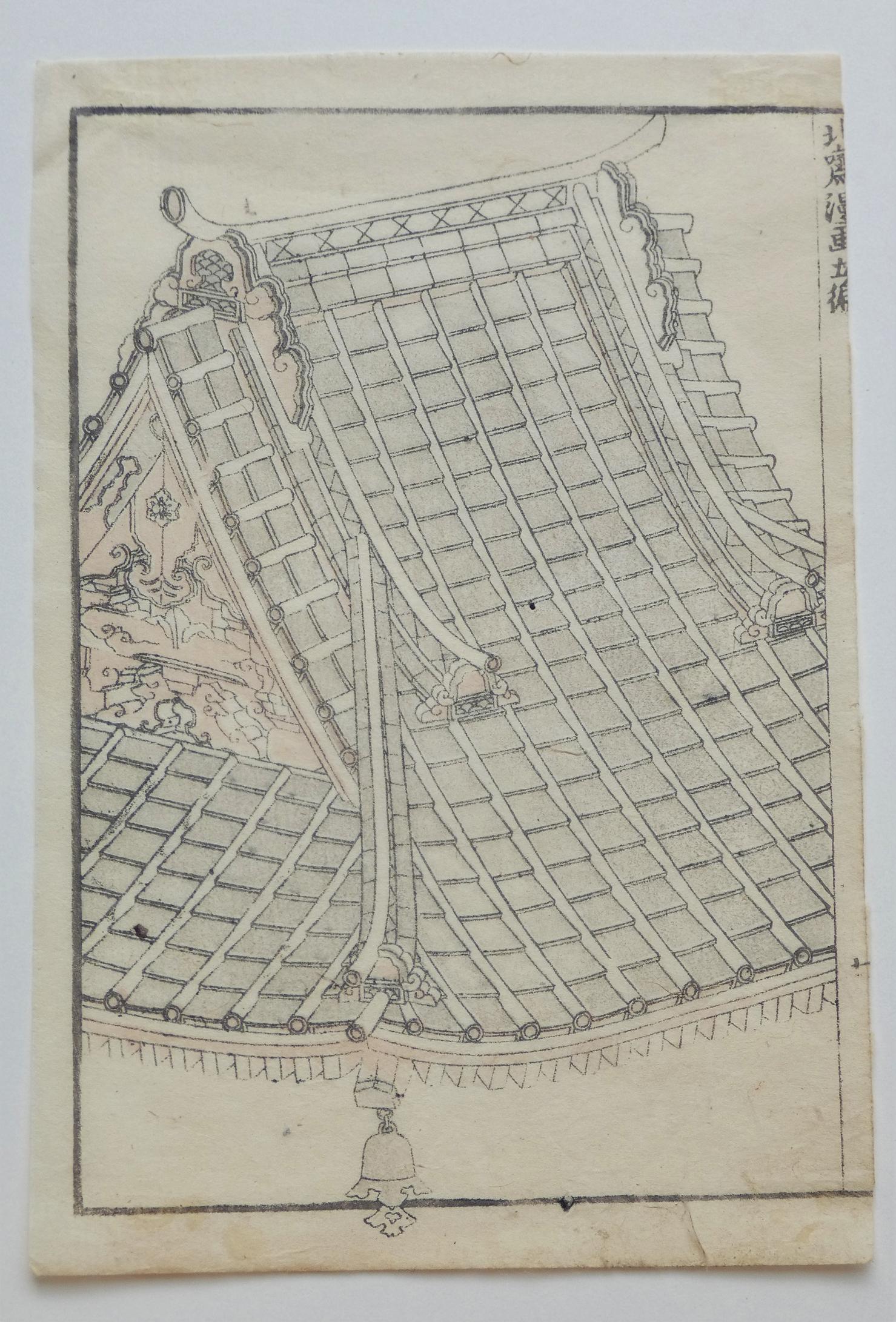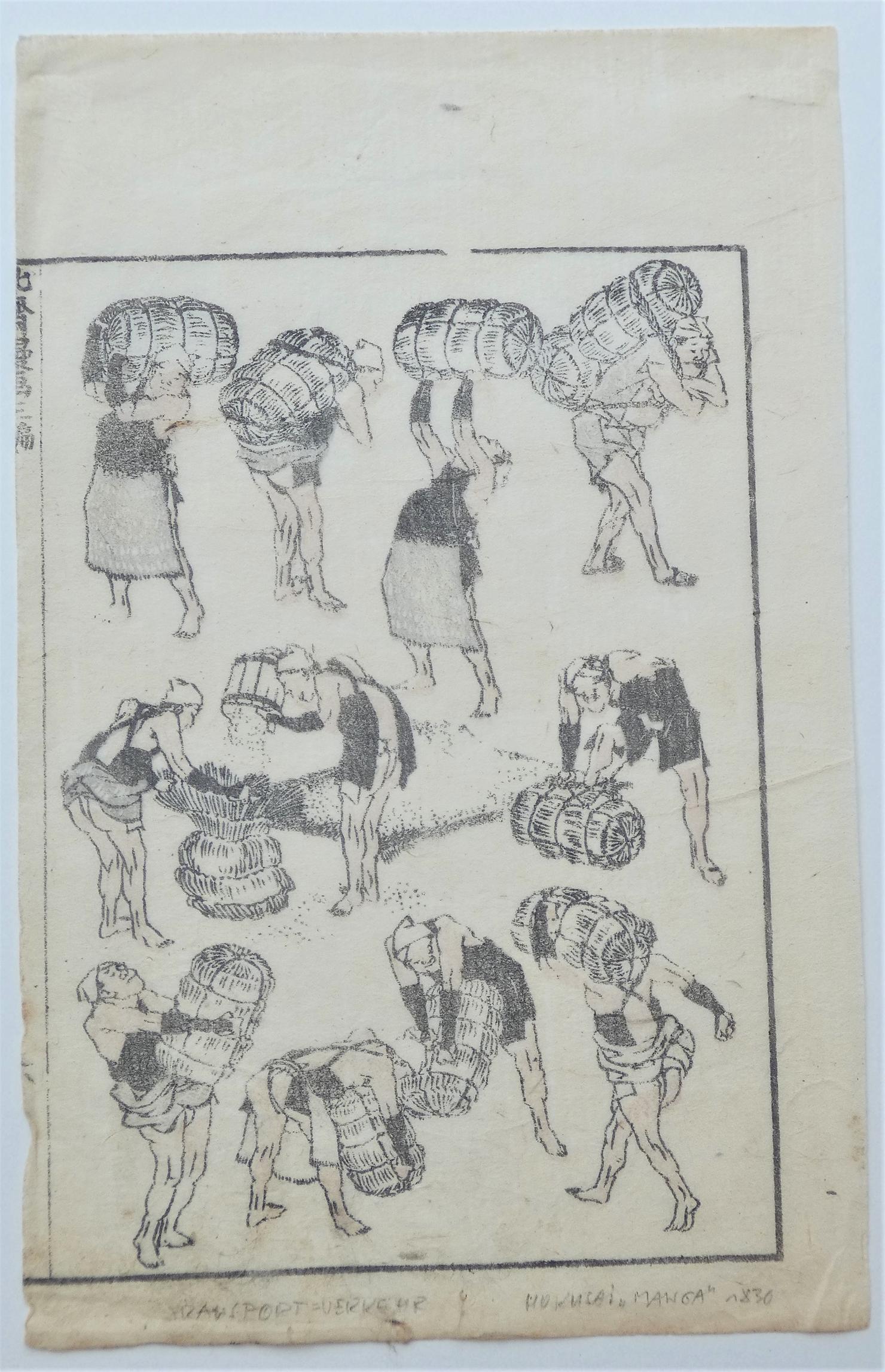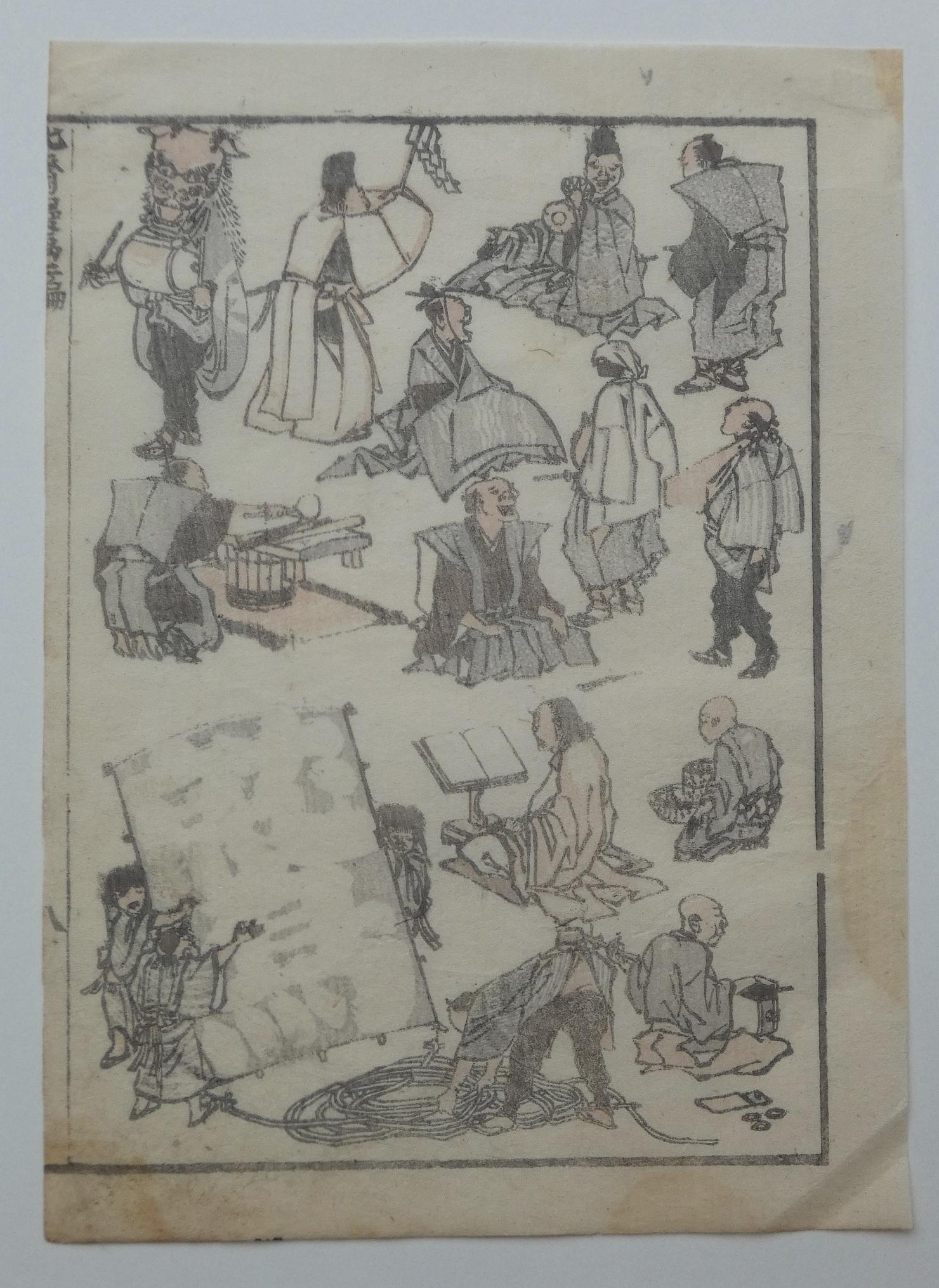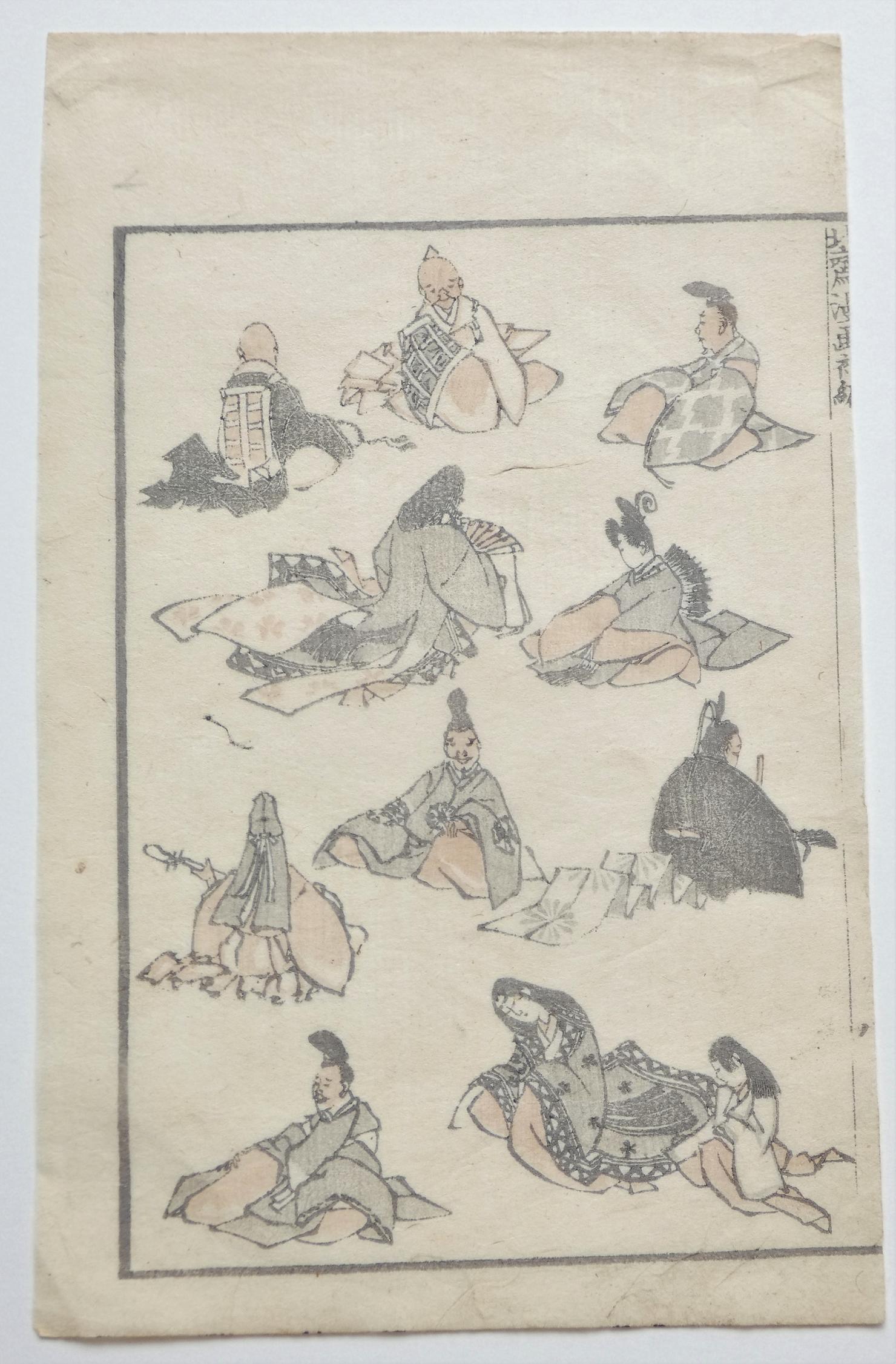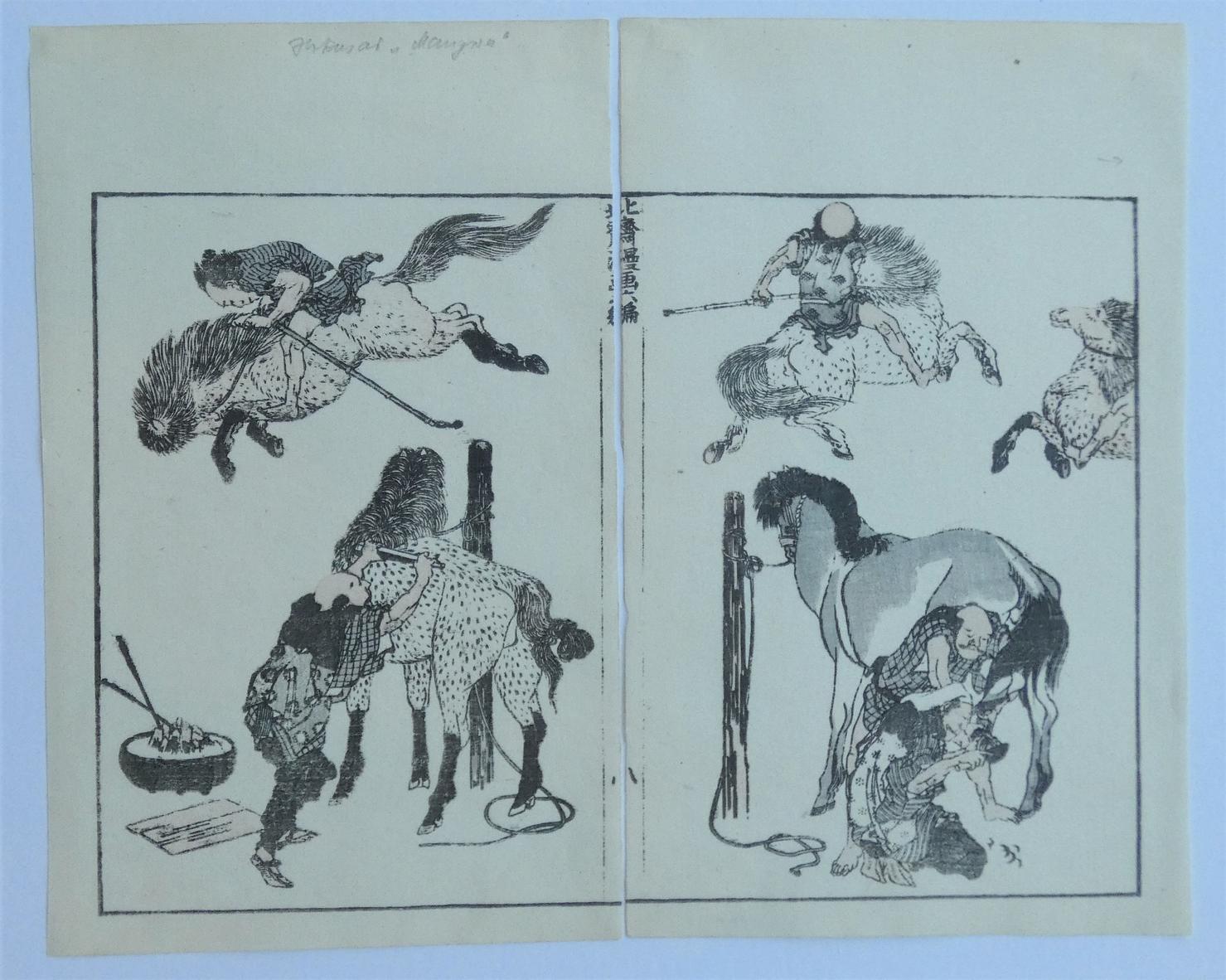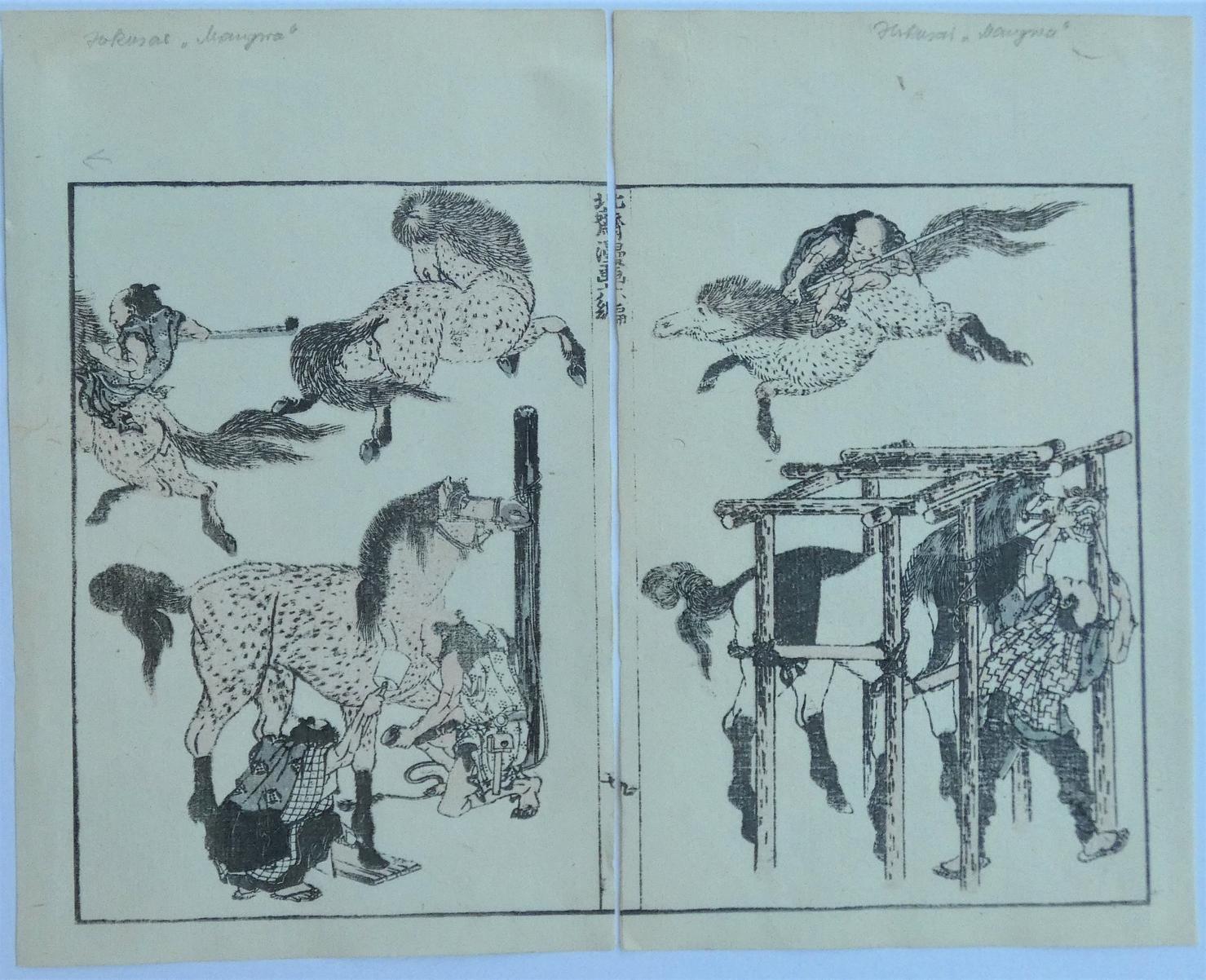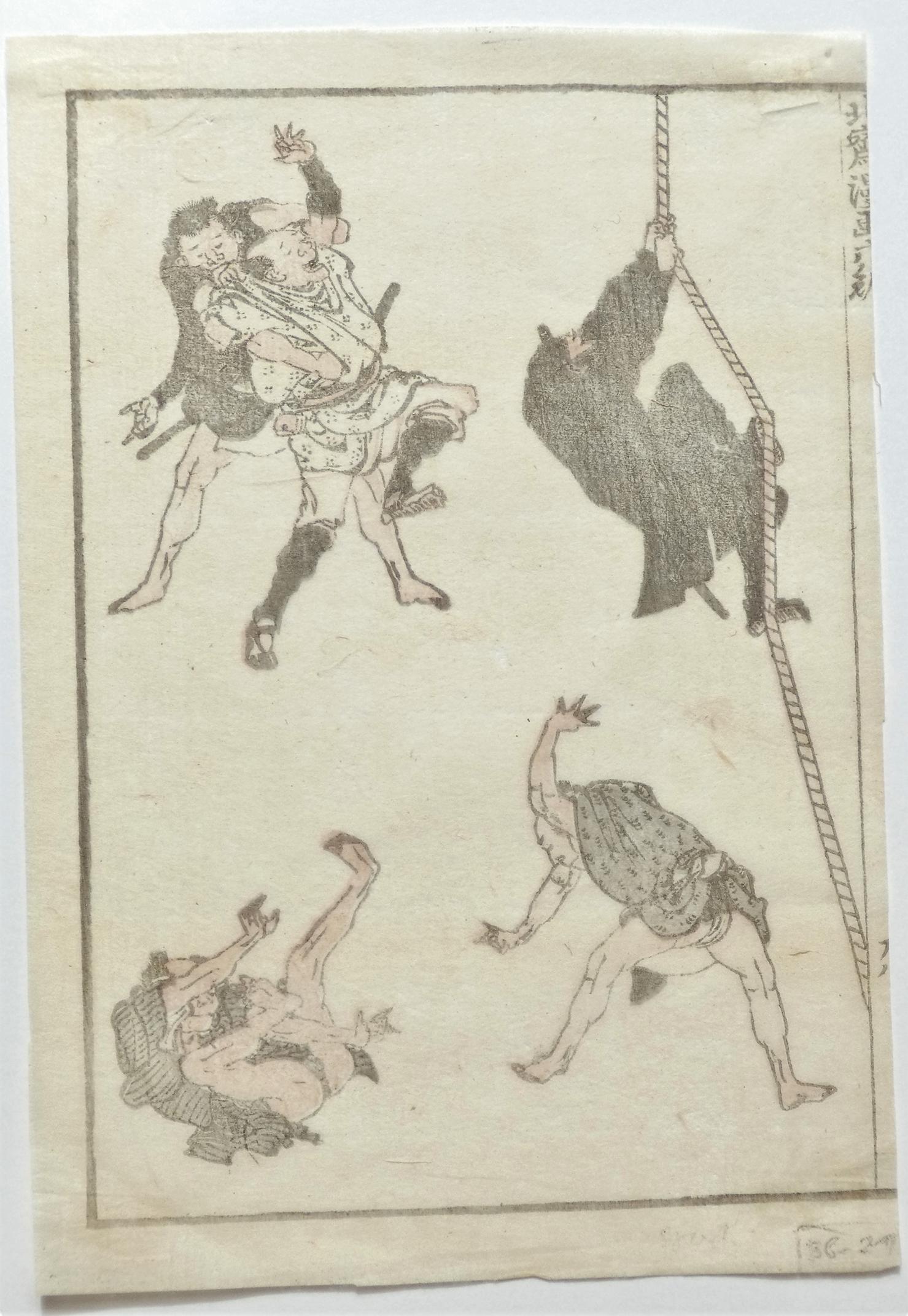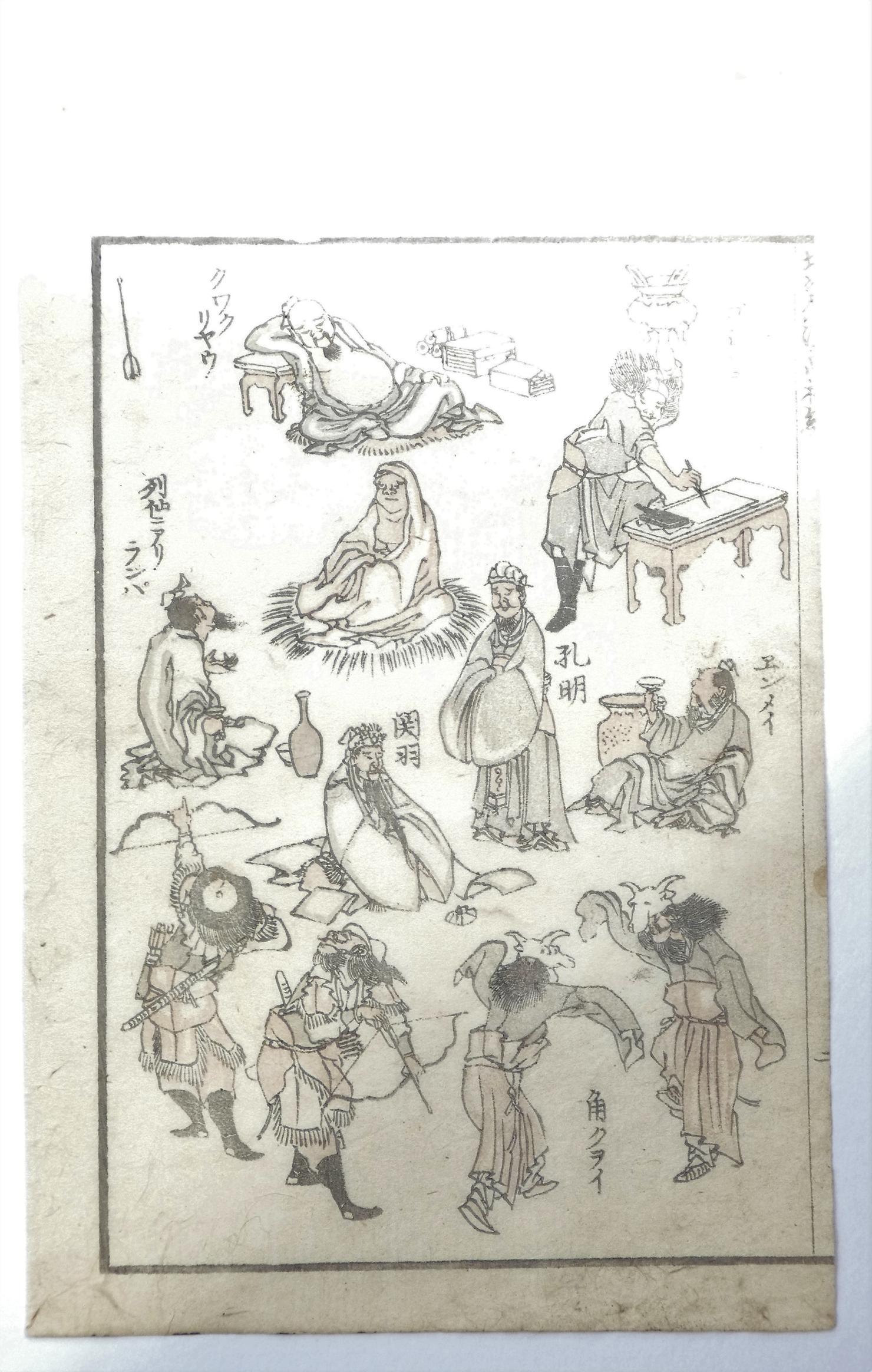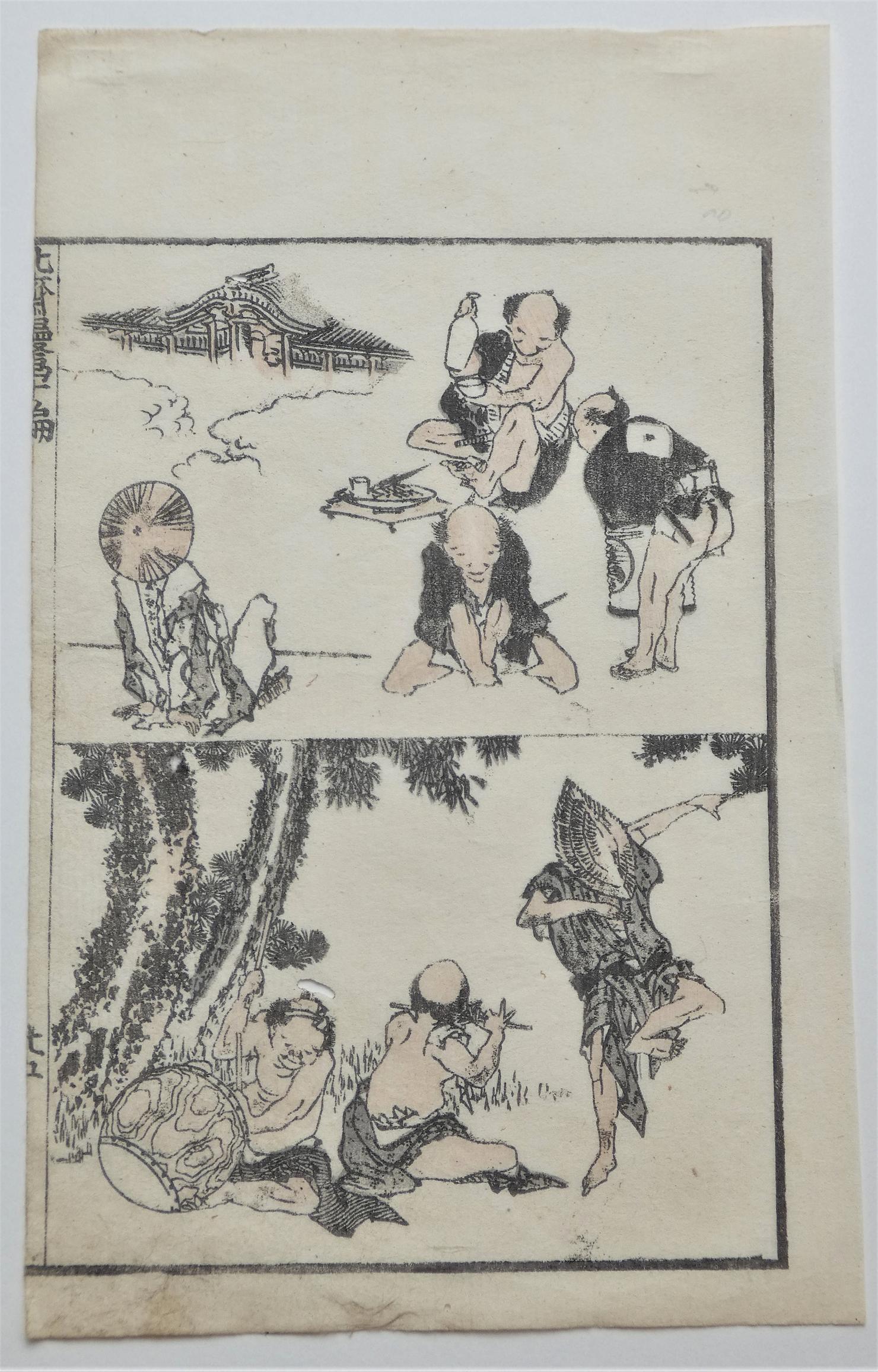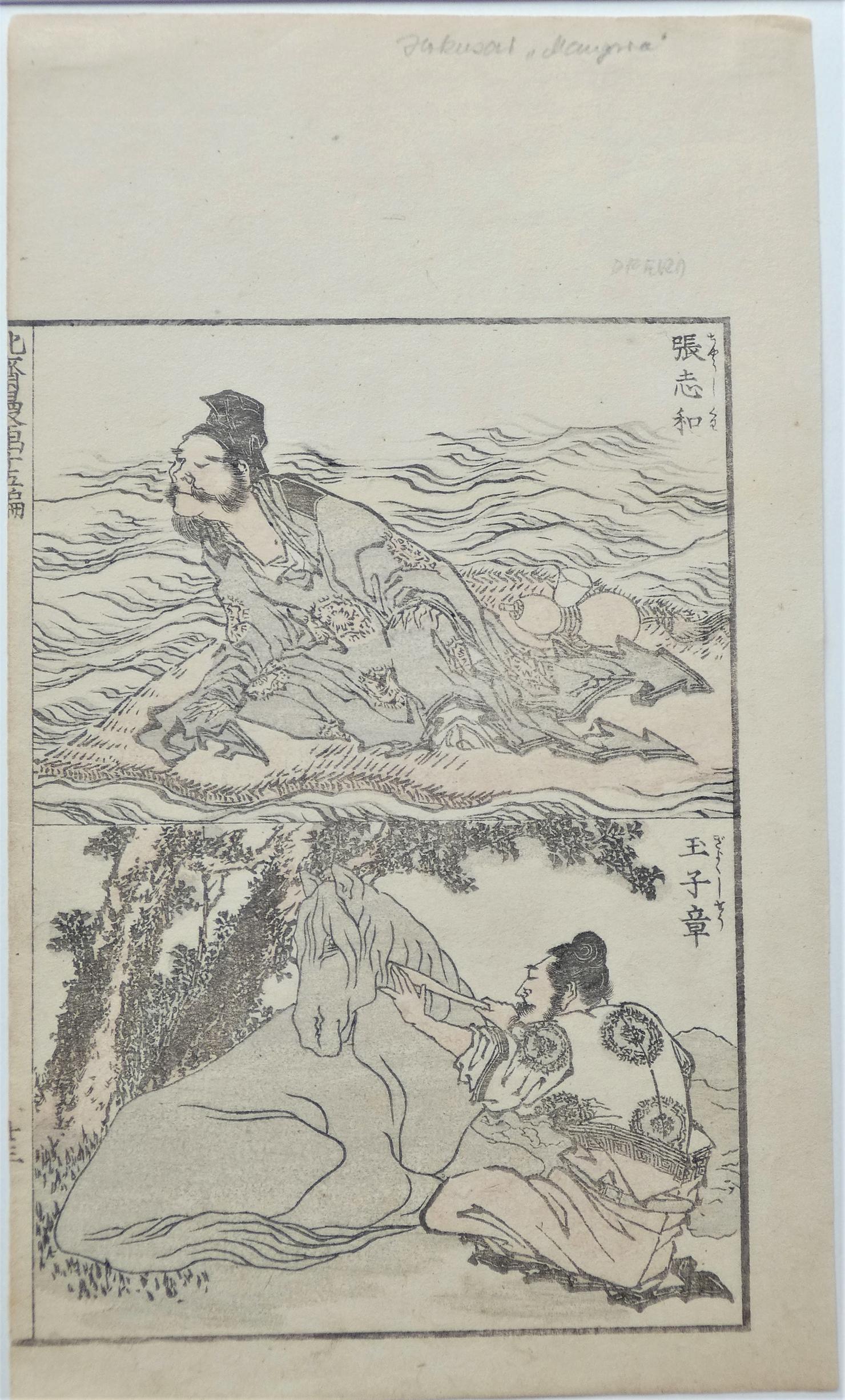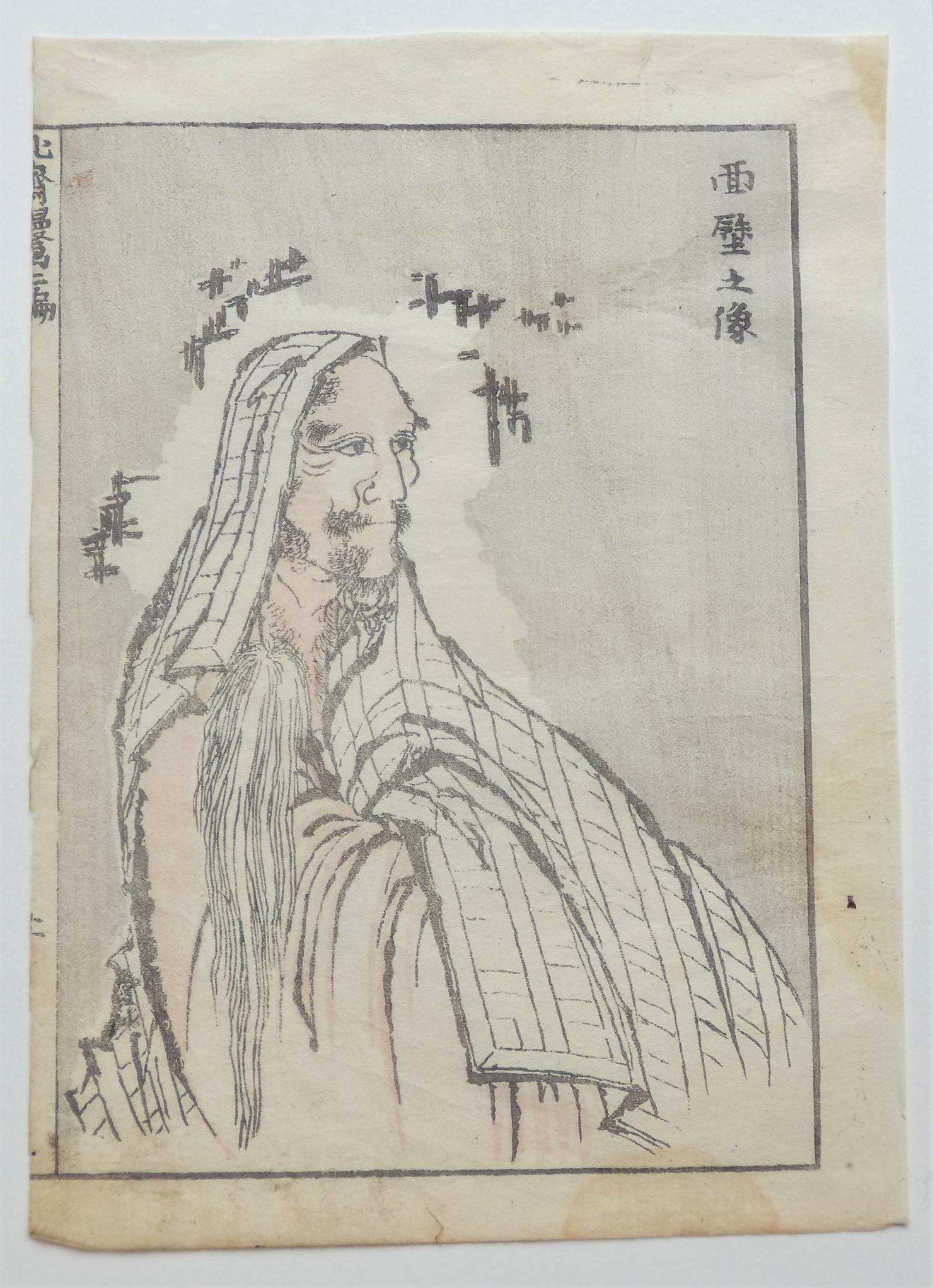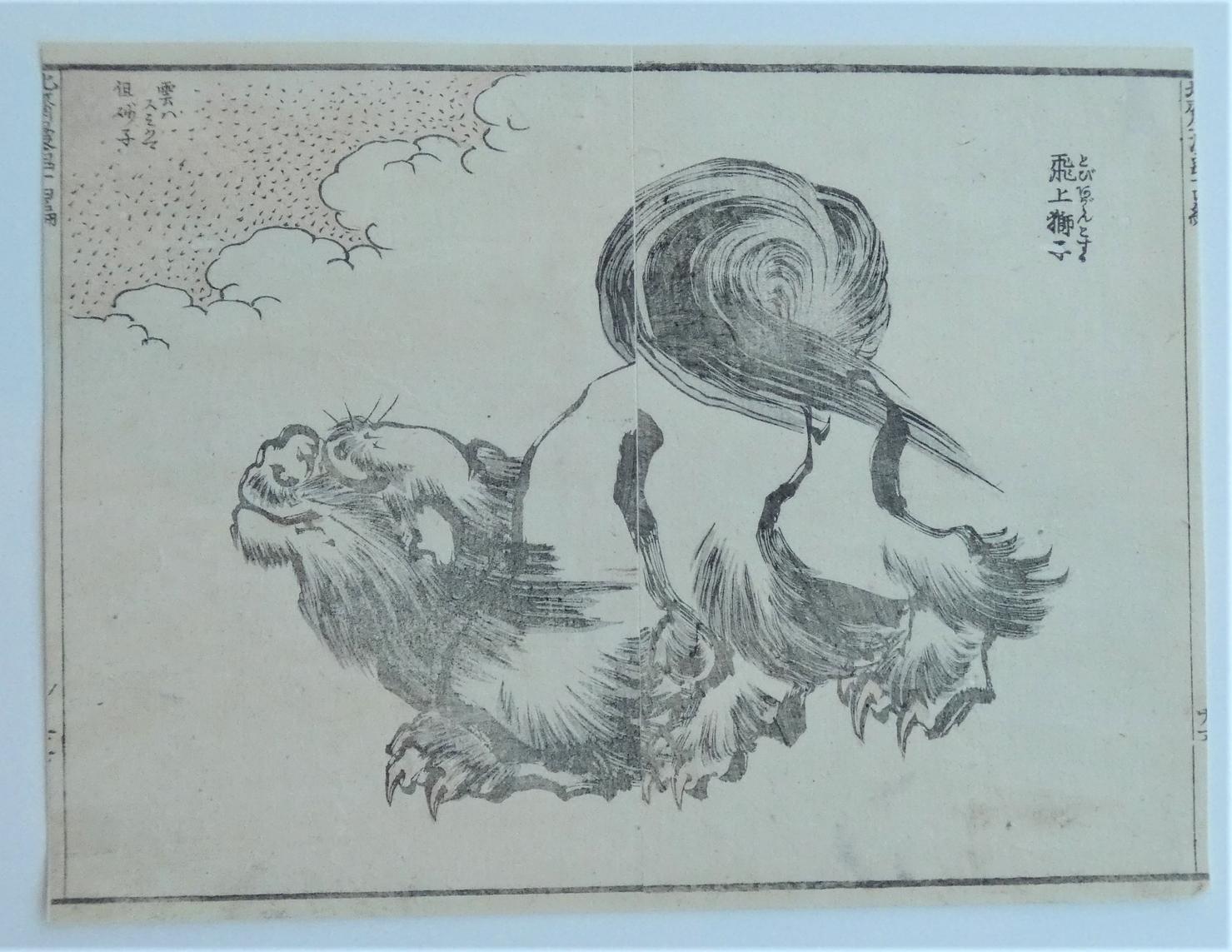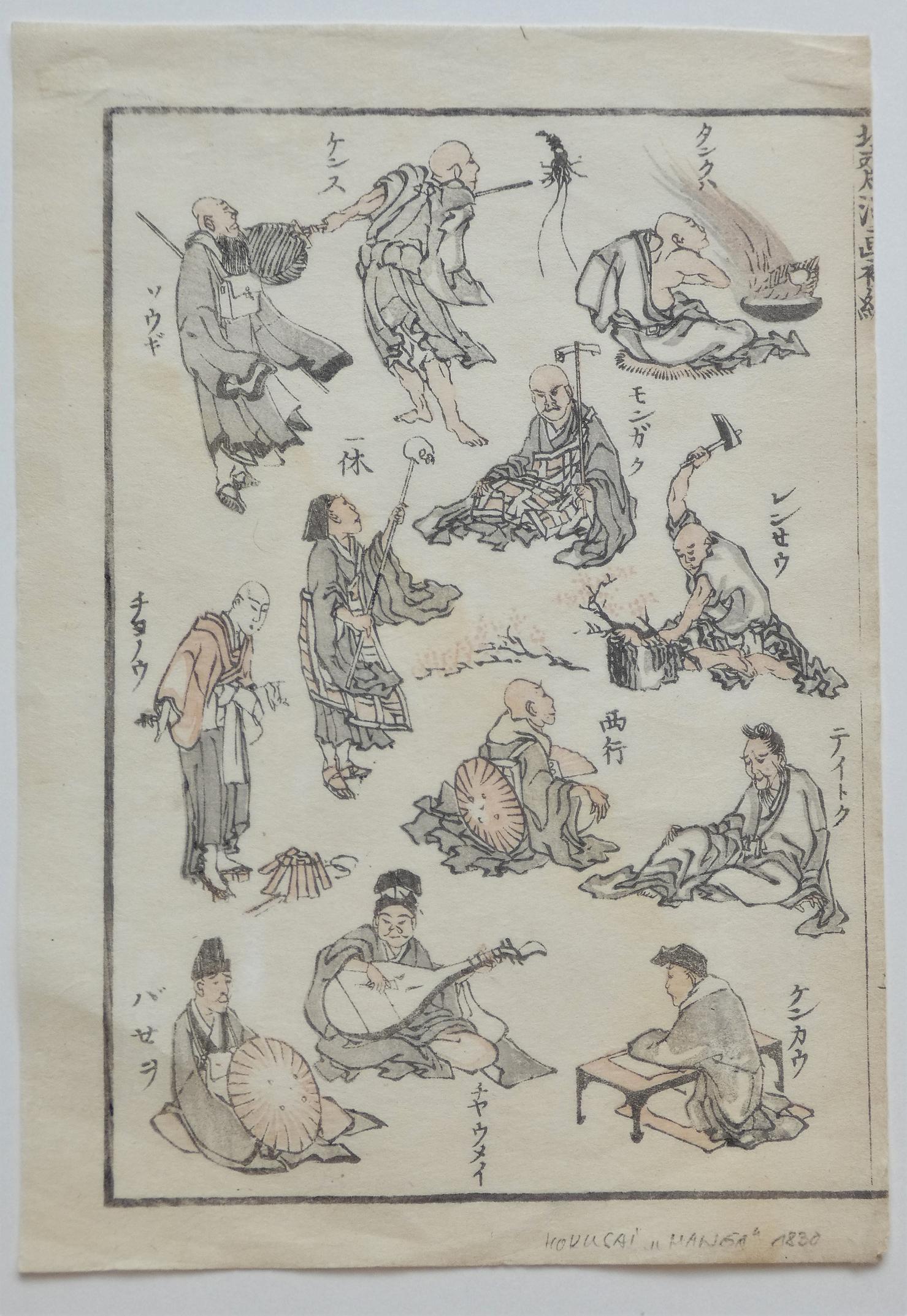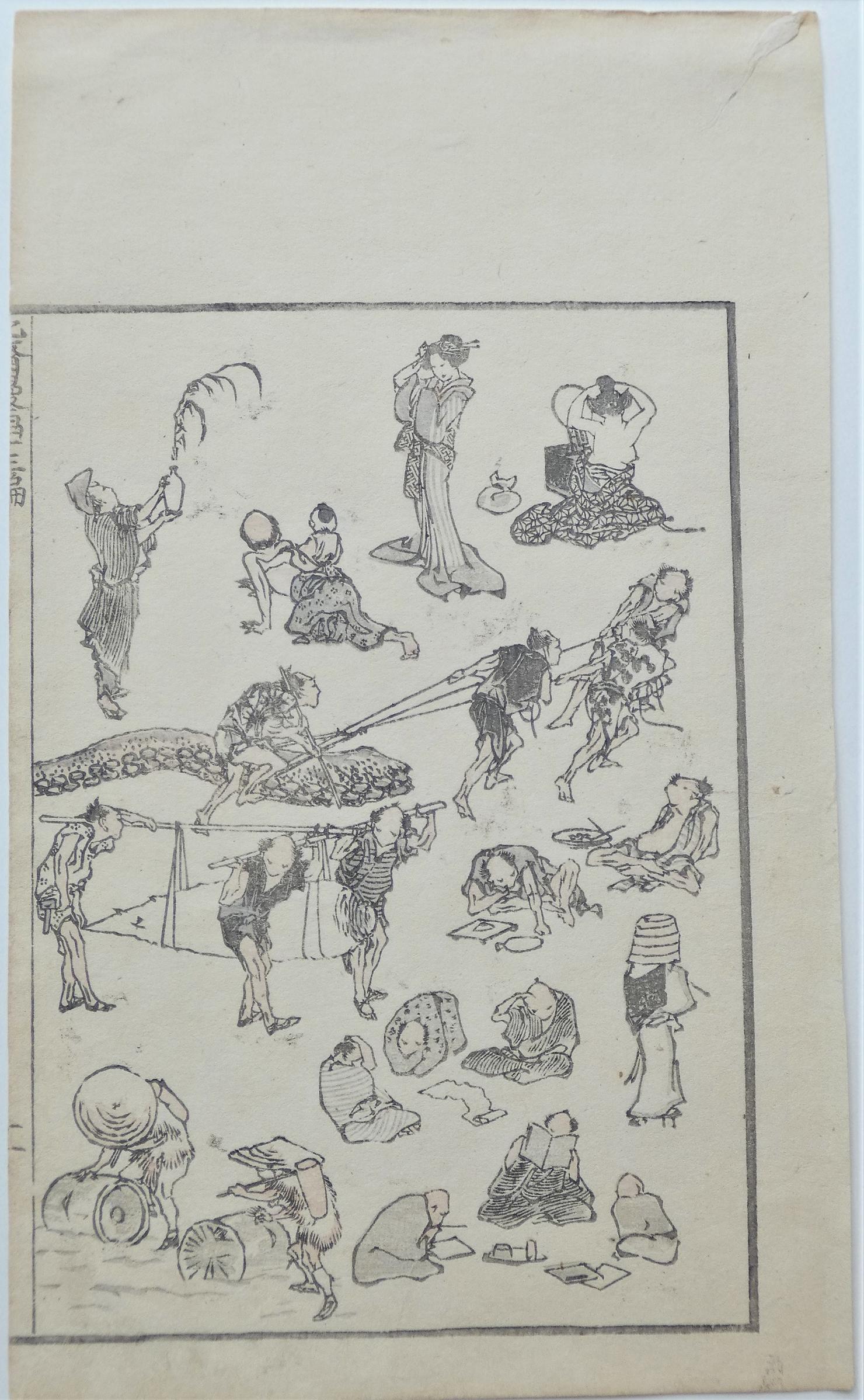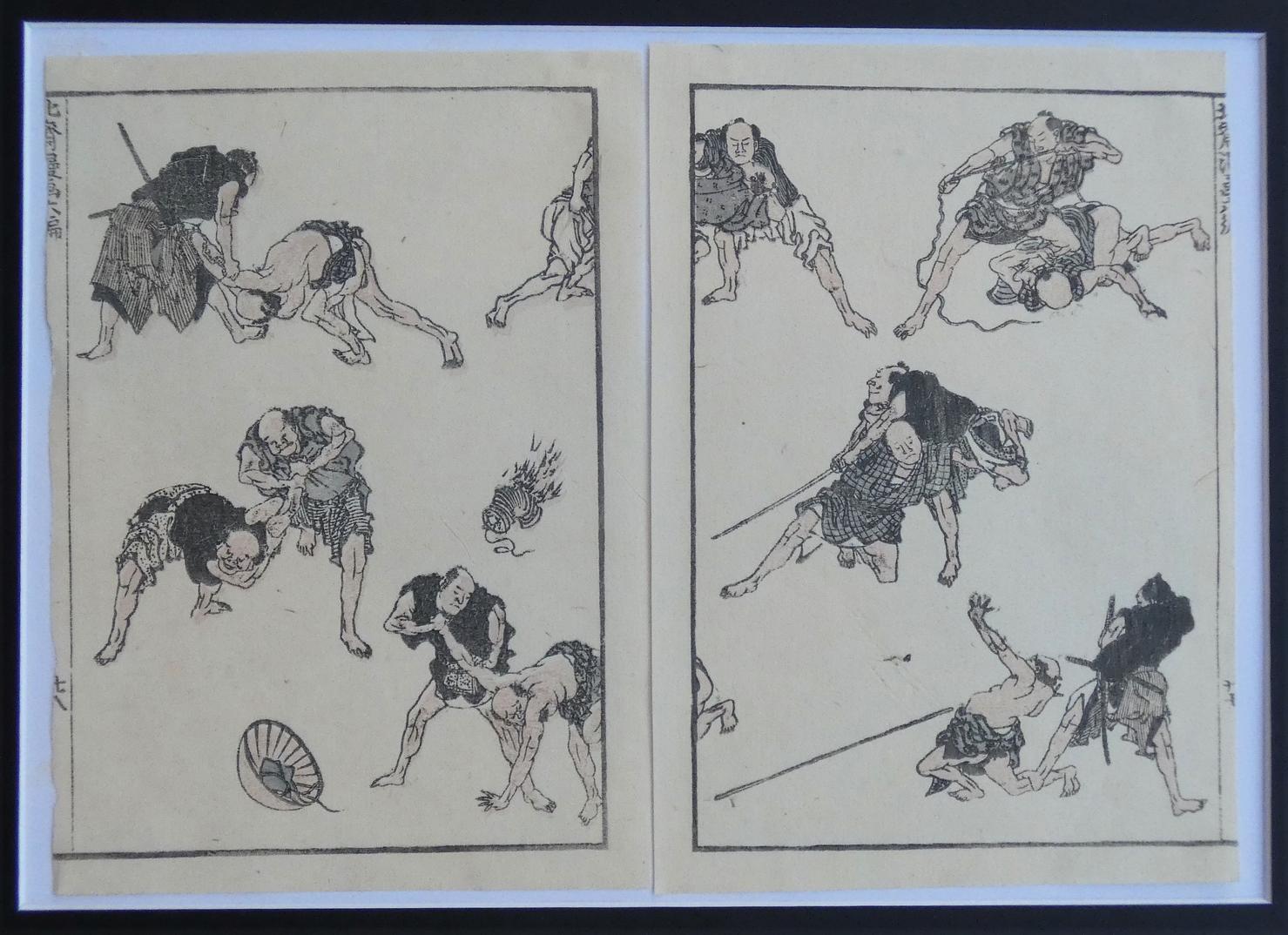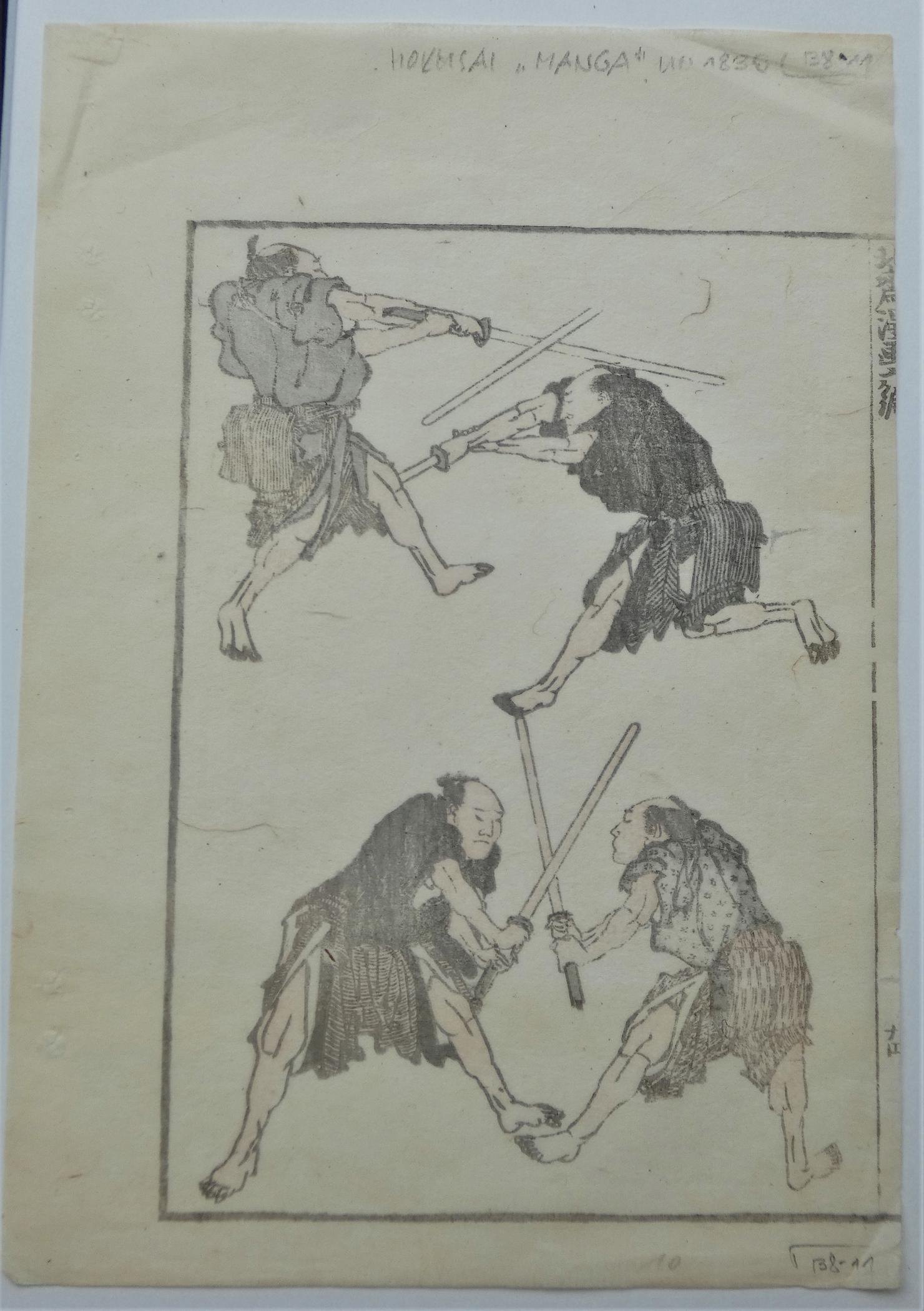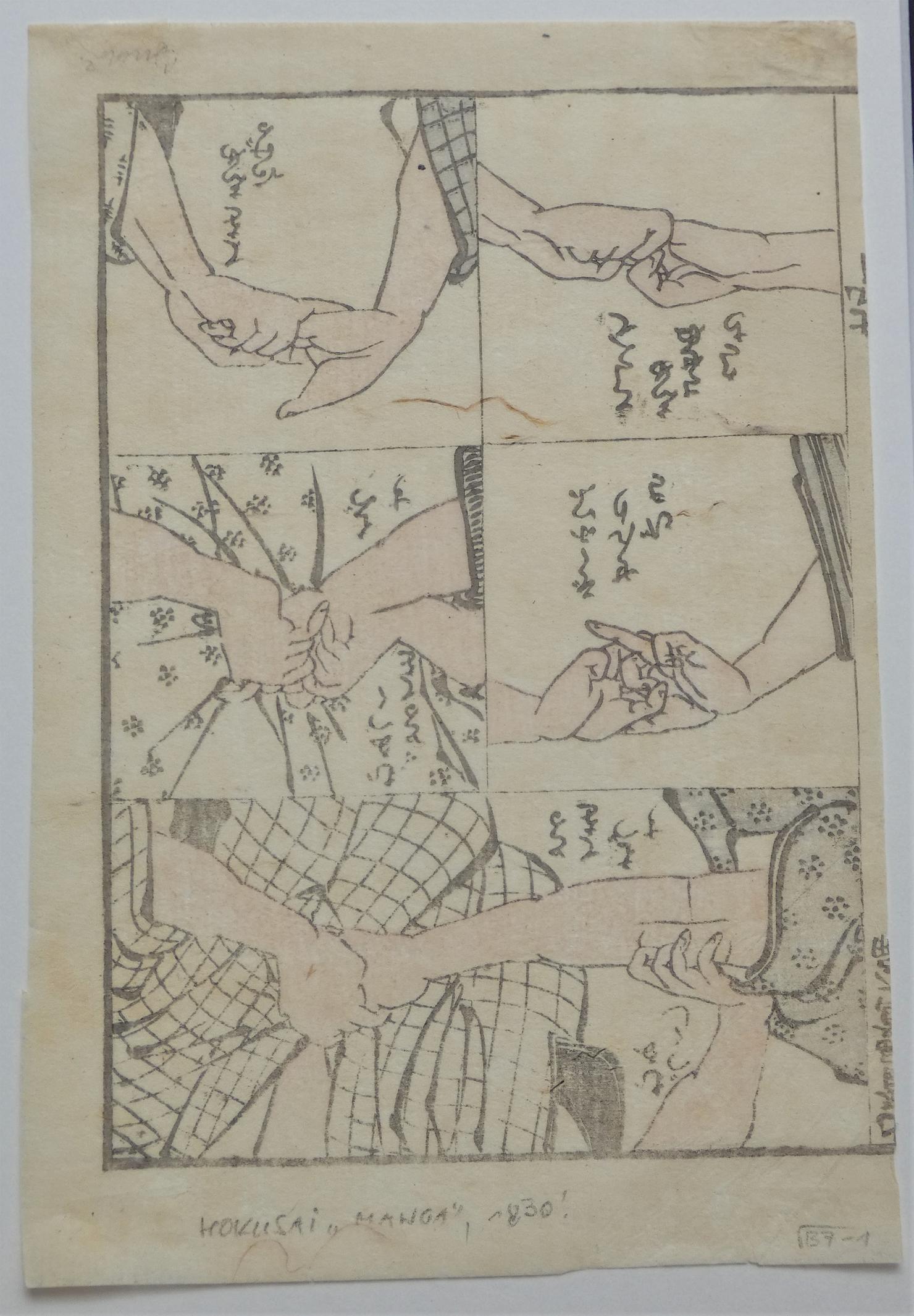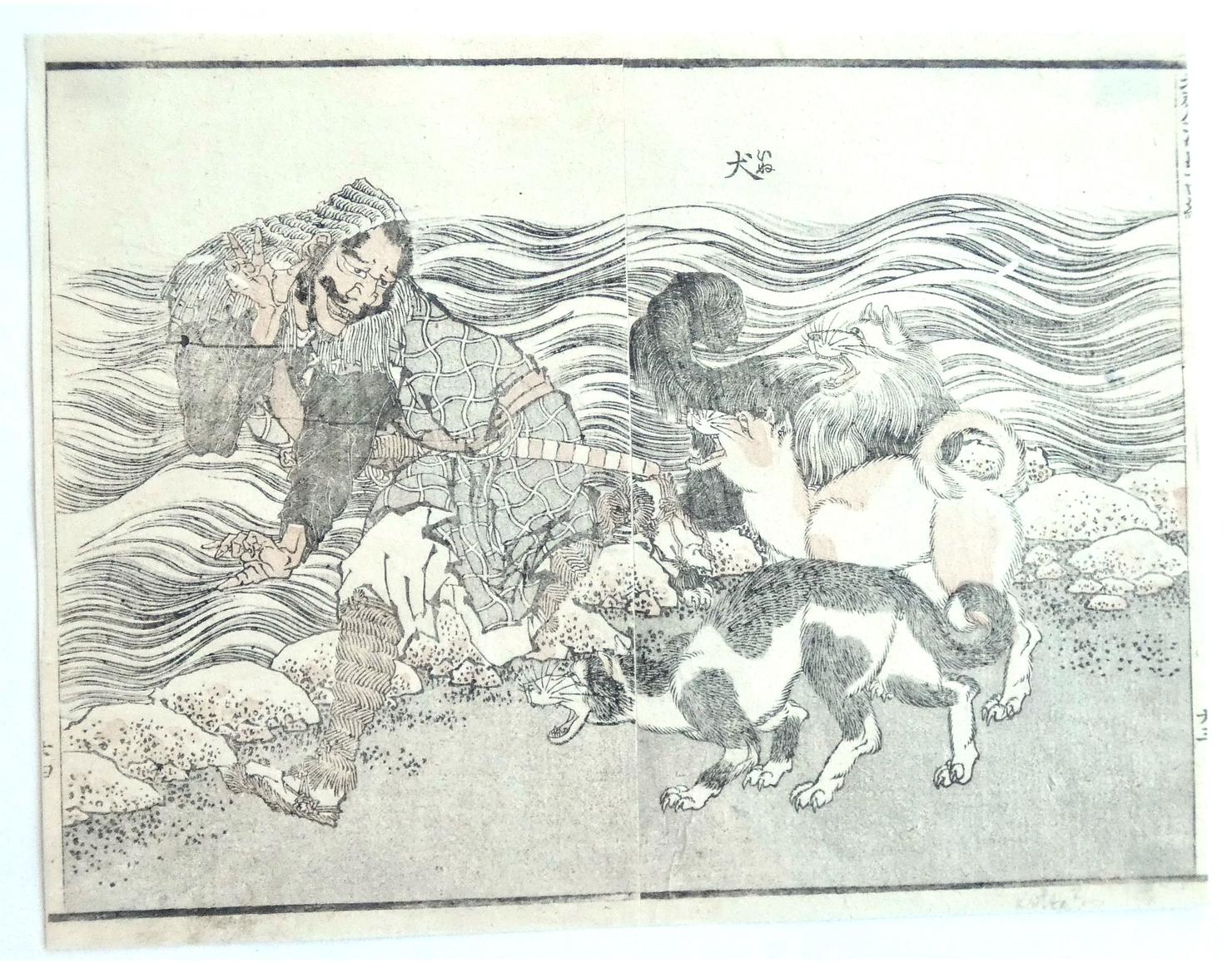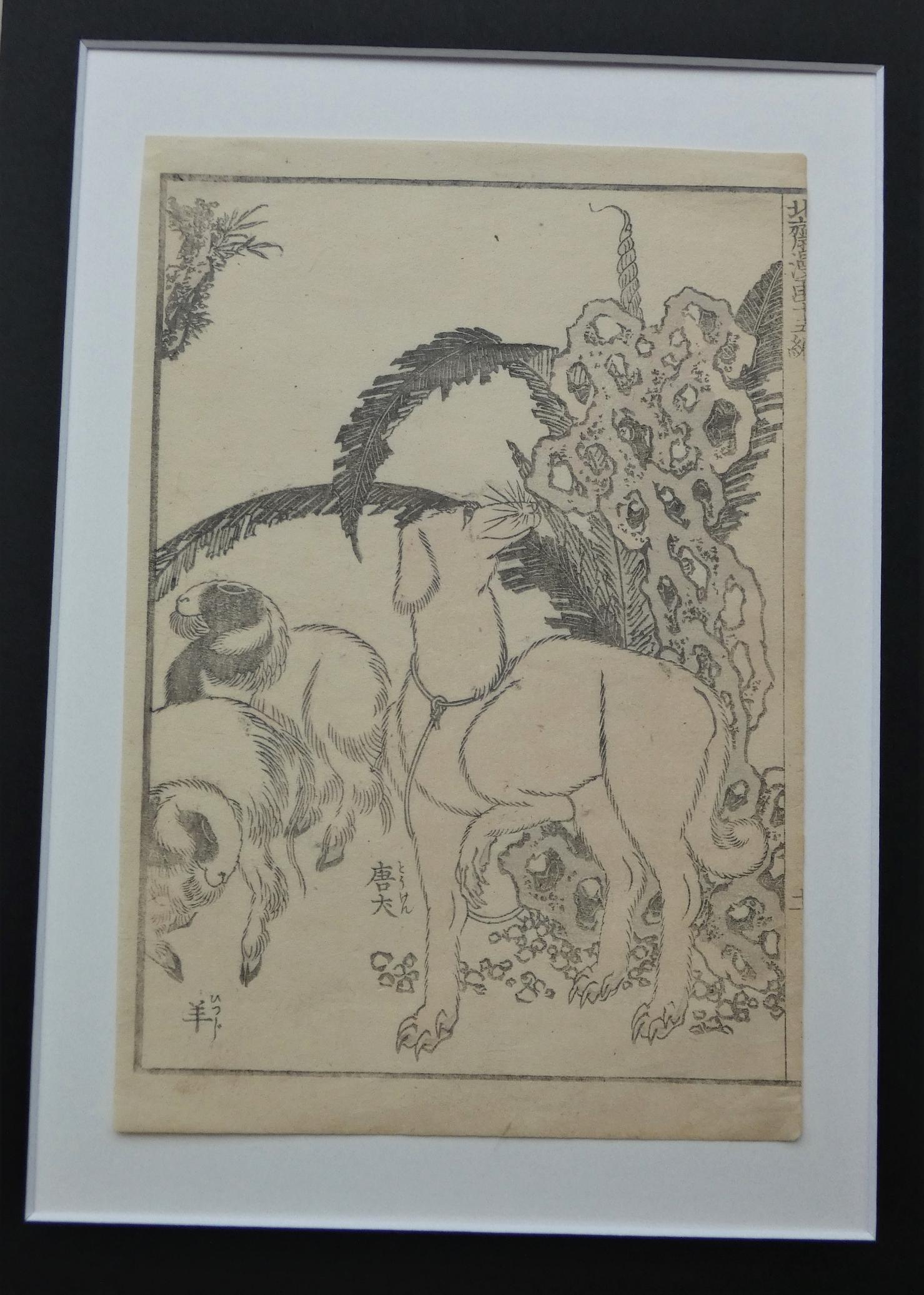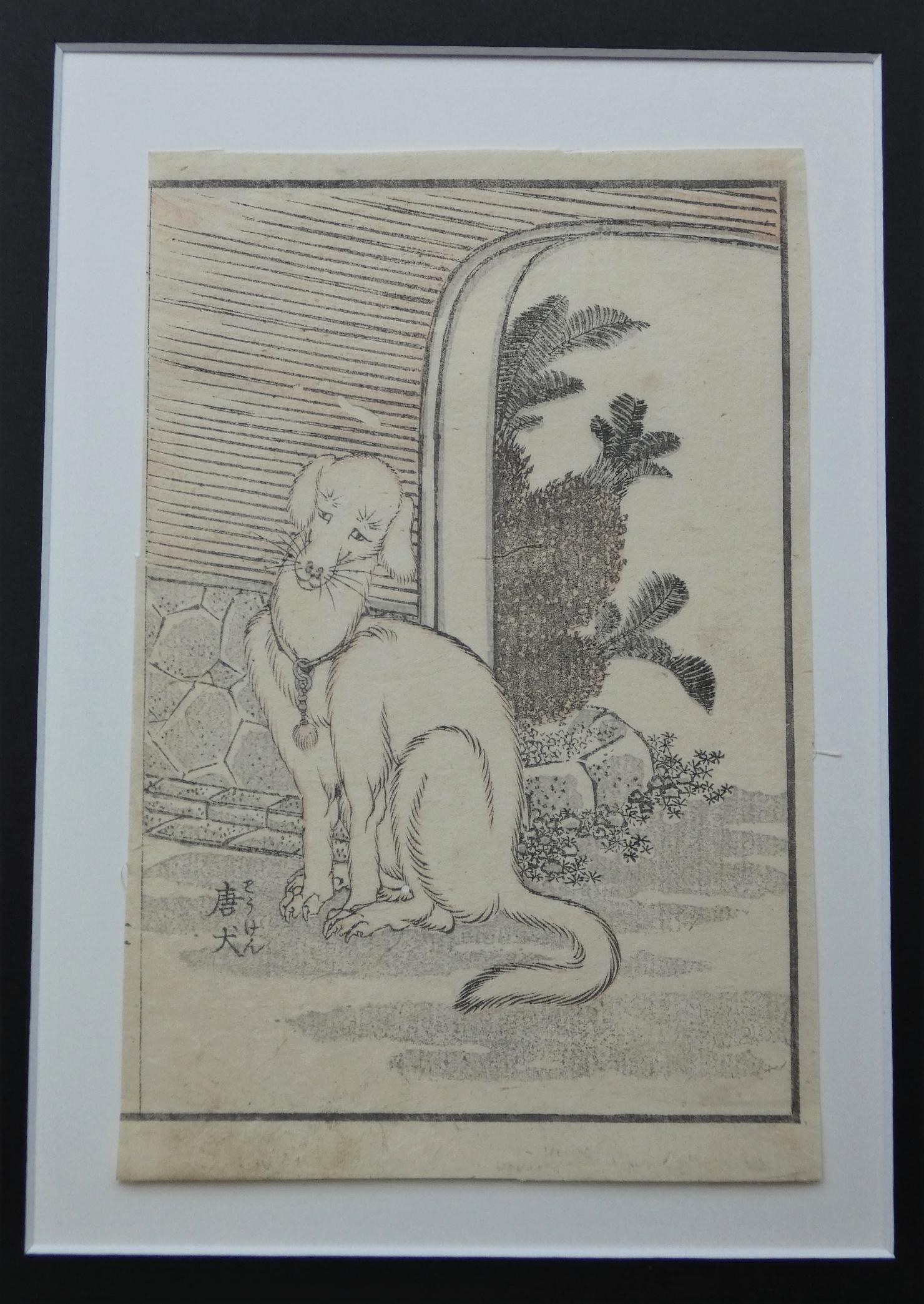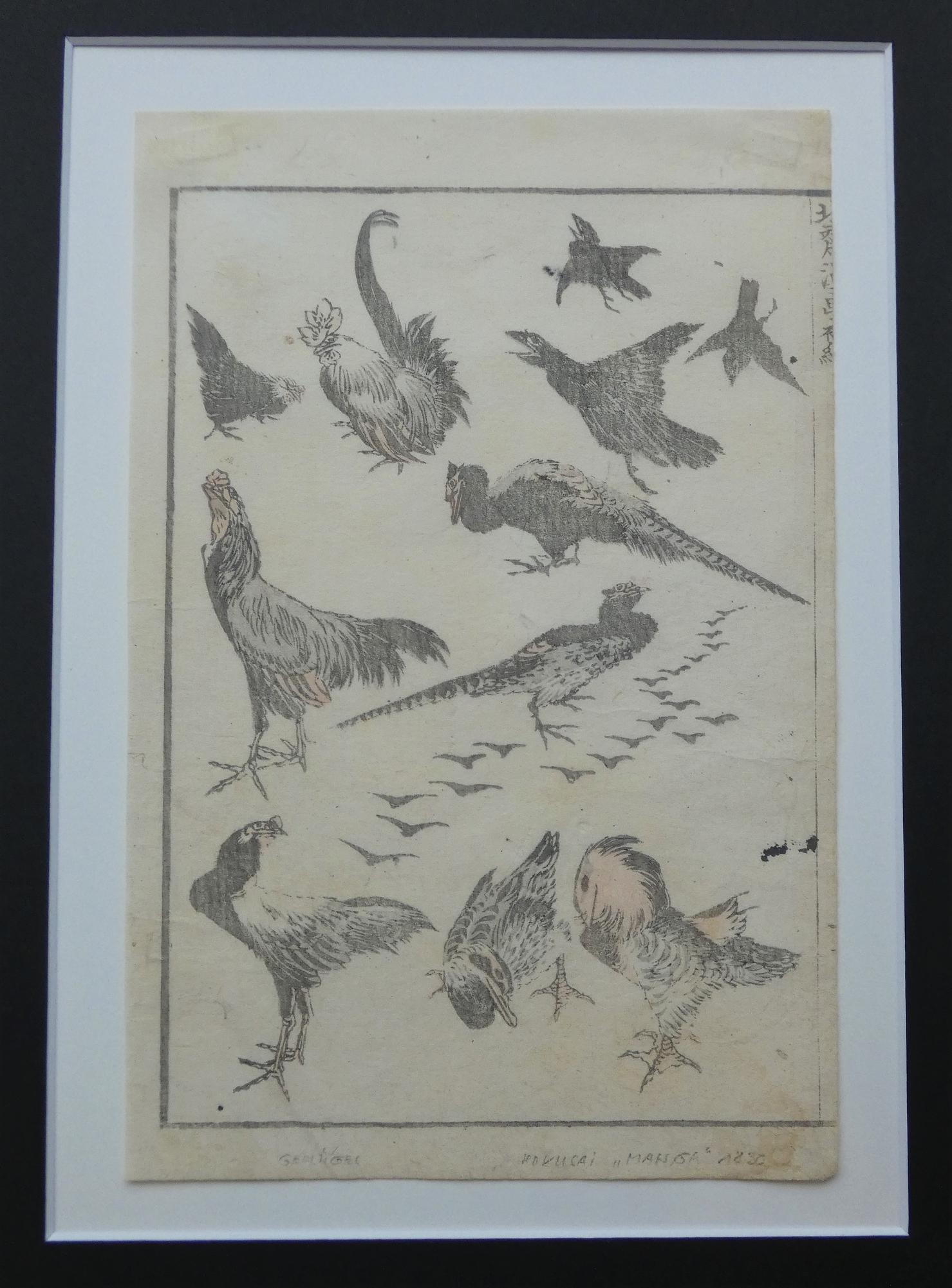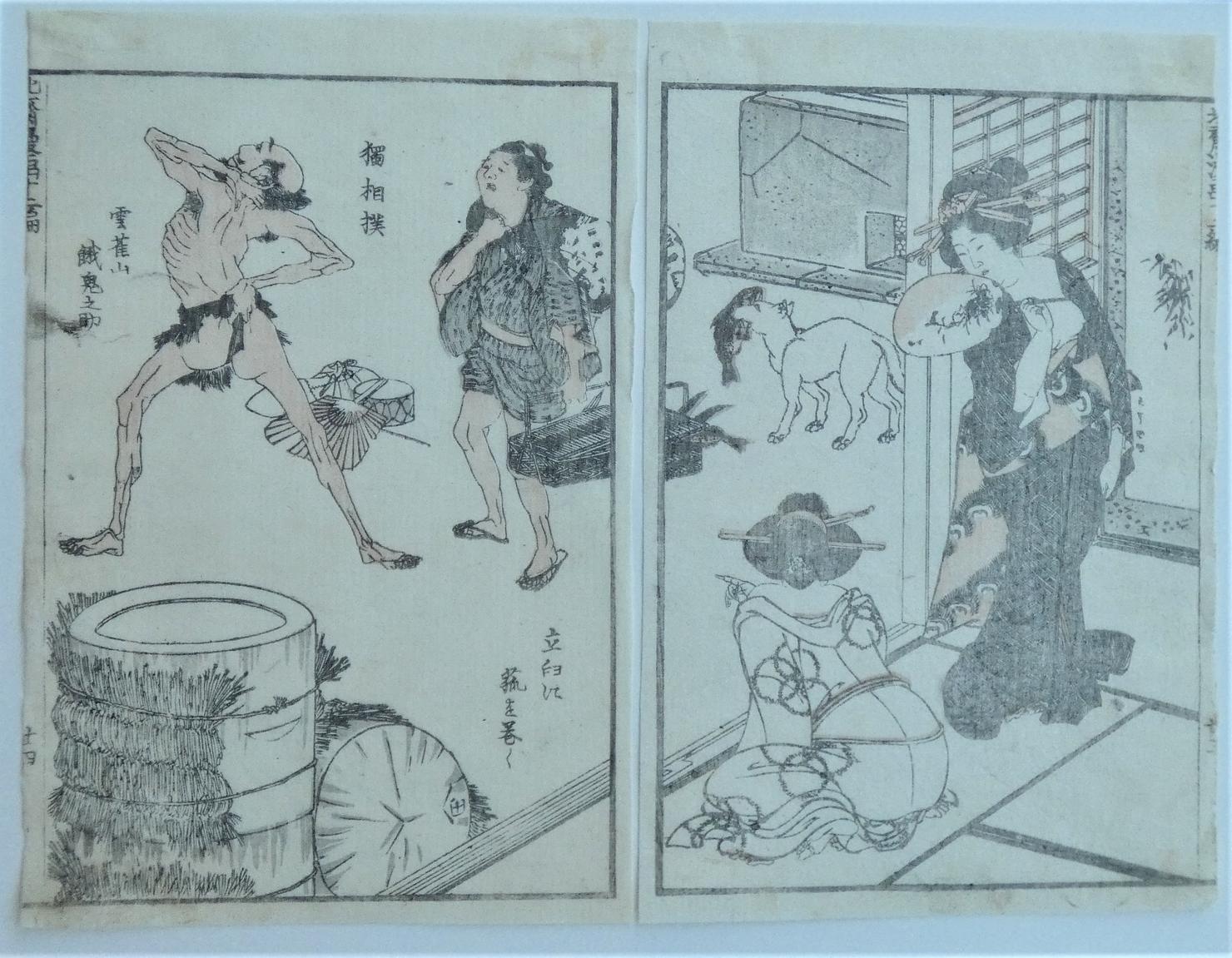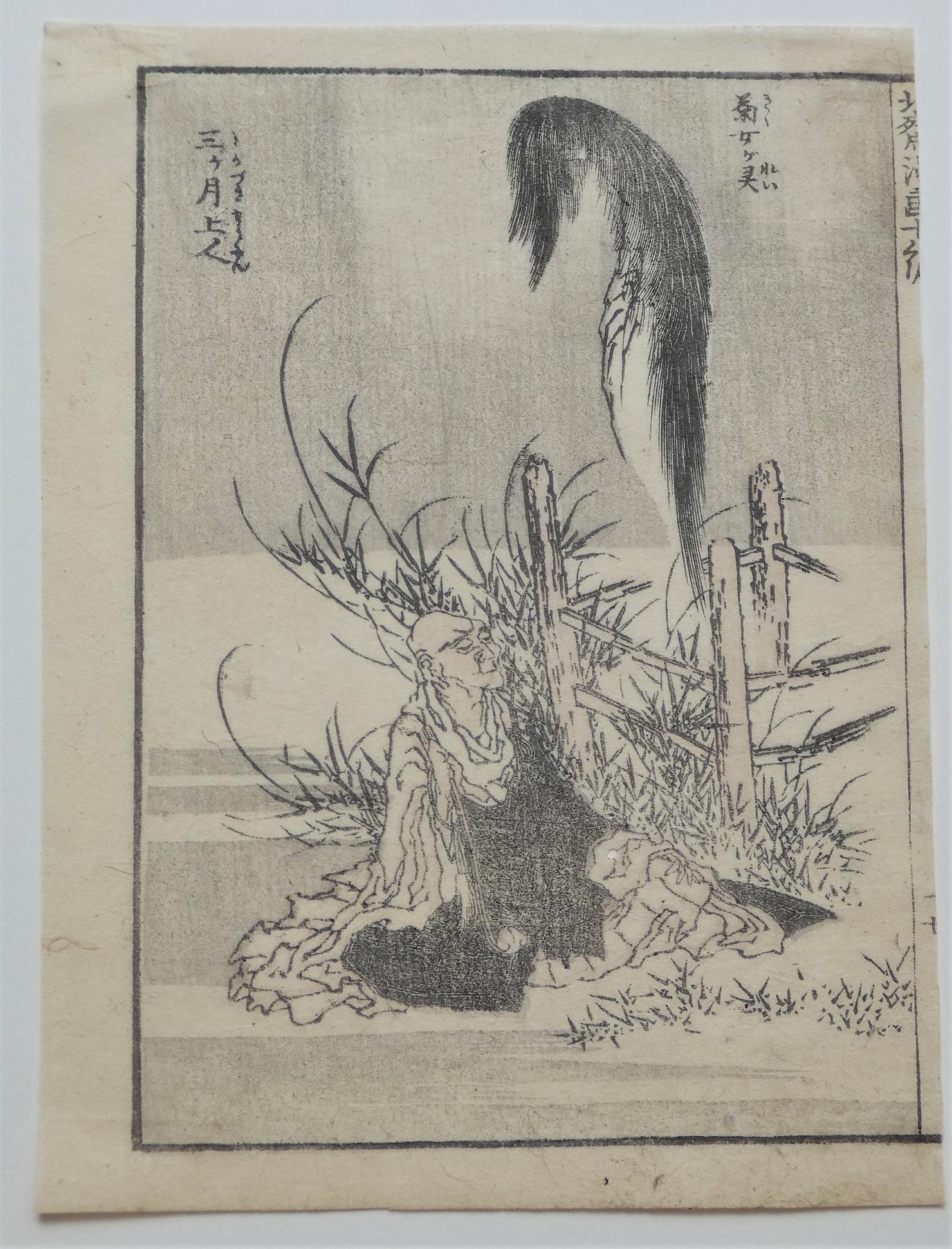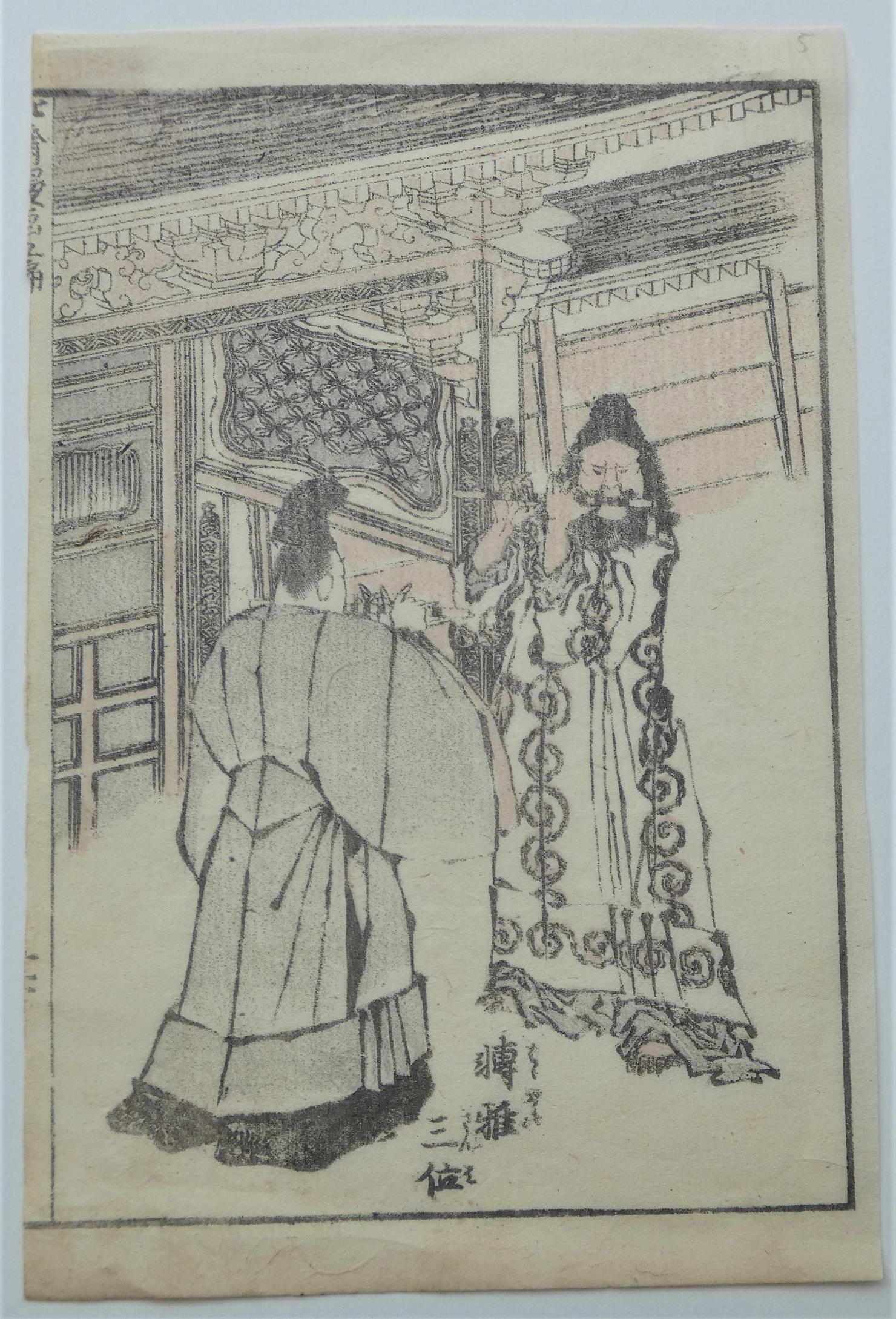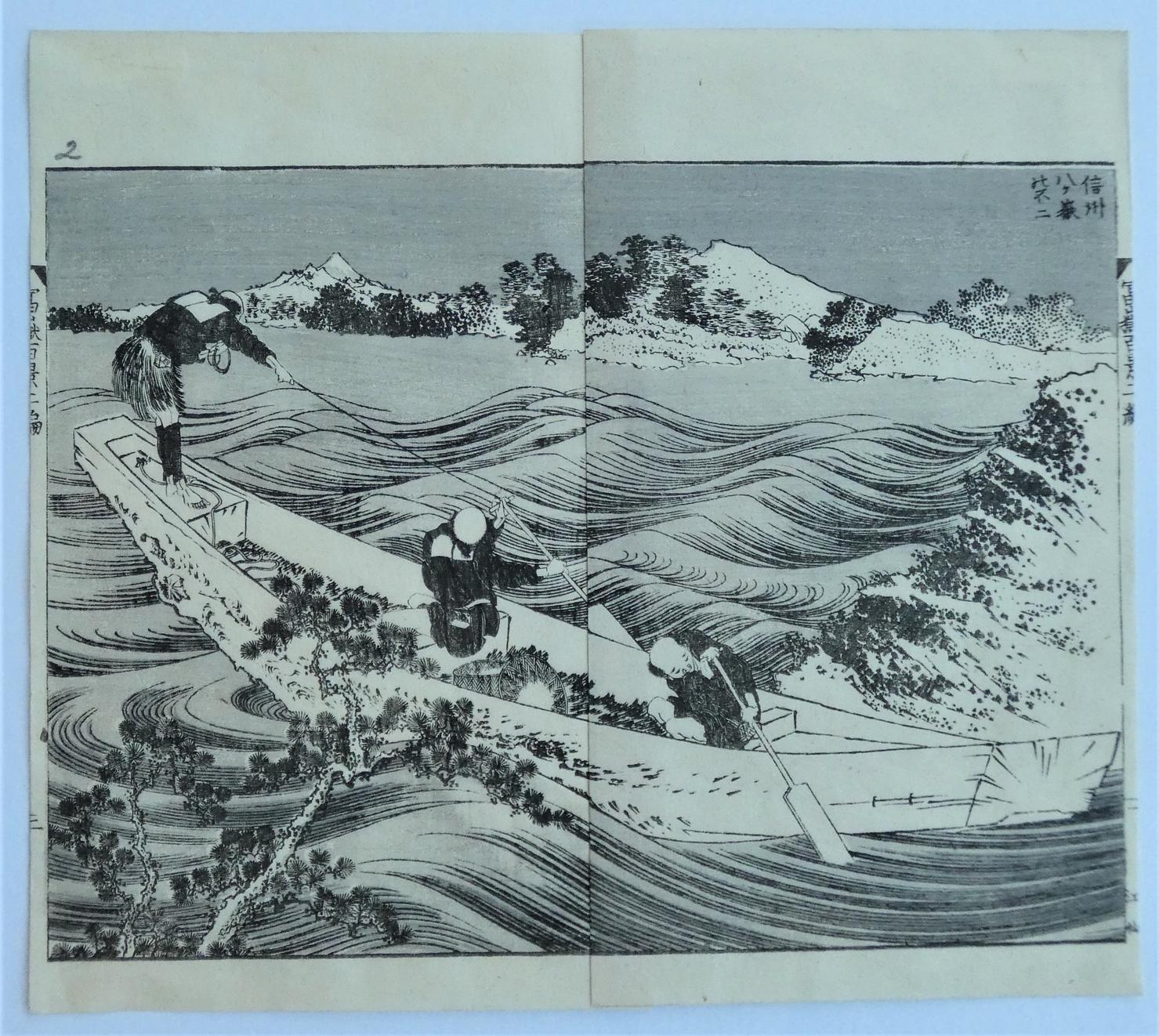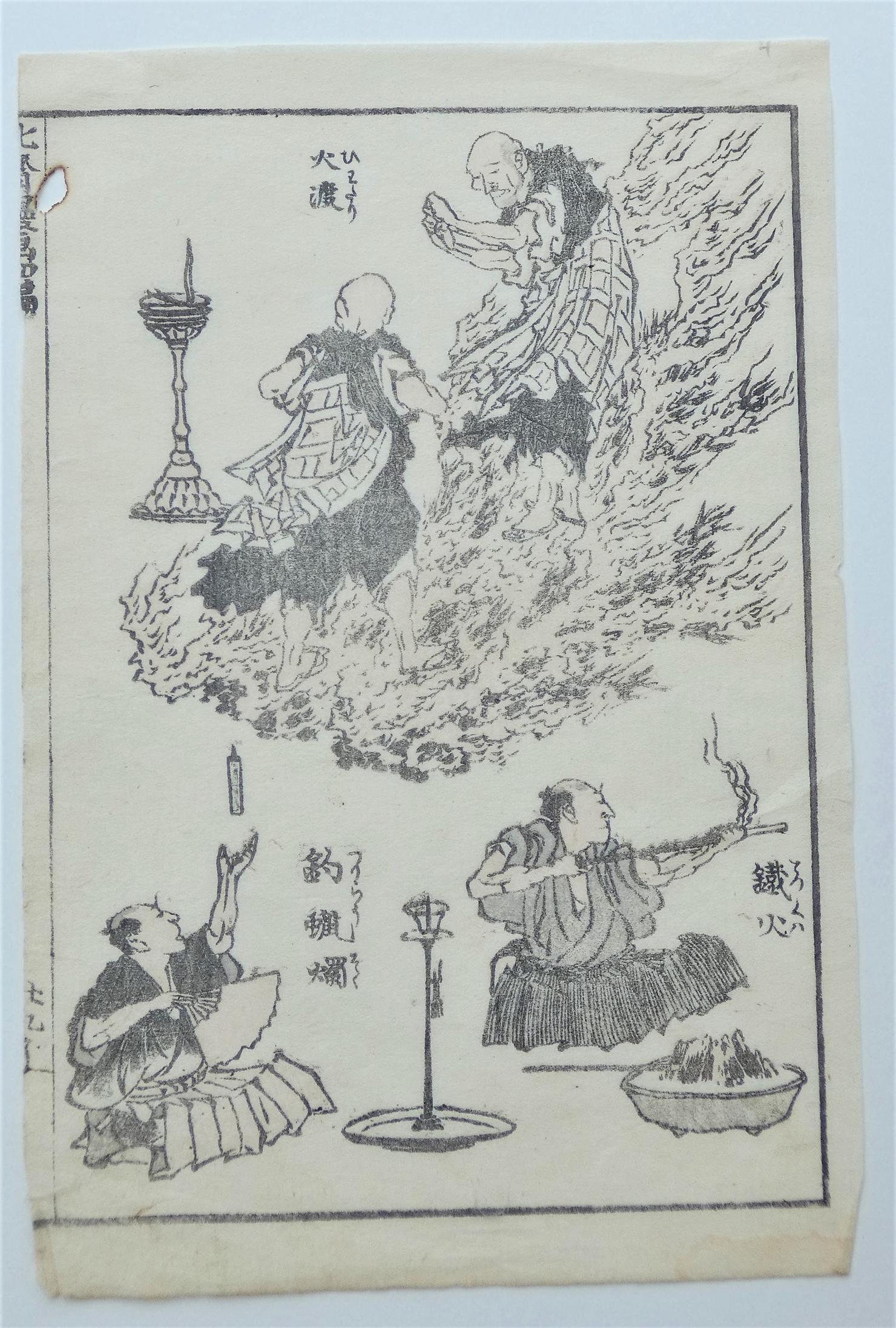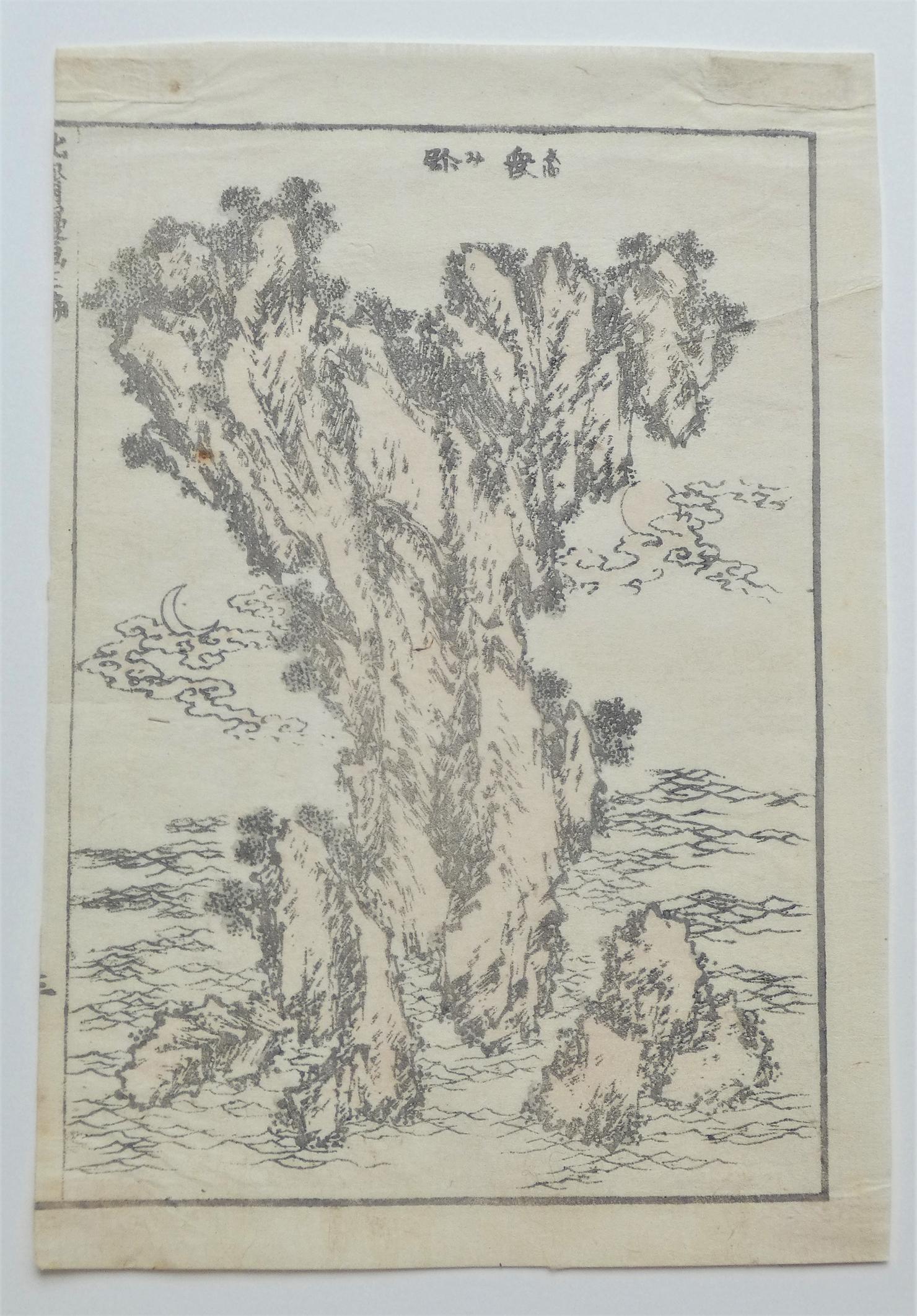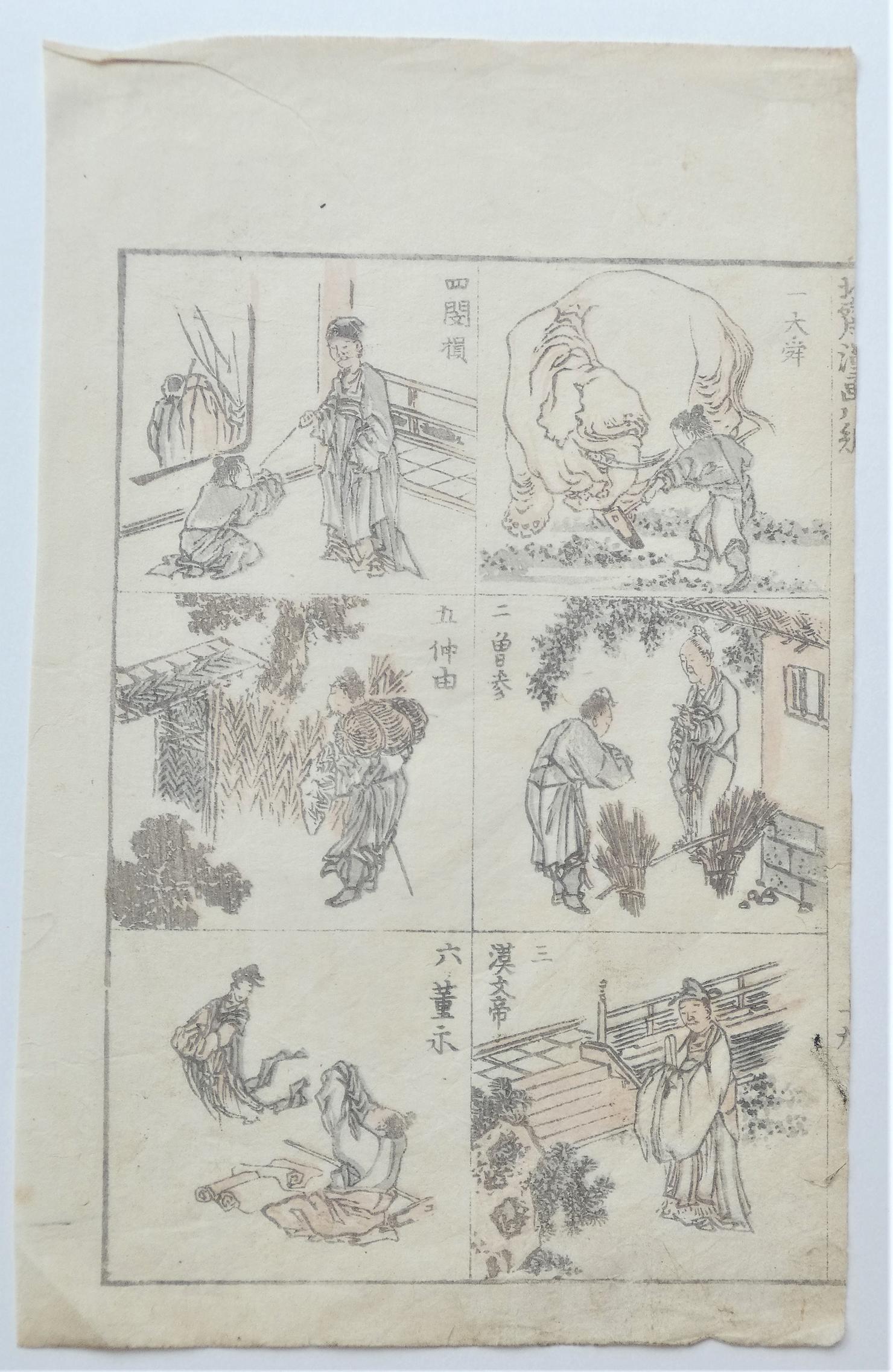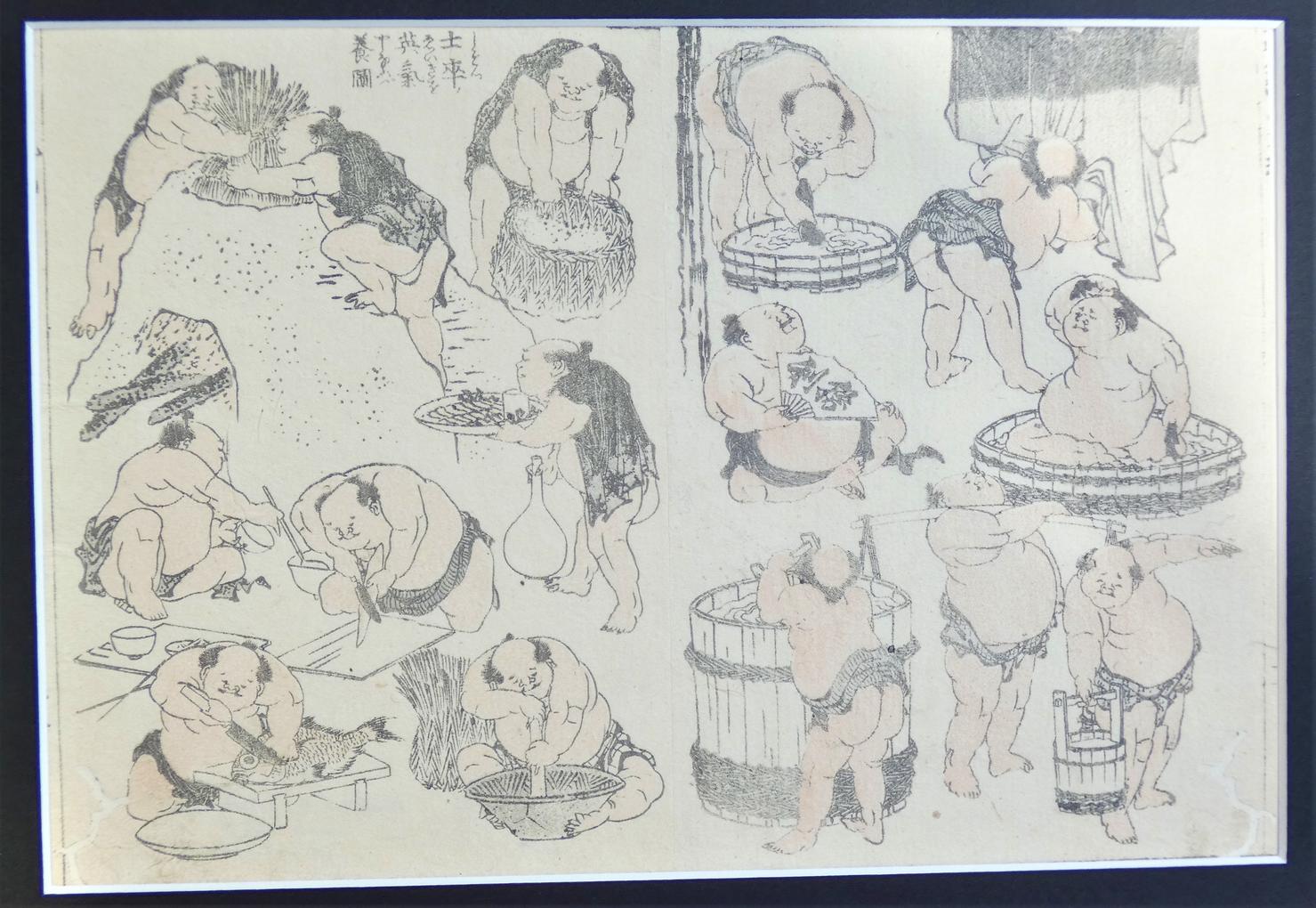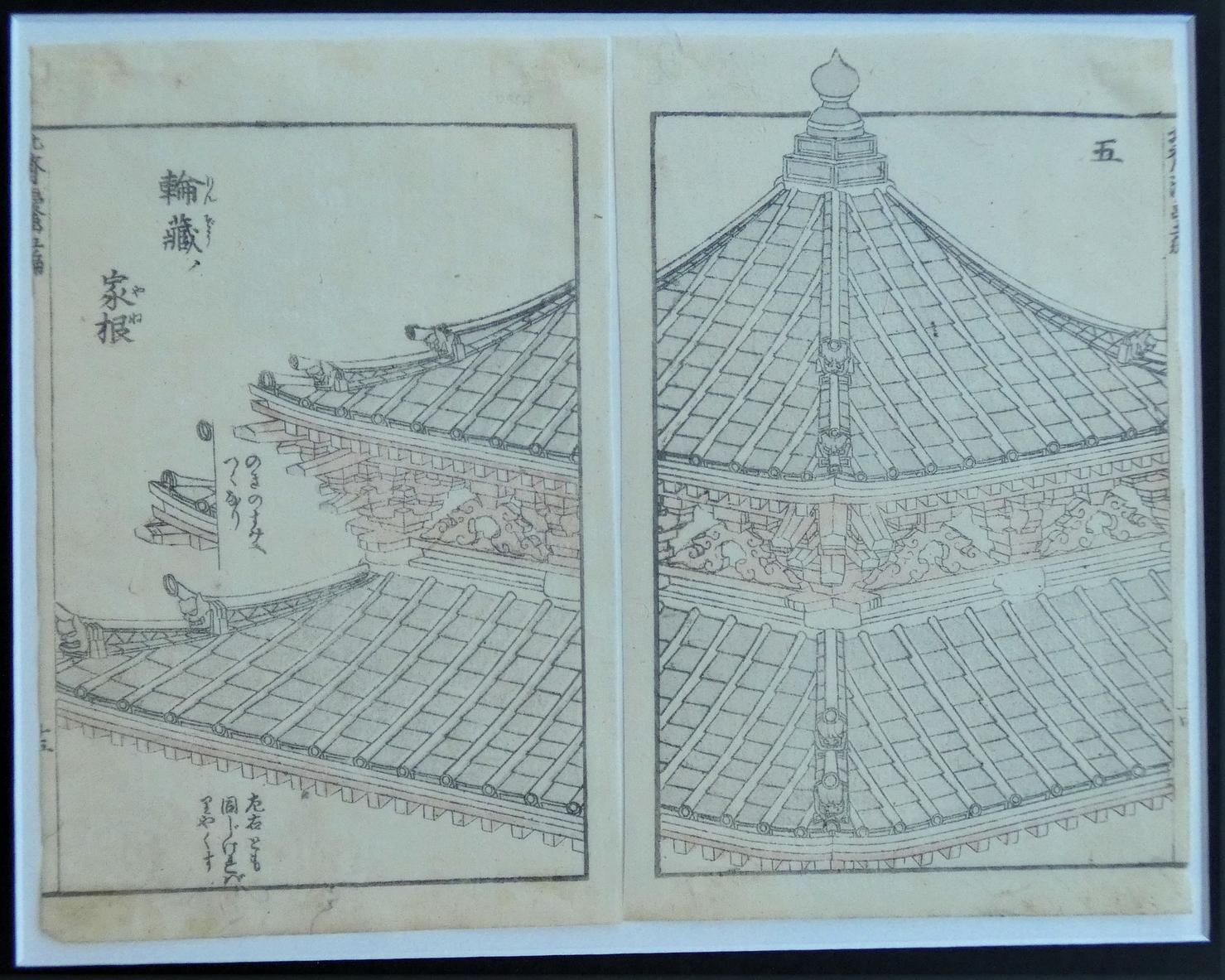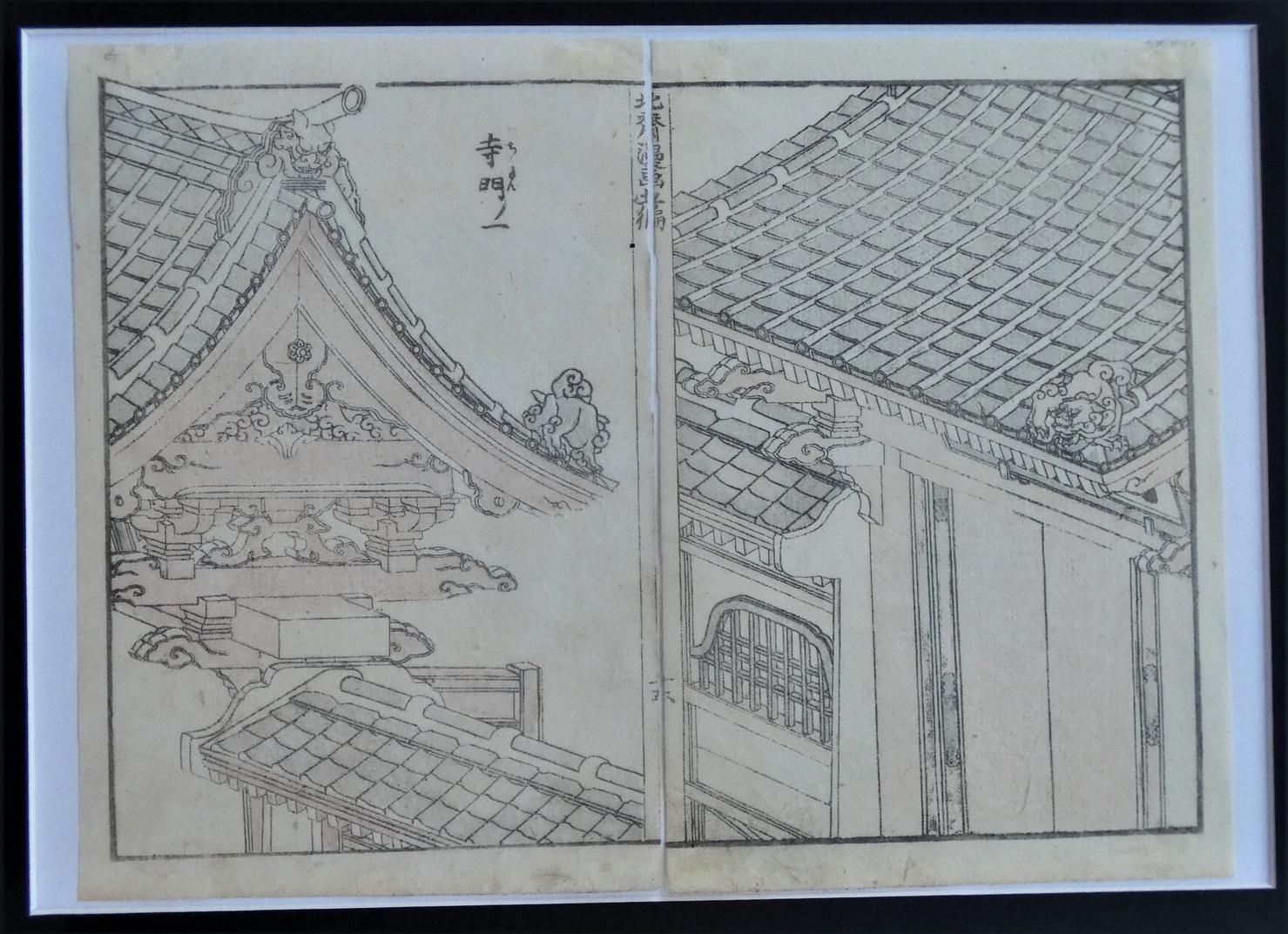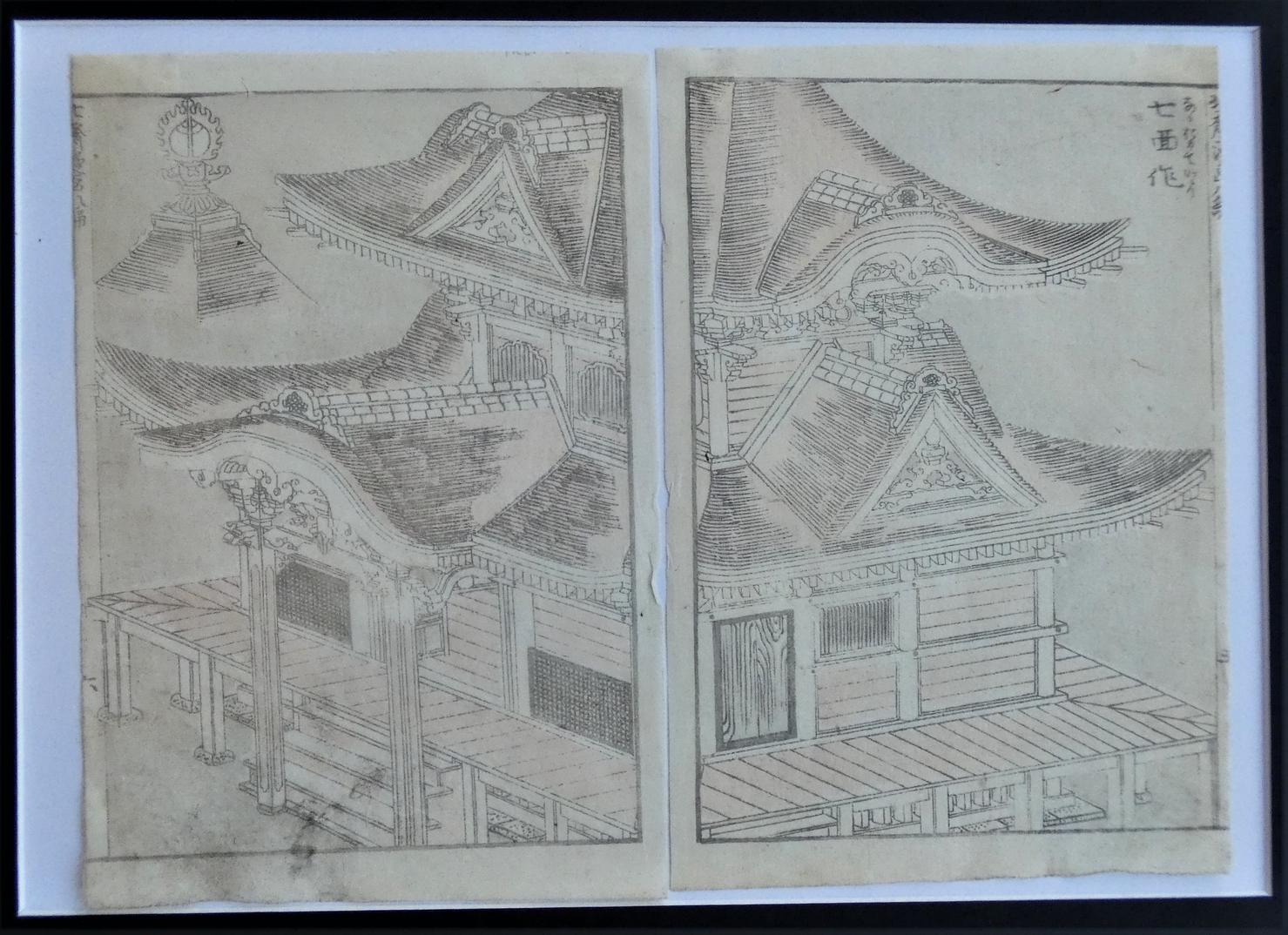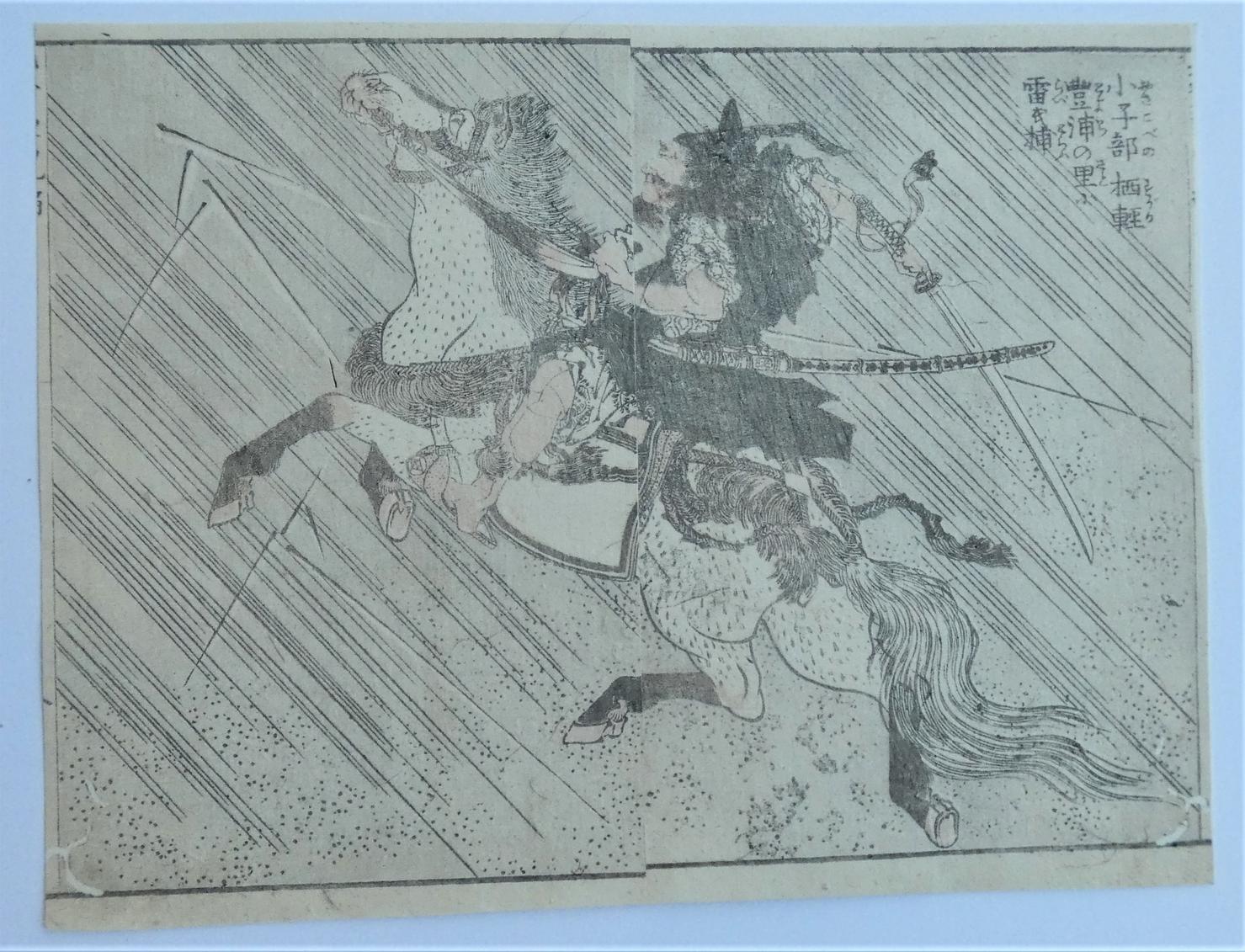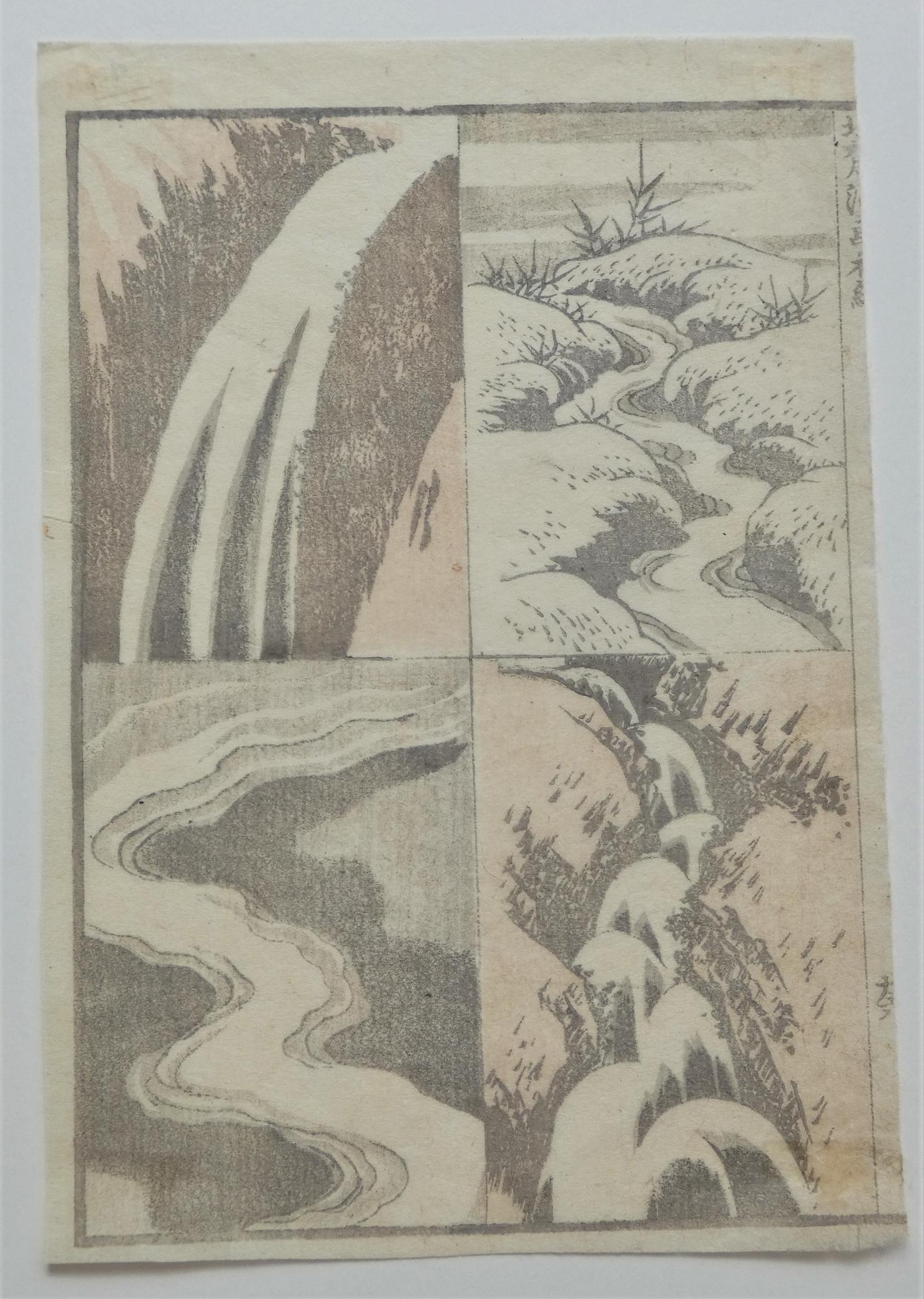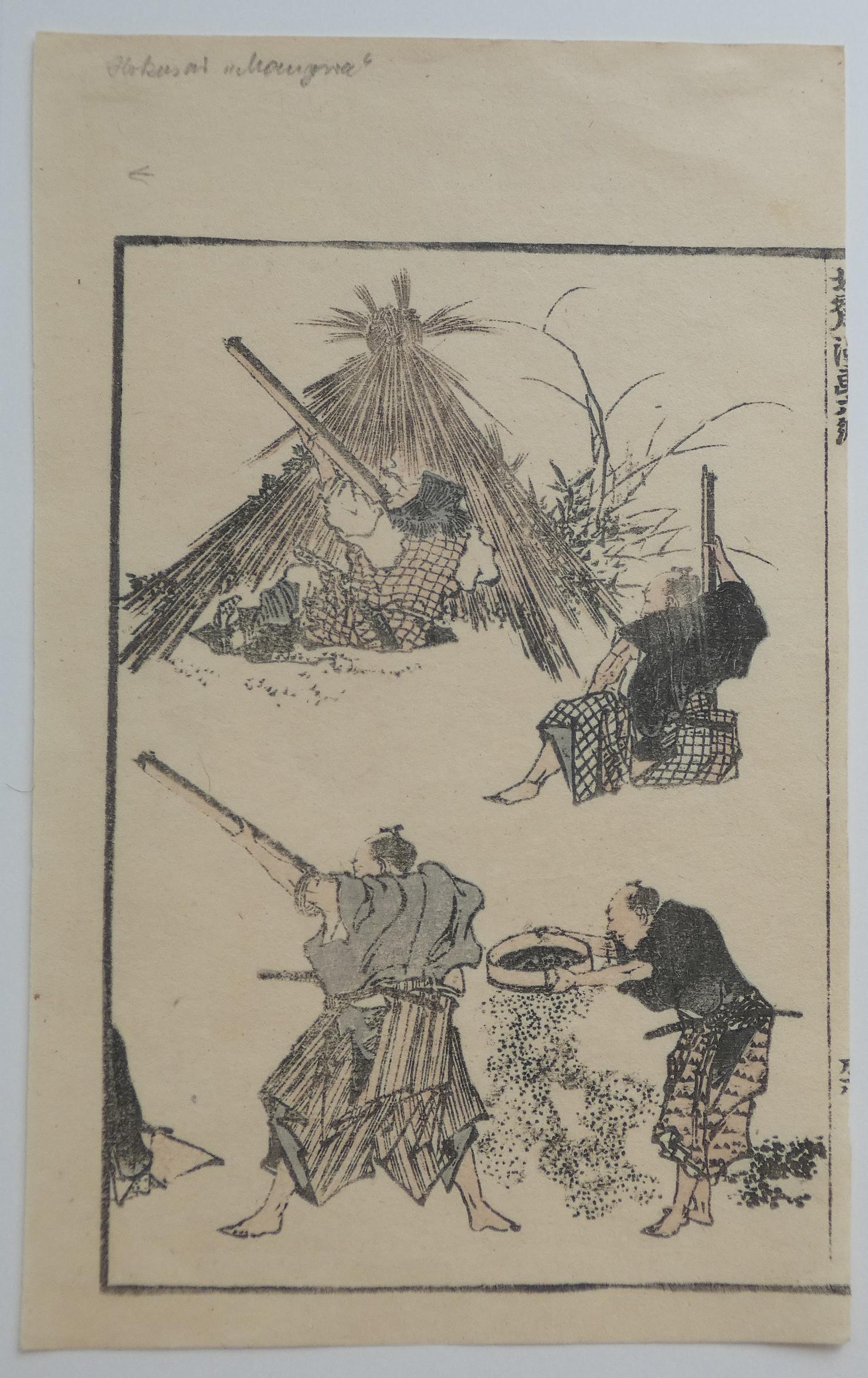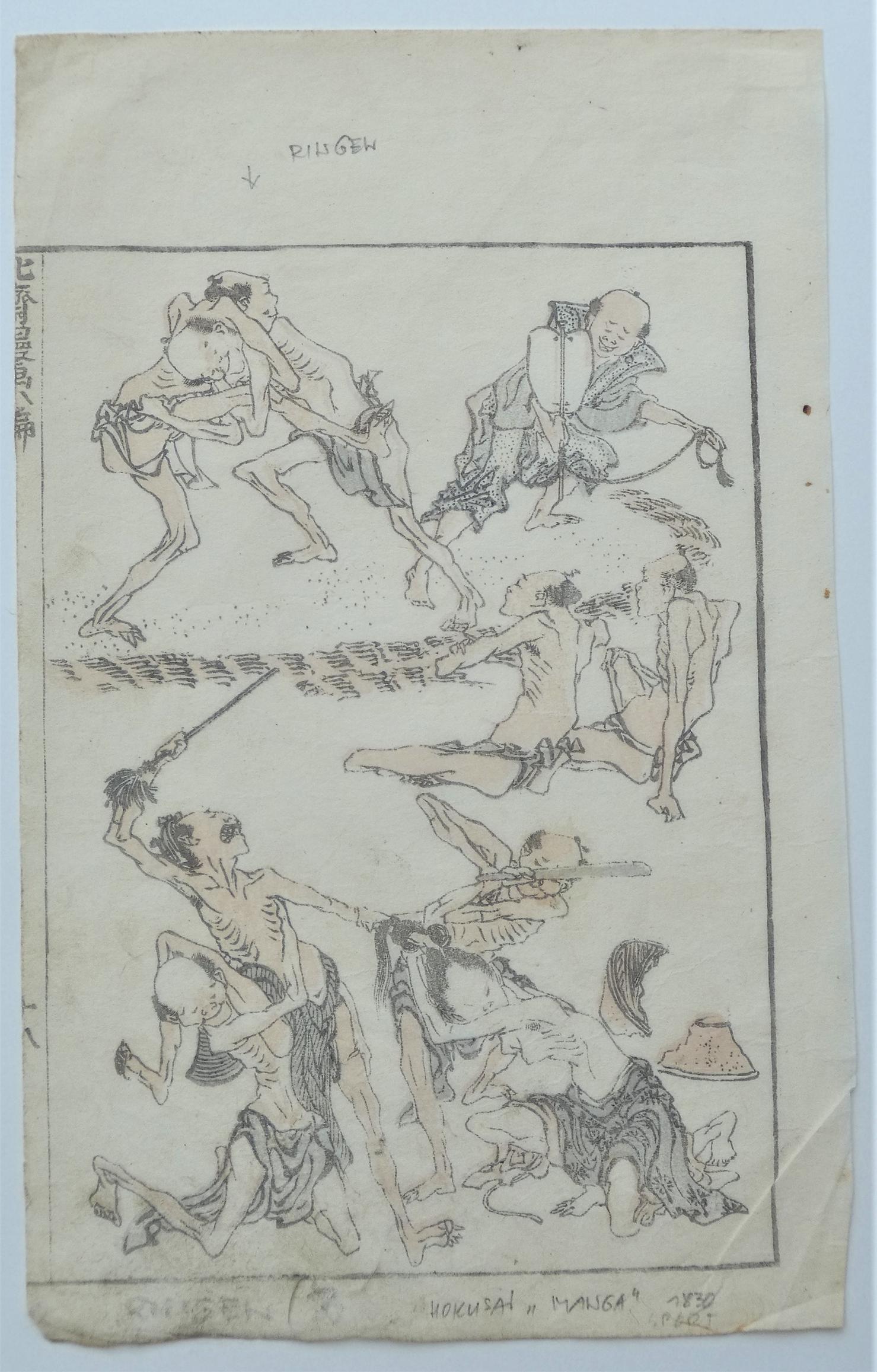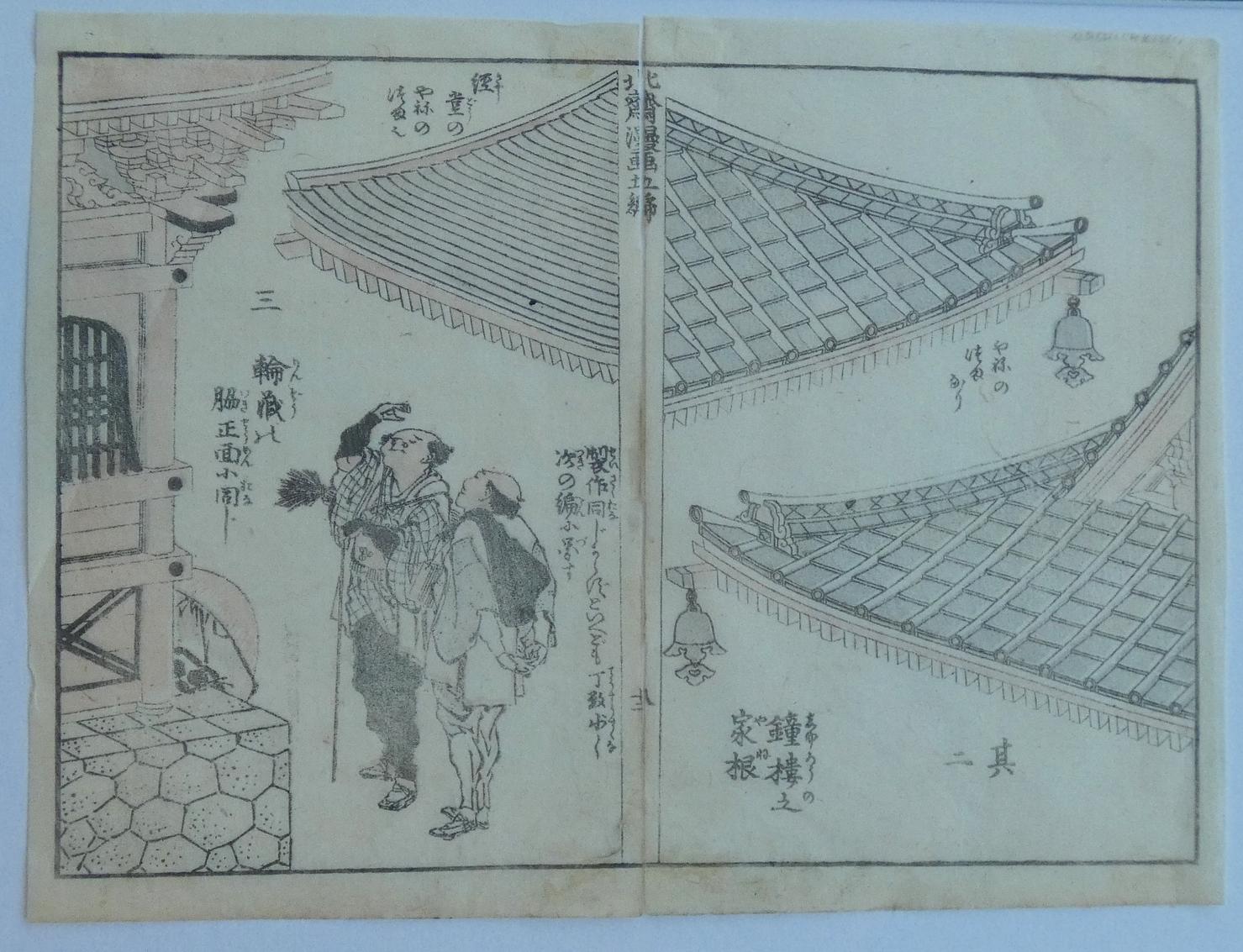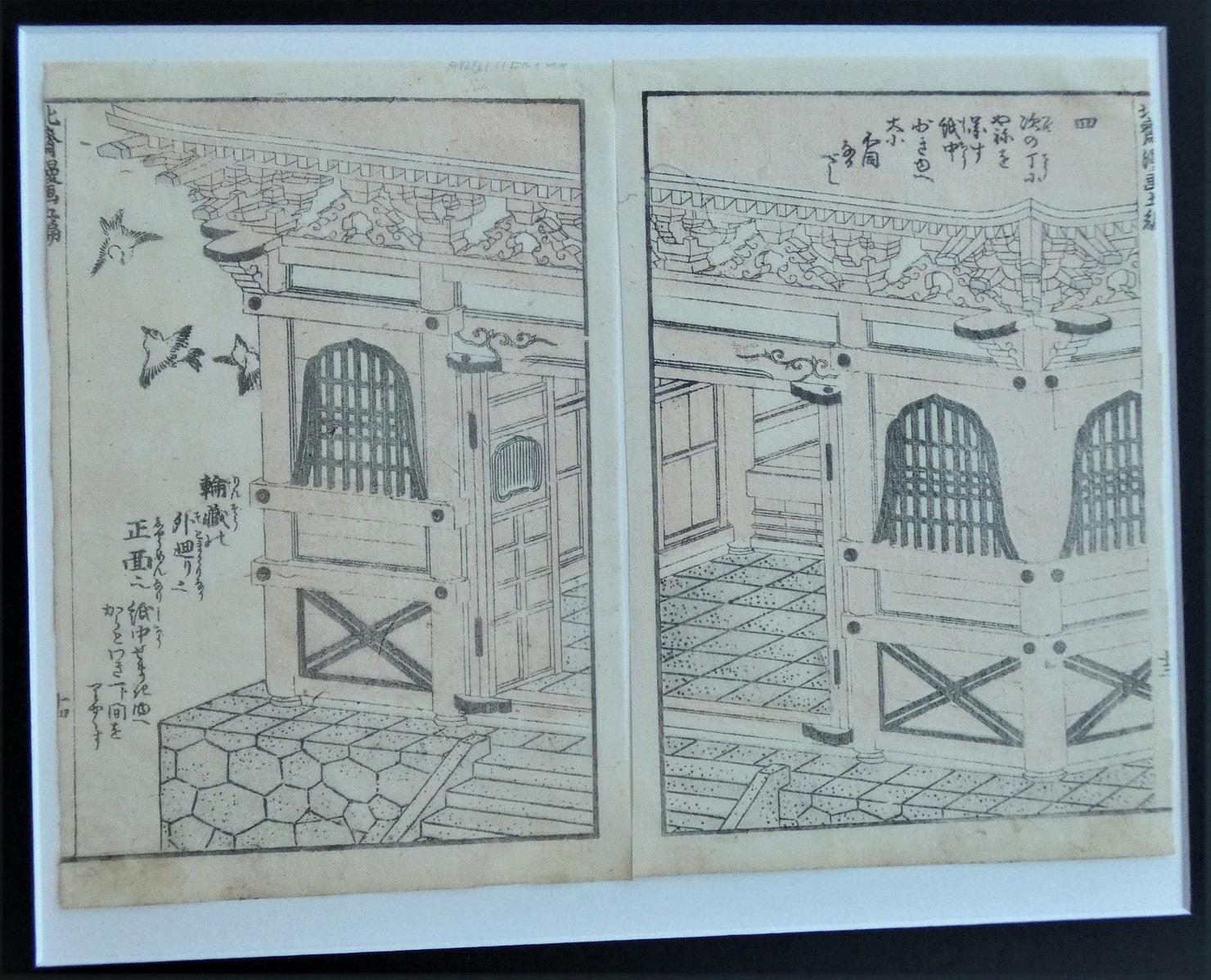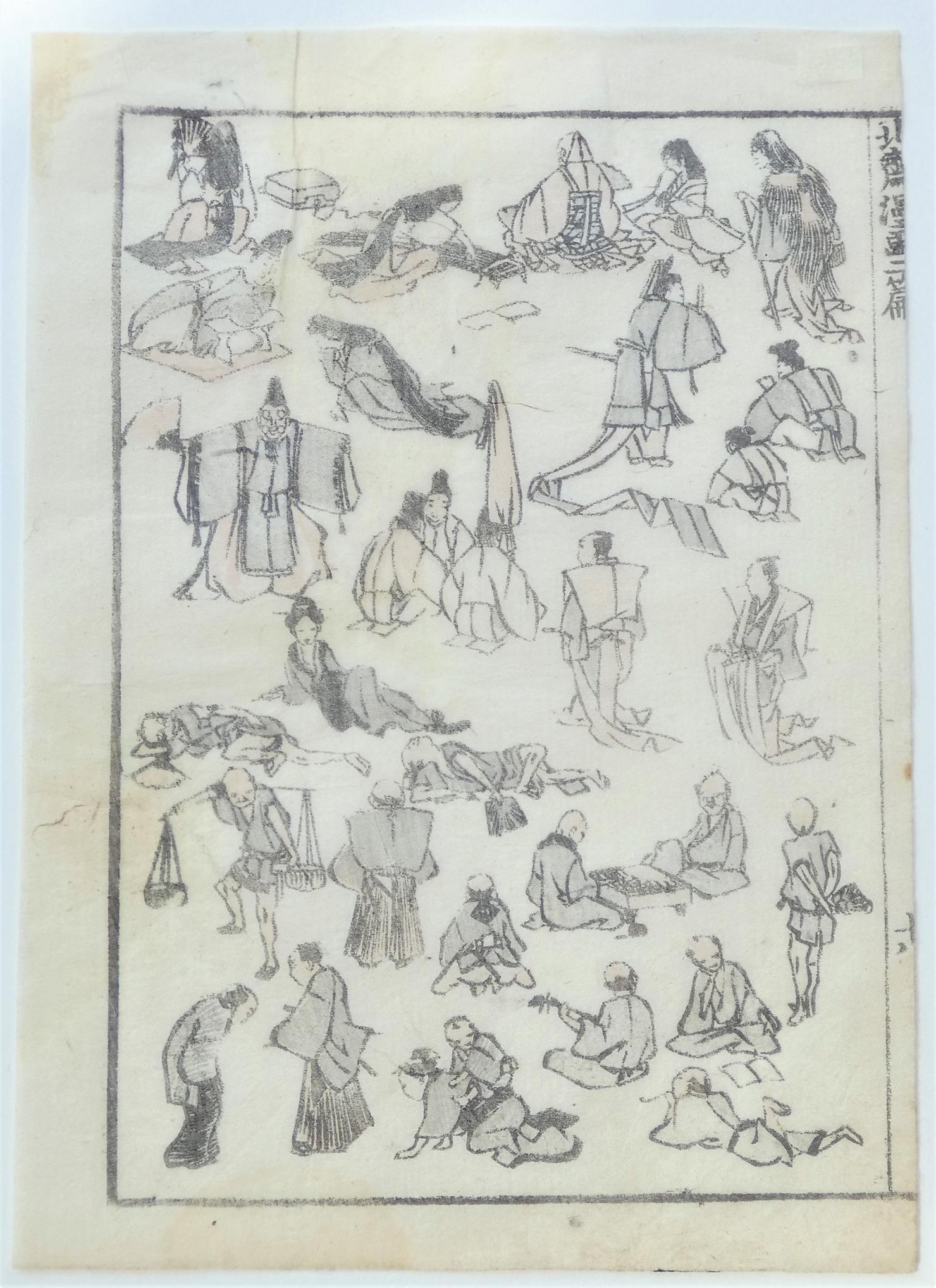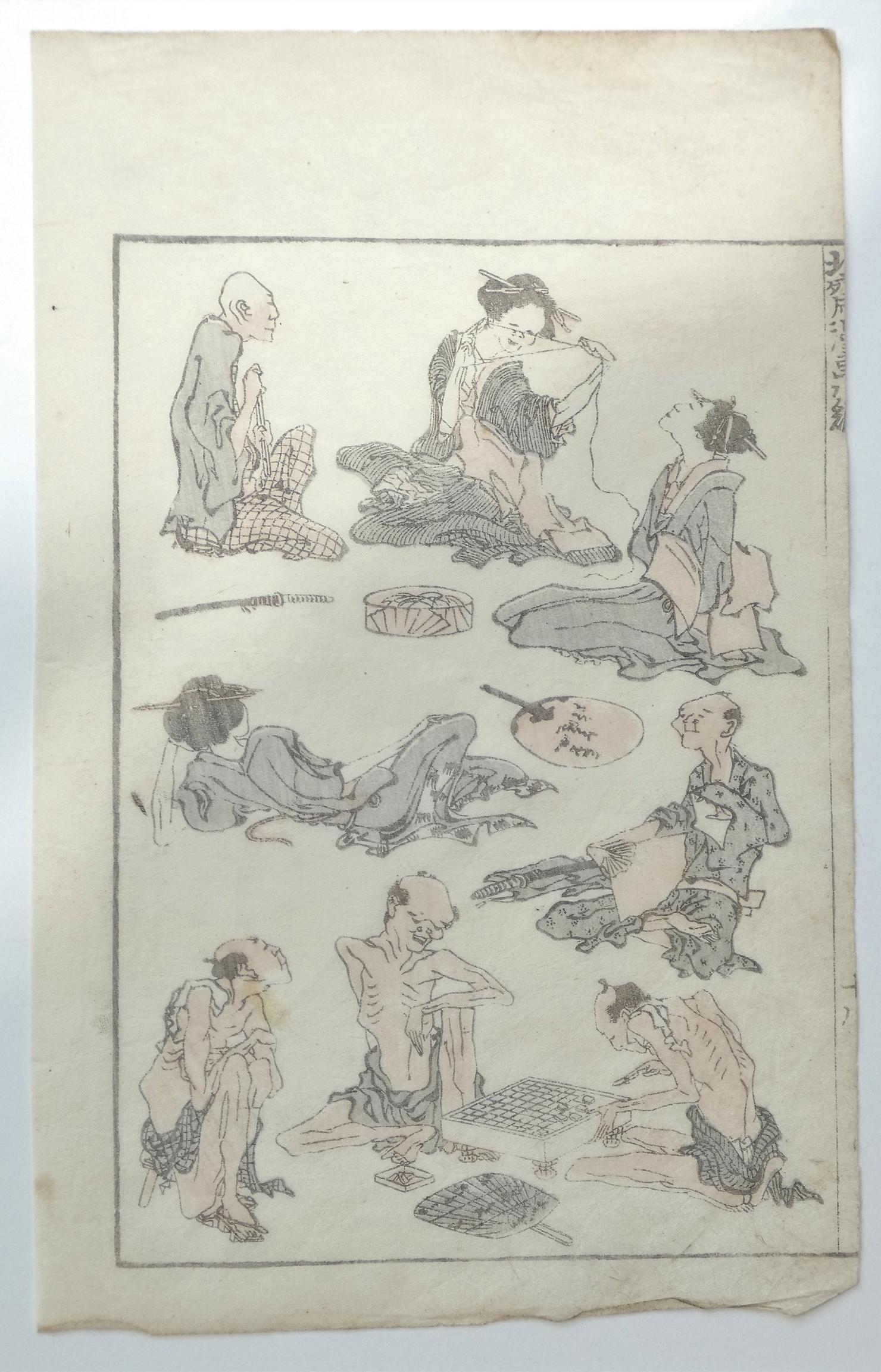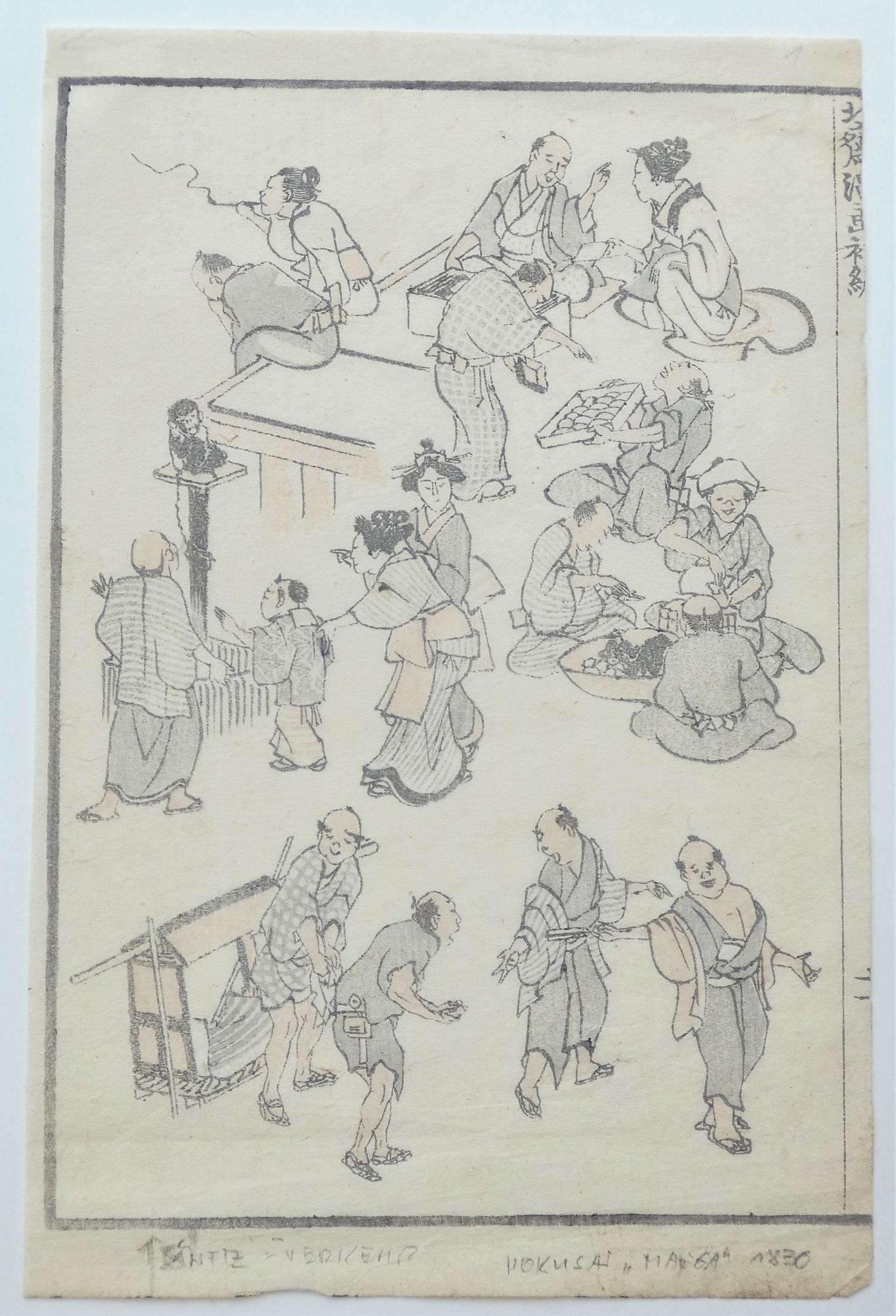Ihre Anfrage wurde erfolgreich gesendet.
Ihre E-Mail wurde erfolgreich gesendet.
Ihre Favoriten wurden erfolgreich versendet.

Japanische Holzschnitte von Katsushika Hokusai; Imao Keinen und Kunichika Toyohara
Begleitend zur Ausstellung "Made in Japan" im Kunstmuseum Basel, die vom 16.03. bis 21.07.2024 dauern wird;
Kunstmuseum Basel - Made in Japan – Kunstmuseum Basel
zeige ich in Riehen eine Auswahl von Werken der folgenden Künstler, die ebenfalls im Kunstmuseum Basel gezeigt werden:
Katsushika Hokusai machte den Begriff Manga (etwa zwangloses/ungezügeltes Bild) populär, der noch heute für japanische Comics verwendet wird. Seine Hokusai Mangas sind Skizzen, die zwischen 1814 und 1878 in insgesamt 15 Bänden veröffentlicht wurden (das letzte Heft erschien erst nach seinem Tod, 1878. Sie erzählen keine zusammenhängenden Geschichten, sondern stellen Momentaufnahmen der japanischen Gesellschaft und Kultur während der späten Edo-Zeit dar und bilden das gesamte Spektrum des menschlichen Lebens ab.
Es sei daran erinnert, dass die Technik der japanischen Drucke dem Original sehr nahe kommt, da sie die Zeichnung mit Tinte auf einem Stück Holz anbringen, das der Graveur ausgräbt, wobei er genau den Linien der Zeichnung folgt, die durch diesen Vorgang zerstört wurde.
Hokusai war sein ganzes Leben damit beschäftigt, sich künstlerisch weiterzuentwickeln. Am Ende seines Lebens beschrieb er sich stolz als „Landarbeiter“. Auf seinem Totenbett soll er gesagt haben: „Hätte der Himmel mir weitere fünf Jahre geschenkt, wäre ich ein großer Maler geworden.“
Die Hokusai-Manga (北斎漫画, "Hokusais Skizzen") sind eine Sammlung von Skizzen zu verschiedenen Themen des japanischen Künstlers Hokusai. Zu den Themen der Skizzen gehören Landschaften, Flora und Fauna, das tägliche Leben und das Übernatürliche.
Das Wort Manga im Titel bezieht sich nicht auf den zeitgenössischen Manga, der Geschichten erzählt, da die Skizzen in diesem Werk nicht miteinander verbunden sind. Während Manga im modernen Japanisch "Comics" bedeutet, wurde das Wort in der Edo-Periode für informelle Zeichnungen verwendet, möglicherweise für vorbereitende Skizzen für Gemälde.
Die Hokusai-Manga, die in drei Farben (schwarz, grau und helles Fleisch) im Blockdruckverfahren gedruckt wurden, umfassen Tausende von Bildern in zehn Bänden aus den Jahren 1814 bis 1819 und fünf weiteren Bänden aus den Jahren 1834 bis 1878. Der erste Band wurde im Jahr 1814 veröffentlicht, als der Künstler 55 Jahre alt war.
Die letzten drei Bände wurden posthum veröffentlicht, wobei zwei von ihnen von ihrem Verleger aus bisher unveröffentlichtem Material zusammengestellt wurden. Der letzte Band besteht aus bereits veröffentlichten Werken, von denen einige nicht einmal von Hokusai stammen, und wird von Kunsthistorikern als nicht authentisch angesehen.
Geschichte der Veröffentlichung
Das Vorwort zum ersten Band des Werks, das von Hanshū Sanjin (半洲散人), einem kleinen Künstler aus Nagoya, verfasst wurde, lässt vermuten, dass die Veröffentlichung des Werks möglicherweise von Hokusais Schülern unterstützt wurde. Ein Teil des Vorworts lautet:
In diesem Herbst besuchte der Meister [Hokusai] zufällig die Westprovinz und machte in unserer Stadt [Nagoya] Station. Wir alle trafen uns mit dem Maler Gekkōtei Bokusen (月光亭墨僊) [Utamasa II, bekannter Künstler aus Nagoya, Schüler von Hokusai und Sammler von Hokusais späteren Werken] in dessen Residenz, und es war ein sehr freudiger Anlass. Und dort wurden über dreihundert Skizzen aller Art angefertigt - von Unsterblichen, Buddhas, Gelehrten und Frauen bis hin zu Vögeln, Tieren, Gräsern und Bäumen, wobei der Geist eines jeden mit dem Pinsel vollständig eingefangen wurde.
Der letzte Band wird von einigen Kunsthistorikern als fälschlich angesehen.
Die Erstveröffentlichung wird gewöhnlich Eirakuya Toshiro (永楽屋東四郎) aus Nagoya zugeschrieben, dessen Verlag 1914 in Eito Shoten umbenannt wurde.
Quellen des Manga
Hokusai-Manga mit Darstellungen von Selbstverteidigungstechniken (frühes 19. Jahrhundert)
Nach traditioneller Auffassung wählte Hokusai nach dem Ausbruch der Produktion die Skizzen sorgfältig aus, überarbeitete sie und ordnete sie zu den Mustern an, die wir heute sehen. Michener (1958:30-34) argumentiert jedoch, dass das Muster der Bilder auf einer bestimmten Platte von den Holzschnitzern und Verlegern arrangiert wurde, nicht vom Künstler selbst.
Vermächtnis
Der erste Band von "Manga" (von Hokusai als "wildgewordener Pinsel" definiert) war ein Kunstlehrbuch, das er veröffentlichte, um seine angespannte finanzielle Lage zu verbessern. Kurze Zeit später entfernte er den Text und gab ihn neu heraus. Die Manga zeigen eine Hingabe an den künstlerischen Realismus in der Darstellung von Menschen und der natürlichen Welt. Das Werk war sofort ein Erfolg, und die Folgebände folgten bald. Im Westen wurde das Werk bekannt, nachdem der in den Niederlanden tätige deutsche Physiker Philipp Franz von Siebold Lithografien einiger der Skizzen nach Europa brachte, wo sie in seinem einflussreichen Buch über Japan, Nippon, erschienen: Archiv Zur Beschreibung von Japon im Jahr 1832. Das Werk begann bald nach Matthew C. Perrys Einreise nach Japan im Jahr 1854 im Westen zu zirkulieren.
Katsushika Hokusai nahm den Namen Hokusai um 1798 an, als er ungefähr 39 Jahre alt war. Dieser Name leitet sich von zwei Wörtern ab: „Hoku“, was „Norden“ bedeutet, und „sai“, was sich auf eine dem Buddha dargebrachte Mahlzeit bezieht. Diese Namensänderung fällt mit einer wichtigen Übergangsphase in seiner künstlerischen Karriere zusammen, die von der Suche nach einem eigenen Stil und der Auseinandersetzung mit verschiedenen Techniken und künstlerischen Einflüssen geprägt war. Unter diesem neuen Namen wurde Hokusai zu einem der berühmtesten Künstler Japans und produzierte einige seiner bekanntesten Werke, darunter die Serie „Sechsunddreißig Ansichten des Berges Fuji“.
Zitat: „Mit 73 habe ich die Struktur der realen Natur, Tiere, Gräser, Bäume, Vögel, Fische und Insekten grob verstanden. Deshalb werde ich mit 80 noch mehr Fortschritte gemacht haben; mit 90 werde ich das Mysterium der Dinge durchdringen ; mit 100 werde ich sicherlich wunderbar geworden sein, und mit 110 wird jeder Punkt, jede Linie ein Eigenleben haben".
Kunichiko Toyohara: Toyohara Kunichika (japanisch 豊原 国周, eigentlicher Name: Arakawa Yasohachi (荒川 八十八), geb. 30. Juni 1835 in Edo; gest. 1. Juli 1900) führte die Künstlernamen Beiō (米翁), Hōshunrō (豊春楼), Ichiōsai (一鶯斎), Kachōrō (華蝶楼), Shima Sanjin (志満山人) und Sōgenshi (豊玄子). Er war ein japanischer Maler im Ukiyoe-Stil während der Meiji-Zeit und gehörte, zusammen mit Tsukioka Yoshitoshi und Kobayashi Kiyochika, zu den „Drei Herausragenden [Künstlern]“ (三傑, Sanketsu) ihrer Stilrichtung am Ende des 19. Jahrhunderts.
Toyohara wurde in Edo als Sohn eines Badehaus-Betreibers im Stadtteil Kyobashi geboren. Er war zunächst Schüler von Toyohara Chikanobu (豊原 周延; 1838–1912), dessen Familiennamen er annahm. Dort bemalte er Rückseiten von Federballschlägern (羽子板, Hago-ita). Um 1848 lernte er bei Utagawa Kunisada und malte unter dem Namen Yasohachi Partien der Schauspieler seines Meisters. Ab 1855 gestaltete er unter dem Namen Ichōsai Kunichika Drucke schöner Frauen, Drucke zur Geschichte vom Prinzen Genji und andere Themen.
1869 brachte er eine Serie von 22 Blättern mit Schauspielern heraus, die vom Verlag Gusokuya (具足屋) gedruckt worden waren. Dabei füllte der groß dargestellte Kopf des Dargestellten das Blatt noch mehr aus, als es bei traditionellen Ōkubi-e (大首絵) der Fall war, so dass man vom Ōgao-e (大顔絵) sprechen kann. In diesem Stil produzierte Kunichika mit Kunisada in späteren Jahren Serien von Schauspielern bei Kinshōdō (絹昇堂), die die Drucke des älteren Utagawa Yoshitora in den Schatten stellten und ihn zum Führenden in diesem Genre machten.
1870 kam eine Serie von Drucken zum Ōhashiya (大橋屋) heraus, und zwar als Zweiblatt- oder Dreiblatt-Drucke, wieder als Ōgao-e. In diesen Jahren war Kunichika damit außerordentlich populär: Mit seinen ausdrucksstarken Darstellungen galt er als der „Sharaku der Meiji-Zeit“.
Kunichika war ein typisches Edokko: Er gab das Geld so schnell aus, wie er es verdiente, und war dem Sake sehr zugetan. Er hauste in Nagaya (長屋), also einfachsten Baracken, soll 103-mal umgezogen sein und nacheinander vierzig verschiedene Frauen gehabt haben. Bei all dem Lebenswandel gehörte er zu den Letzten, die erfolgreich Ukiyo-e in traditioneller Art schufen.
Imao Keinen: Imao Keinen wurde als dritter Sohn des Imao Inosuke (今尾 猪助) geboren. Die Familie betrieb ein Geschäft mit dem Namen Iseya (伊勢谷) und stand in freundschaftlicher Verbindung zum Kleidergeschäft der Mitsui-Familie. Zunächst hatte Keinen Vorzeichnungen für eine Art Schablonendruck auf Textilien, für das Yūsen-some[A 1] entworfen. Mit 11 Jahren wurde er Schüler des Ukiyo-e-Künstlers Umegawa Tōkyo (梅川東居), der seinerseits bei Umegawa Tōnan (梅川東南) gelernt hatte, der sich anscheinend mit dem Kupferstich befasst hatte. Drei Jahre später bildete Keinen sich unter Suzuki Hyakunen (1828–1891) weiter, der ihm den Stil der Maruyama-Shijō-Schule vermittelte. Keinen übernahm dann das nen von Hyakunen und das kei von dem von ihm verehrten Matsumura Keibun.
Keinen setzte sich mit verschiedenen Stilrichtungen auseinander, befasste sich dann vor allem mit dem klassischen Blumen-und-Vögel-Thema (花鳥画, Kachō-ga), wobei er sich zum führenden Vertreter der eher konservativen Malerei entwickelte. 1895 wurde sein Bild Yabakei „耶馬渓図“ auf der 4. „Ausstellung zur Förderung des inländischen Handels und der Industrie“ (内国勧業博覧会, Kokunai kangyō hakurankai) ausgezeichnet.
Zusammen mit Suzuki Shōnen (鈴木松年; 1848–1918), Sohn Hyakunens, nahm Keinen eine führende Position in Künstlerkreisen Kyōtos ein. 1895 war er Mitbegründer der „如雲社“ (Nyounsha), der späteren „京都後素協会“ (Kyōto kōso kyōkai), deren Vorsitzender er wurde. 1919 wurde er Mitglied der Kaiserlichen Akademie der Künste (帝国術術院, Teikoku Geijutsuin). 1891 erschienen vier Bände mit dem Titel „景年花鳥画譜“ (Keinen kachō gafu, Bildersammlung von Blumen und Vögeln des Keinen). Keinen war auch auf der Weltausstellung Paris 1889 und der World’s Columbian Exposition in Chicago 1893 zu sehen.
The word manga in the title does not refer to the contemporary story-telling manga, as the sketches in the work are not connected to each other. While manga has come to mean "comics" in modern Japanese, the word was used in the Edo period to mean informal drawings, possibly preparatory sketches for paintings.
Block-printed in three colours (black, gray and pale flesh), the Hokusai Manga comprises thousands of images in ten volumes from 1814 to 1819, with five volumes added in 1834 to 1878. The first volume was published in 1814, when the artist was 55.
The final three volumes were published posthumously, two of them assembled by their publisher from previously unpublished material. The final volume was made up of previously published works, some not even by Hokusai, and is not considered authentic by art historians.
Publication history
The preface to the first volume of the work, written by Hanshū Sanjin (半洲散人), a minor artist of Nagoya, suggests that the publication of the work may have been aided by Hokusai's pupils. Part of the preface reads:
This autumn the master [Hokusai] happened to visit the Western Province and stopped over at our city [Nagoya]. We all met together with the painter Gekkōtei Bokusen (月光亭墨僊) [Utamasa II, well-known Nagoya artist, pupil of Hokusai’s, and collator of Hokusai’s later work] at the latter’s residence, it being a very joyous occasion. And there over three hundred sketches of all kinds were made – from immortals, Buddhas, scholars, and women on down to birds, beasts, grasses, and trees, the spirit of each captured fully by the brush.
The final volume is considered spurious by some art historians.
The initial publication is usually credited to Eirakuya Toshiro (永楽屋東四郎) of Nagoya[5] whose publishing house was renamed to Eito Shoten in 1914.
Sources of the Manga
Hokusai Manga depicting self-defense techniques (early 19th century)
The traditional view holds that, after the outburst of production, Hokusai carefully selected and redrew the sketches, arranging them into the patterns we see today. However, Michener (1958:30-34) argues that the pattern of the images on a particular plate were arranged by the wood carvers and publishers, not by the artist himself.
Legacy
The first volume of 'Manga' (Defined by Hokusai as 'Brush gone wild'), was an art instruction book published to aid his troubled finances. Shortly after he removed the text and republished it. The Manga show a dedication to artistic realism in the portrayal of people and the natural world. The work was an immediate success, and the subsequent volumes soon followed. The work became known to the West after Dutch-employed German physicist Philipp Franz von Siebold took lithographs of some of the sketches to Europe where they appeared in his influential book on Japan,[1] Nippon: Archiv Zur Beschreibung von Japon in 1832. The work began to circulate in the West soon after Matthew C. Perry's entry into Japan in 1854.
The word manga in the title does not refer to the contemporary story-telling manga, as the sketches in the work are not connected to each other. While manga has come to mean "comics" in modern Japanese, the word was used in the Edo period to mean informal drawings, possibly preparatory sketches for paintings.
Block-printed in three colours (black, gray and pale flesh), the Hokusai Manga comprises thousands of images in ten volumes from 1814 to 1819, with five volumes added in 1834 to 1878. The first volume was published in 1814, when the artist was 55.
The final three volumes were published posthumously, two of them assembled by their publisher from previously unpublished material. The final volume was made up of previously published works, some not even by Hokusai, and is not considered authentic by art historians.
Publication history
The preface to the first volume of the work, written by Hanshū Sanjin (半洲散人), a minor artist of Nagoya, suggests that the publication of the work may have been aided by Hokusai's pupils. Part of the preface reads:
This autumn the master [Hokusai] happened to visit the Western Province and stopped over at our city [Nagoya]. We all met together with the painter Gekkōtei Bokusen (月光亭墨僊) [Utamasa II, well-known Nagoya artist, pupil of Hokusai’s, and collator of Hokusai’s later work] at the latter’s residence, it being a very joyous occasion. And there over three hundred sketches of all kinds were made – from immortals, Buddhas, scholars, and women on down to birds, beasts, grasses, and trees, the spirit of each captured fully by the brush.
The final volume is considered spurious by some art historians.
The initial publication is usually credited to Eirakuya Toshiro (永楽屋東四郎) of Nagoya[5] whose publishing house was renamed to Eito Shoten in 1914.
Sources of the Manga
Hokusai Manga depicting self-defense techniques (early 19th century)
The traditional view holds that, after the outburst of production, Hokusai carefully selected and redrew the sketches, arranging them into the patterns we see today. However, Michener (1958:30-34) argues that the pattern of the images on a particular plate were arranged by the wood carvers and publishers, not by the artist himself.
Legacy
The first volume of 'Manga' (Defined by Hokusai as 'Brush gone wild'), was an art instruction book published to aid his troubled finances. Shortly after he removed the text and republished it. The Manga show a dedication to artistic realism in the portrayal of people and the natural world. The work was an immediate success, and the subsequent volumes soon followed. The work became known to the West after Dutch-employed German physicist Philipp Franz von Siebold took lithographs of some of the sketches to Europe where they appeared in his influential book on Japan,[1] Nippon: Archiv Zur Beschreibung von Japon in 1832. The work began to circulate in the West soon after Matthew C. Perry's entry into Japan in 1854.
The word manga in the title does not refer to the contemporary story-telling manga, as the sketches in the work are not connected to each other. While manga has come to mean "comics" in modern Japanese, the word was used in the Edo period to mean informal drawings, possibly preparatory sketches for paintings.
Block-printed in three colours (black, gray and pale flesh), the Hokusai Manga comprises thousands of images in ten volumes from 1814 to 1819, with five volumes added in 1834 to 1878. The first volume was published in 1814, when the artist was 55.
The final three volumes were published posthumously, two of them assembled by their publisher from previously unpublished material. The final volume was made up of previously published works, some not even by Hokusai, and is not considered authentic by art historians.
Publication history
The preface to the first volume of the work, written by Hanshū Sanjin (半洲散人), a minor artist of Nagoya, suggests that the publication of the work may have been aided by Hokusai's pupils. Part of the preface reads:
This autumn the master [Hokusai] happened to visit the Western Province and stopped over at our city [Nagoya]. We all met together with the painter Gekkōtei Bokusen (月光亭墨僊) [Utamasa II, well-known Nagoya artist, pupil of Hokusai’s, and collator of Hokusai’s later work] at the latter’s residence, it being a very joyous occasion. And there over three hundred sketches of all kinds were made – from immortals, Buddhas, scholars, and women on down to birds, beasts, grasses, and trees, the spirit of each captured fully by the brush.
The final volume is considered spurious by some art historians.
The initial publication is usually credited to Eirakuya Toshiro (永楽屋東四郎) of Nagoya[5] whose publishing house was renamed to Eito Shoten in 1914.
Sources of the Manga
Hokusai Manga depicting self-defense techniques (early 19th century)
The traditional view holds that, after the outburst of production, Hokusai carefully selected and redrew the sketches, arranging them into the patterns we see today. However, Michener (1958:30-34) argues that the pattern of the images on a particular plate were arranged by the wood carvers and publishers, not by the artist himself.
Legacy
The first volume of 'Manga' (Defined by Hokusai as 'Brush gone wild'), was an art instruction book published to aid his troubled finances. Shortly after he removed the text and republished it. The Manga show a dedication to artistic realism in the portrayal of people and the natural world. The work was an immediate success, and the subsequent volumes soon followed. The work became known to the West after Dutch-employed German physicist Philipp Franz von Siebold took lithographs of some of the sketches to Europe where they appeared in his influential book on Japan,[1] Nippon: Archiv Zur Beschreibung von Japon in 1832. The work began to circulate in the West soon after Matthew C. Perry's entry into Japan in 1854.
The word manga in the title does not refer to the contemporary story-telling manga, as the sketches in the work are not connected to each other. While manga has come to mean "comics" in modern Japanese, the word was used in the Edo period to mean informal drawings, possibly preparatory sketches for paintings.
Block-printed in three colours (black, gray and pale flesh), the Hokusai Manga comprises thousands of images in ten volumes from 1814 to 1819, with five volumes added in 1834 to 1878. The first volume was published in 1814, when the artist was 55.
The final three volumes were published posthumously, two of them assembled by their publisher from previously unpublished material. The final volume was made up of previously published works, some not even by Hokusai, and is not considered authentic by art historians.
Publication history
The preface to the first volume of the work, written by Hanshū Sanjin (半洲散人), a minor artist of Nagoya, suggests that the publication of the work may have been aided by Hokusai's pupils. Part of the preface reads:
This autumn the master [Hokusai] happened to visit the Western Province and stopped over at our city [Nagoya]. We all met together with the painter Gekkōtei Bokusen (月光亭墨僊) [Utamasa II, well-known Nagoya artist, pupil of Hokusai’s, and collator of Hokusai’s later work] at the latter’s residence, it being a very joyous occasion. And there over three hundred sketches of all kinds were made – from immortals, Buddhas, scholars, and women on down to birds, beasts, grasses, and trees, the spirit of each captured fully by the brush.
The final volume is considered spurious by some art historians.
The initial publication is usually credited to Eirakuya Toshiro (永楽屋東四郎) of Nagoya[5] whose publishing house was renamed to Eito Shoten in 1914.
Sources of the Manga
Hokusai Manga depicting self-defense techniques (early 19th century)
The traditional view holds that, after the outburst of production, Hokusai carefully selected and redrew the sketches, arranging them into the patterns we see today. However, Michener (1958:30-34) argues that the pattern of the images on a particular plate were arranged by the wood carvers and publishers, not by the artist himself.
Legacy
The first volume of 'Manga' (Defined by Hokusai as 'Brush gone wild'), was an art instruction book published to aid his troubled finances. Shortly after he removed the text and republished it. The Manga show a dedication to artistic realism in the portrayal of people and the natural world. The work was an immediate success, and the subsequent volumes soon followed. The work became known to the West after Dutch-employed German physicist Philipp Franz von Siebold took lithographs of some of the sketches to Europe where they appeared in his influential book on Japan,[1] Nippon: Archiv Zur Beschreibung von Japon in 1832. The work began to circulate in the West soon after Matthew C. Perry's entry into Japan in 1854.
The word manga in the title does not refer to the contemporary story-telling manga, as the sketches in the work are not connected to each other. While manga has come to mean "comics" in modern Japanese, the word was used in the Edo period to mean informal drawings, possibly preparatory sketches for paintings.
Block-printed in three colours (black, gray and pale flesh), the Hokusai Manga comprises thousands of images in ten volumes from 1814 to 1819, with five volumes added in 1834 to 1878. The first volume was published in 1814, when the artist was 55.
The final three volumes were published posthumously, two of them assembled by their publisher from previously unpublished material. The final volume was made up of previously published works, some not even by Hokusai, and is not considered authentic by art historians.
Publication history
The preface to the first volume of the work, written by Hanshū Sanjin (半洲散人), a minor artist of Nagoya, suggests that the publication of the work may have been aided by Hokusai's pupils. Part of the preface reads:
This autumn the master [Hokusai] happened to visit the Western Province and stopped over at our city [Nagoya]. We all met together with the painter Gekkōtei Bokusen (月光亭墨僊) [Utamasa II, well-known Nagoya artist, pupil of Hokusai’s, and collator of Hokusai’s later work] at the latter’s residence, it being a very joyous occasion. And there over three hundred sketches of all kinds were made – from immortals, Buddhas, scholars, and women on down to birds, beasts, grasses, and trees, the spirit of each captured fully by the brush.
The final volume is considered spurious by some art historians.
The initial publication is usually credited to Eirakuya Toshiro (永楽屋東四郎) of Nagoya[5] whose publishing house was renamed to Eito Shoten in 1914.
Sources of the Manga
Hokusai Manga depicting self-defense techniques (early 19th century)
The traditional view holds that, after the outburst of production, Hokusai carefully selected and redrew the sketches, arranging them into the patterns we see today. However, Michener (1958:30-34) argues that the pattern of the images on a particular plate were arranged by the wood carvers and publishers, not by the artist himself.
Legacy
The first volume of 'Manga' (Defined by Hokusai as 'Brush gone wild'), was an art instruction book published to aid his troubled finances. Shortly after he removed the text and republished it. The Manga show a dedication to artistic realism in the portrayal of people and the natural world. The work was an immediate success, and the subsequent volumes soon followed. The work became known to the West after Dutch-employed German physicist Philipp Franz von Siebold took lithographs of some of the sketches to Europe where they appeared in his influential book on Japan,[1] Nippon: Archiv Zur Beschreibung von Japon in 1832. The work began to circulate in the West soon after Matthew C. Perry's entry into Japan in 1854.
The word manga in the title does not refer to the contemporary story-telling manga, as the sketches in the work are not connected to each other. While manga has come to mean "comics" in modern Japanese, the word was used in the Edo period to mean informal drawings, possibly preparatory sketches for paintings.
Block-printed in three colours (black, gray and pale flesh), the Hokusai Manga comprises thousands of images in ten volumes from 1814 to 1819, with five volumes added in 1834 to 1878. The first volume was published in 1814, when the artist was 55.
The final three volumes were published posthumously, two of them assembled by their publisher from previously unpublished material. The final volume was made up of previously published works, some not even by Hokusai, and is not considered authentic by art historians.
Publication history
The preface to the first volume of the work, written by Hanshū Sanjin (半洲散人), a minor artist of Nagoya, suggests that the publication of the work may have been aided by Hokusai's pupils. Part of the preface reads:
This autumn the master [Hokusai] happened to visit the Western Province and stopped over at our city [Nagoya]. We all met together with the painter Gekkōtei Bokusen (月光亭墨僊) [Utamasa II, well-known Nagoya artist, pupil of Hokusai’s, and collator of Hokusai’s later work] at the latter’s residence, it being a very joyous occasion. And there over three hundred sketches of all kinds were made – from immortals, Buddhas, scholars, and women on down to birds, beasts, grasses, and trees, the spirit of each captured fully by the brush.
The final volume is considered spurious by some art historians.
The initial publication is usually credited to Eirakuya Toshiro (永楽屋東四郎) of Nagoya[5] whose publishing house was renamed to Eito Shoten in 1914.
Sources of the Manga
Hokusai Manga depicting self-defense techniques (early 19th century)
The traditional view holds that, after the outburst of production, Hokusai carefully selected and redrew the sketches, arranging them into the patterns we see today. However, Michener (1958:30-34) argues that the pattern of the images on a particular plate were arranged by the wood carvers and publishers, not by the artist himself.
Legacy
The first volume of 'Manga' (Defined by Hokusai as 'Brush gone wild'), was an art instruction book published to aid his troubled finances. Shortly after he removed the text and republished it. The Manga show a dedication to artistic realism in the portrayal of people and the natural world. The work was an immediate success, and the subsequent volumes soon followed. The work became known to the West after Dutch-employed German physicist Philipp Franz von Siebold took lithographs of some of the sketches to Europe where they appeared in his influential book on Japan,[1] Nippon: Archiv Zur Beschreibung von Japon in 1832. The work began to circulate in the West soon after Matthew C. Perry's entry into Japan in 1854.
The word manga in the title does not refer to the contemporary story-telling manga, as the sketches in the work are not connected to each other. While manga has come to mean "comics" in modern Japanese, the word was used in the Edo period to mean informal drawings, possibly preparatory sketches for paintings.
Block-printed in three colours (black, gray and pale flesh), the Hokusai Manga comprises thousands of images in ten volumes from 1814 to 1819, with five volumes added in 1834 to 1878. The first volume was published in 1814, when the artist was 55.
The final three volumes were published posthumously, two of them assembled by their publisher from previously unpublished material. The final volume was made up of previously published works, some not even by Hokusai, and is not considered authentic by art historians.
Publication history
The preface to the first volume of the work, written by Hanshū Sanjin (半洲散人), a minor artist of Nagoya, suggests that the publication of the work may have been aided by Hokusai's pupils. Part of the preface reads:
This autumn the master [Hokusai] happened to visit the Western Province and stopped over at our city [Nagoya]. We all met together with the painter Gekkōtei Bokusen (月光亭墨僊) [Utamasa II, well-known Nagoya artist, pupil of Hokusai’s, and collator of Hokusai’s later work] at the latter’s residence, it being a very joyous occasion. And there over three hundred sketches of all kinds were made – from immortals, Buddhas, scholars, and women on down to birds, beasts, grasses, and trees, the spirit of each captured fully by the brush.
The final volume is considered spurious by some art historians.
The initial publication is usually credited to Eirakuya Toshiro (永楽屋東四郎) of Nagoya[5] whose publishing house was renamed to Eito Shoten in 1914.
Sources of the Manga
Hokusai Manga depicting self-defense techniques (early 19th century)
The traditional view holds that, after the outburst of production, Hokusai carefully selected and redrew the sketches, arranging them into the patterns we see today. However, Michener (1958:30-34) argues that the pattern of the images on a particular plate were arranged by the wood carvers and publishers, not by the artist himself.
Legacy
The first volume of 'Manga' (Defined by Hokusai as 'Brush gone wild'), was an art instruction book published to aid his troubled finances. Shortly after he removed the text and republished it. The Manga show a dedication to artistic realism in the portrayal of people and the natural world. The work was an immediate success, and the subsequent volumes soon followed. The work became known to the West after Dutch-employed German physicist Philipp Franz von Siebold took lithographs of some of the sketches to Europe where they appeared in his influential book on Japan,[1] Nippon: Archiv Zur Beschreibung von Japon in 1832. The work began to circulate in the West soon after Matthew C. Perry's entry into Japan in 1854.
The word manga in the title does not refer to the contemporary story-telling manga, as the sketches in the work are not connected to each other. While manga has come to mean "comics" in modern Japanese, the word was used in the Edo period to mean informal drawings, possibly preparatory sketches for paintings.
Block-printed in three colours (black, gray and pale flesh), the Hokusai Manga comprises thousands of images in ten volumes from 1814 to 1819, with five volumes added in 1834 to 1878. The first volume was published in 1814, when the artist was 55.
The final three volumes were published posthumously, two of them assembled by their publisher from previously unpublished material. The final volume was made up of previously published works, some not even by Hokusai, and is not considered authentic by art historians.
Publication history
The preface to the first volume of the work, written by Hanshū Sanjin (半洲散人), a minor artist of Nagoya, suggests that the publication of the work may have been aided by Hokusai's pupils. Part of the preface reads:
This autumn the master [Hokusai] happened to visit the Western Province and stopped over at our city [Nagoya]. We all met together with the painter Gekkōtei Bokusen (月光亭墨僊) [Utamasa II, well-known Nagoya artist, pupil of Hokusai’s, and collator of Hokusai’s later work] at the latter’s residence, it being a very joyous occasion. And there over three hundred sketches of all kinds were made – from immortals, Buddhas, scholars, and women on down to birds, beasts, grasses, and trees, the spirit of each captured fully by the brush.
The final volume is considered spurious by some art historians.
The initial publication is usually credited to Eirakuya Toshiro (永楽屋東四郎) of Nagoya[5] whose publishing house was renamed to Eito Shoten in 1914.
Sources of the Manga
Hokusai Manga depicting self-defense techniques (early 19th century)
The traditional view holds that, after the outburst of production, Hokusai carefully selected and redrew the sketches, arranging them into the patterns we see today. However, Michener (1958:30-34) argues that the pattern of the images on a particular plate were arranged by the wood carvers and publishers, not by the artist himself.
Legacy
The first volume of 'Manga' (Defined by Hokusai as 'Brush gone wild'), was an art instruction book published to aid his troubled finances. Shortly after he removed the text and republished it. The Manga show a dedication to artistic realism in the portrayal of people and the natural world. The work was an immediate success, and the subsequent volumes soon followed. The work became known to the West after Dutch-employed German physicist Philipp Franz von Siebold took lithographs of some of the sketches to Europe where they appeared in his influential book on Japan,[1] Nippon: Archiv Zur Beschreibung von Japon in 1832. The work began to circulate in the West soon after Matthew C. Perry's entry into Japan in 1854.
The word manga in the title does not refer to the contemporary story-telling manga, as the sketches in the work are not connected to each other. While manga has come to mean "comics" in modern Japanese, the word was used in the Edo period to mean informal drawings, possibly preparatory sketches for paintings.
Block-printed in three colours (black, gray and pale flesh), the Hokusai Manga comprises thousands of images in ten volumes from 1814 to 1819, with five volumes added in 1834 to 1878. The first volume was published in 1814, when the artist was 55.
The final three volumes were published posthumously, two of them assembled by their publisher from previously unpublished material. The final volume was made up of previously published works, some not even by Hokusai, and is not considered authentic by art historians.
Publication history
The preface to the first volume of the work, written by Hanshū Sanjin (半洲散人), a minor artist of Nagoya, suggests that the publication of the work may have been aided by Hokusai's pupils. Part of the preface reads:
This autumn the master [Hokusai] happened to visit the Western Province and stopped over at our city [Nagoya]. We all met together with the painter Gekkōtei Bokusen (月光亭墨僊) [Utamasa II, well-known Nagoya artist, pupil of Hokusai’s, and collator of Hokusai’s later work] at the latter’s residence, it being a very joyous occasion. And there over three hundred sketches of all kinds were made – from immortals, Buddhas, scholars, and women on down to birds, beasts, grasses, and trees, the spirit of each captured fully by the brush.
The final volume is considered spurious by some art historians.
The initial publication is usually credited to Eirakuya Toshiro (永楽屋東四郎) of Nagoya[5] whose publishing house was renamed to Eito Shoten in 1914.
Sources of the Manga
Hokusai Manga depicting self-defense techniques (early 19th century)
The traditional view holds that, after the outburst of production, Hokusai carefully selected and redrew the sketches, arranging them into the patterns we see today. However, Michener (1958:30-34) argues that the pattern of the images on a particular plate were arranged by the wood carvers and publishers, not by the artist himself.
Legacy
The first volume of 'Manga' (Defined by Hokusai as 'Brush gone wild'), was an art instruction book published to aid his troubled finances. Shortly after he removed the text and republished it. The Manga show a dedication to artistic realism in the portrayal of people and the natural world. The work was an immediate success, and the subsequent volumes soon followed. The work became known to the West after Dutch-employed German physicist Philipp Franz von Siebold took lithographs of some of the sketches to Europe where they appeared in his influential book on Japan,[1] Nippon: Archiv Zur Beschreibung von Japon in 1832. The work began to circulate in the West soon after Matthew C. Perry's entry into Japan in 1854.
The word manga in the title does not refer to the contemporary story-telling manga, as the sketches in the work are not connected to each other. While manga has come to mean "comics" in modern Japanese, the word was used in the Edo period to mean informal drawings, possibly preparatory sketches for paintings.
Block-printed in three colours (black, gray and pale flesh), the Hokusai Manga comprises thousands of images in ten volumes from 1814 to 1819, with five volumes added in 1834 to 1878. The first volume was published in 1814, when the artist was 55.
The final three volumes were published posthumously, two of them assembled by their publisher from previously unpublished material. The final volume was made up of previously published works, some not even by Hokusai, and is not considered authentic by art historians.
Publication history
The preface to the first volume of the work, written by Hanshū Sanjin (半洲散人), a minor artist of Nagoya, suggests that the publication of the work may have been aided by Hokusai's pupils. Part of the preface reads:
This autumn the master [Hokusai] happened to visit the Western Province and stopped over at our city [Nagoya]. We all met together with the painter Gekkōtei Bokusen (月光亭墨僊) [Utamasa II, well-known Nagoya artist, pupil of Hokusai’s, and collator of Hokusai’s later work] at the latter’s residence, it being a very joyous occasion. And there over three hundred sketches of all kinds were made – from immortals, Buddhas, scholars, and women on down to birds, beasts, grasses, and trees, the spirit of each captured fully by the brush.
The final volume is considered spurious by some art historians.
The initial publication is usually credited to Eirakuya Toshiro (永楽屋東四郎) of Nagoya[5] whose publishing house was renamed to Eito Shoten in 1914.
Sources of the Manga
Hokusai Manga depicting self-defense techniques (early 19th century)
The traditional view holds that, after the outburst of production, Hokusai carefully selected and redrew the sketches, arranging them into the patterns we see today. However, Michener (1958:30-34) argues that the pattern of the images on a particular plate were arranged by the wood carvers and publishers, not by the artist himself.
Legacy
The first volume of 'Manga' (Defined by Hokusai as 'Brush gone wild'), was an art instruction book published to aid his troubled finances. Shortly after he removed the text and republished it. The Manga show a dedication to artistic realism in the portrayal of people and the natural world. The work was an immediate success, and the subsequent volumes soon followed. The work became known to the West after Dutch-employed German physicist Philipp Franz von Siebold took lithographs of some of the sketches to Europe where they appeared in his influential book on Japan,[1] Nippon: Archiv Zur Beschreibung von Japon in 1832. The work began to circulate in the West soon after Matthew C. Perry's entry into Japan in 1854.
The word manga in the title does not refer to the contemporary story-telling manga, as the sketches in the work are not connected to each other. While manga has come to mean "comics" in modern Japanese, the word was used in the Edo period to mean informal drawings, possibly preparatory sketches for paintings.
Block-printed in three colours (black, gray and pale flesh), the Hokusai Manga comprises thousands of images in ten volumes from 1814 to 1819, with five volumes added in 1834 to 1878. The first volume was published in 1814, when the artist was 55.
The final three volumes were published posthumously, two of them assembled by their publisher from previously unpublished material. The final volume was made up of previously published works, some not even by Hokusai, and is not considered authentic by art historians.
Publication history
The preface to the first volume of the work, written by Hanshū Sanjin (半洲散人), a minor artist of Nagoya, suggests that the publication of the work may have been aided by Hokusai's pupils. Part of the preface reads:
This autumn the master [Hokusai] happened to visit the Western Province and stopped over at our city [Nagoya]. We all met together with the painter Gekkōtei Bokusen (月光亭墨僊) [Utamasa II, well-known Nagoya artist, pupil of Hokusai’s, and collator of Hokusai’s later work] at the latter’s residence, it being a very joyous occasion. And there over three hundred sketches of all kinds were made – from immortals, Buddhas, scholars, and women on down to birds, beasts, grasses, and trees, the spirit of each captured fully by the brush.
The final volume is considered spurious by some art historians.
The initial publication is usually credited to Eirakuya Toshiro (永楽屋東四郎) of Nagoya[5] whose publishing house was renamed to Eito Shoten in 1914.
Sources of the Manga
Hokusai Manga depicting self-defense techniques (early 19th century)
The traditional view holds that, after the outburst of production, Hokusai carefully selected and redrew the sketches, arranging them into the patterns we see today. However, Michener (1958:30-34) argues that the pattern of the images on a particular plate were arranged by the wood carvers and publishers, not by the artist himself.
Legacy
The first volume of 'Manga' (Defined by Hokusai as 'Brush gone wild'), was an art instruction book published to aid his troubled finances. Shortly after he removed the text and republished it. The Manga show a dedication to artistic realism in the portrayal of people and the natural world. The work was an immediate success, and the subsequent volumes soon followed. The work became known to the West after Dutch-employed German physicist Philipp Franz von Siebold took lithographs of some of the sketches to Europe where they appeared in his influential book on Japan,[1] Nippon: Archiv Zur Beschreibung von Japon in 1832. The work began to circulate in the West soon after Matthew C. Perry's entry into Japan in 1854.
The word manga in the title does not refer to the contemporary story-telling manga, as the sketches in the work are not connected to each other. While manga has come to mean "comics" in modern Japanese, the word was used in the Edo period to mean informal drawings, possibly preparatory sketches for paintings.
Block-printed in three colours (black, gray and pale flesh), the Hokusai Manga comprises thousands of images in ten volumes from 1814 to 1819, with five volumes added in 1834 to 1878. The first volume was published in 1814, when the artist was 55.
The final three volumes were published posthumously, two of them assembled by their publisher from previously unpublished material. The final volume was made up of previously published works, some not even by Hokusai, and is not considered authentic by art historians.
Publication history
The preface to the first volume of the work, written by Hanshū Sanjin (半洲散人), a minor artist of Nagoya, suggests that the publication of the work may have been aided by Hokusai's pupils. Part of the preface reads:
This autumn the master [Hokusai] happened to visit the Western Province and stopped over at our city [Nagoya]. We all met together with the painter Gekkōtei Bokusen (月光亭墨僊) [Utamasa II, well-known Nagoya artist, pupil of Hokusai’s, and collator of Hokusai’s later work] at the latter’s residence, it being a very joyous occasion. And there over three hundred sketches of all kinds were made – from immortals, Buddhas, scholars, and women on down to birds, beasts, grasses, and trees, the spirit of each captured fully by the brush.
The final volume is considered spurious by some art historians.
The initial publication is usually credited to Eirakuya Toshiro (永楽屋東四郎) of Nagoya[5] whose publishing house was renamed to Eito Shoten in 1914.
Sources of the Manga
Hokusai Manga depicting self-defense techniques (early 19th century)
The traditional view holds that, after the outburst of production, Hokusai carefully selected and redrew the sketches, arranging them into the patterns we see today. However, Michener (1958:30-34) argues that the pattern of the images on a particular plate were arranged by the wood carvers and publishers, not by the artist himself.
Legacy
The first volume of 'Manga' (Defined by Hokusai as 'Brush gone wild'), was an art instruction book published to aid his troubled finances. Shortly after he removed the text and republished it. The Manga show a dedication to artistic realism in the portrayal of people and the natural world. The work was an immediate success, and the subsequent volumes soon followed. The work became known to the West after Dutch-employed German physicist Philipp Franz von Siebold took lithographs of some of the sketches to Europe where they appeared in his influential book on Japan,[1] Nippon: Archiv Zur Beschreibung von Japon in 1832. The work began to circulate in the West soon after Matthew C. Perry's entry into Japan in 1854.
The word manga in the title does not refer to the contemporary story-telling manga, as the sketches in the work are not connected to each other. While manga has come to mean "comics" in modern Japanese, the word was used in the Edo period to mean informal drawings, possibly preparatory sketches for paintings.
Block-printed in three colours (black, gray and pale flesh), the Hokusai Manga comprises thousands of images in ten volumes from 1814 to 1819, with five volumes added in 1834 to 1878. The first volume was published in 1814, when the artist was 55.
The final three volumes were published posthumously, two of them assembled by their publisher from previously unpublished material. The final volume was made up of previously published works, some not even by Hokusai, and is not considered authentic by art historians.
Publication history
The preface to the first volume of the work, written by Hanshū Sanjin (半洲散人), a minor artist of Nagoya, suggests that the publication of the work may have been aided by Hokusai's pupils. Part of the preface reads:
This autumn the master [Hokusai] happened to visit the Western Province and stopped over at our city [Nagoya]. We all met together with the painter Gekkōtei Bokusen (月光亭墨僊) [Utamasa II, well-known Nagoya artist, pupil of Hokusai’s, and collator of Hokusai’s later work] at the latter’s residence, it being a very joyous occasion. And there over three hundred sketches of all kinds were made – from immortals, Buddhas, scholars, and women on down to birds, beasts, grasses, and trees, the spirit of each captured fully by the brush.
The final volume is considered spurious by some art historians.
The initial publication is usually credited to Eirakuya Toshiro (永楽屋東四郎) of Nagoya[5] whose publishing house was renamed to Eito Shoten in 1914.
Sources of the Manga
Hokusai Manga depicting self-defense techniques (early 19th century)
The traditional view holds that, after the outburst of production, Hokusai carefully selected and redrew the sketches, arranging them into the patterns we see today. However, Michener (1958:30-34) argues that the pattern of the images on a particular plate were arranged by the wood carvers and publishers, not by the artist himself.
Legacy
The first volume of 'Manga' (Defined by Hokusai as 'Brush gone wild'), was an art instruction book published to aid his troubled finances. Shortly after he removed the text and republished it. The Manga show a dedication to artistic realism in the portrayal of people and the natural world. The work was an immediate success, and the subsequent volumes soon followed. The work became known to the West after Dutch-employed German physicist Philipp Franz von Siebold took lithographs of some of the sketches to Europe where they appeared in his influential book on Japan,[1] Nippon: Archiv Zur Beschreibung von Japon in 1832. The work began to circulate in the West soon after Matthew C. Perry's entry into Japan in 1854.
The word manga in the title does not refer to the contemporary story-telling manga, as the sketches in the work are not connected to each other. While manga has come to mean "comics" in modern Japanese, the word was used in the Edo period to mean informal drawings, possibly preparatory sketches for paintings.
Block-printed in three colours (black, gray and pale flesh), the Hokusai Manga comprises thousands of images in ten volumes from 1814 to 1819, with five volumes added in 1834 to 1878. The first volume was published in 1814, when the artist was 55.
The final three volumes were published posthumously, two of them assembled by their publisher from previously unpublished material. The final volume was made up of previously published works, some not even by Hokusai, and is not considered authentic by art historians.
Publication history
The preface to the first volume of the work, written by Hanshū Sanjin (半洲散人), a minor artist of Nagoya, suggests that the publication of the work may have been aided by Hokusai's pupils. Part of the preface reads:
This autumn the master [Hokusai] happened to visit the Western Province and stopped over at our city [Nagoya]. We all met together with the painter Gekkōtei Bokusen (月光亭墨僊) [Utamasa II, well-known Nagoya artist, pupil of Hokusai’s, and collator of Hokusai’s later work] at the latter’s residence, it being a very joyous occasion. And there over three hundred sketches of all kinds were made – from immortals, Buddhas, scholars, and women on down to birds, beasts, grasses, and trees, the spirit of each captured fully by the brush.
The final volume is considered spurious by some art historians.
The initial publication is usually credited to Eirakuya Toshiro (永楽屋東四郎) of Nagoya[5] whose publishing house was renamed to Eito Shoten in 1914.
Sources of the Manga
Hokusai Manga depicting self-defense techniques (early 19th century)
The traditional view holds that, after the outburst of production, Hokusai carefully selected and redrew the sketches, arranging them into the patterns we see today. However, Michener (1958:30-34) argues that the pattern of the images on a particular plate were arranged by the wood carvers and publishers, not by the artist himself.
Legacy
The first volume of 'Manga' (Defined by Hokusai as 'Brush gone wild'), was an art instruction book published to aid his troubled finances. Shortly after he removed the text and republished it. The Manga show a dedication to artistic realism in the portrayal of people and the natural world. The work was an immediate success, and the subsequent volumes soon followed. The work became known to the West after Dutch-employed German physicist Philipp Franz von Siebold took lithographs of some of the sketches to Europe where they appeared in his influential book on Japan,[1] Nippon: Archiv Zur Beschreibung von Japon in 1832. The work began to circulate in the West soon after Matthew C. Perry's entry into Japan in 1854.
The word manga in the title does not refer to the contemporary story-telling manga, as the sketches in the work are not connected to each other. While manga has come to mean "comics" in modern Japanese, the word was used in the Edo period to mean informal drawings, possibly preparatory sketches for paintings.
Block-printed in three colours (black, gray and pale flesh), the Hokusai Manga comprises thousands of images in ten volumes from 1814 to 1819, with five volumes added in 1834 to 1878. The first volume was published in 1814, when the artist was 55.
The final three volumes were published posthumously, two of them assembled by their publisher from previously unpublished material. The final volume was made up of previously published works, some not even by Hokusai, and is not considered authentic by art historians.
Publication history
The preface to the first volume of the work, written by Hanshū Sanjin (半洲散人), a minor artist of Nagoya, suggests that the publication of the work may have been aided by Hokusai's pupils. Part of the preface reads:
This autumn the master [Hokusai] happened to visit the Western Province and stopped over at our city [Nagoya]. We all met together with the painter Gekkōtei Bokusen (月光亭墨僊) [Utamasa II, well-known Nagoya artist, pupil of Hokusai’s, and collator of Hokusai’s later work] at the latter’s residence, it being a very joyous occasion. And there over three hundred sketches of all kinds were made – from immortals, Buddhas, scholars, and women on down to birds, beasts, grasses, and trees, the spirit of each captured fully by the brush.
The final volume is considered spurious by some art historians.
The initial publication is usually credited to Eirakuya Toshiro (永楽屋東四郎) of Nagoya[5] whose publishing house was renamed to Eito Shoten in 1914.
Sources of the Manga
Hokusai Manga depicting self-defense techniques (early 19th century)
The traditional view holds that, after the outburst of production, Hokusai carefully selected and redrew the sketches, arranging them into the patterns we see today. However, Michener (1958:30-34) argues that the pattern of the images on a particular plate were arranged by the wood carvers and publishers, not by the artist himself.
Legacy
The first volume of 'Manga' (Defined by Hokusai as 'Brush gone wild'), was an art instruction book published to aid his troubled finances. Shortly after he removed the text and republished it. The Manga show a dedication to artistic realism in the portrayal of people and the natural world. The work was an immediate success, and the subsequent volumes soon followed. The work became known to the West after Dutch-employed German physicist Philipp Franz von Siebold took lithographs of some of the sketches to Europe where they appeared in his influential book on Japan,[1] Nippon: Archiv Zur Beschreibung von Japon in 1832. The work began to circulate in the West soon after Matthew C. Perry's entry into Japan in 1854.
The word manga in the title does not refer to the contemporary story-telling manga, as the sketches in the work are not connected to each other. While manga has come to mean "comics" in modern Japanese, the word was used in the Edo period to mean informal drawings, possibly preparatory sketches for paintings.
Block-printed in three colours (black, gray and pale flesh), the Hokusai Manga comprises thousands of images in ten volumes from 1814 to 1819, with five volumes added in 1834 to 1878. The first volume was published in 1814, when the artist was 55.
The final three volumes were published posthumously, two of them assembled by their publisher from previously unpublished material. The final volume was made up of previously published works, some not even by Hokusai, and is not considered authentic by art historians.
Publication history
The preface to the first volume of the work, written by Hanshū Sanjin (半洲散人), a minor artist of Nagoya, suggests that the publication of the work may have been aided by Hokusai's pupils. Part of the preface reads:
This autumn the master [Hokusai] happened to visit the Western Province and stopped over at our city [Nagoya]. We all met together with the painter Gekkōtei Bokusen (月光亭墨僊) [Utamasa II, well-known Nagoya artist, pupil of Hokusai’s, and collator of Hokusai’s later work] at the latter’s residence, it being a very joyous occasion. And there over three hundred sketches of all kinds were made – from immortals, Buddhas, scholars, and women on down to birds, beasts, grasses, and trees, the spirit of each captured fully by the brush.
The final volume is considered spurious by some art historians.
The initial publication is usually credited to Eirakuya Toshiro (永楽屋東四郎) of Nagoya[5] whose publishing house was renamed to Eito Shoten in 1914.
Sources of the Manga
Hokusai Manga depicting self-defense techniques (early 19th century)
The traditional view holds that, after the outburst of production, Hokusai carefully selected and redrew the sketches, arranging them into the patterns we see today. However, Michener (1958:30-34) argues that the pattern of the images on a particular plate were arranged by the wood carvers and publishers, not by the artist himself.
Legacy
The first volume of 'Manga' (Defined by Hokusai as 'Brush gone wild'), was an art instruction book published to aid his troubled finances. Shortly after he removed the text and republished it. The Manga show a dedication to artistic realism in the portrayal of people and the natural world. The work was an immediate success, and the subsequent volumes soon followed. The work became known to the West after Dutch-employed German physicist Philipp Franz von Siebold took lithographs of some of the sketches to Europe where they appeared in his influential book on Japan,[1] Nippon: Archiv Zur Beschreibung von Japon in 1832. The work began to circulate in the West soon after Matthew C. Perry's entry into Japan in 1854.
Das Wort Manga im Titel bezieht sich nicht auf den zeitgenössischen Manga, der Geschichten erzählt, da die Skizzen in diesem Werk nicht miteinander verbunden sind. Während Manga im modernen Japanisch "Comics" bedeutet, wurde das Wort in der Edo-Periode für informelle Zeichnungen verwendet, möglicherweise für vorbereitende Skizzen für Gemälde.
Die Hokusai-Manga, die in drei Farben (schwarz, grau und helles Fleisch) im Blockdruckverfahren gedruckt wurden, umfassen Tausende von Bildern in zehn Bänden aus den Jahren 1814 bis 1819 und fünf weiteren Bänden aus den Jahren 1834 bis 1878. Der erste Band wurde im Jahr 1814 veröffentlicht, als der Künstler 55 Jahre alt war.
Die letzten drei Bände wurden posthum veröffentlicht, wobei zwei von ihnen von ihrem Verleger aus bisher unveröffentlichtem Material zusammengestellt wurden. Der letzte Band besteht aus bereits veröffentlichten Werken, von denen einige nicht einmal von Hokusai stammen, und wird von Kunsthistorikern als nicht authentisch angesehen.
Geschichte der Veröffentlichung
Das Vorwort zum ersten Band des Werks, das von Hanshū Sanjin (半洲散人), einem kleinen Künstler aus Nagoya, verfasst wurde, lässt vermuten, dass die Veröffentlichung des Werks möglicherweise von Hokusais Schülern unterstützt wurde. Ein Teil des Vorworts lautet:
In diesem Herbst besuchte der Meister [Hokusai] zufällig die Westprovinz und machte in unserer Stadt [Nagoya] Station. Wir alle trafen uns mit dem Maler Gekkōtei Bokusen (月光亭墨僊) [Utamasa II, bekannter Künstler aus Nagoya, Schüler von Hokusai und Sammler von Hokusais späteren Werken] in dessen Residenz, und es war ein sehr freudiger Anlass. Und dort wurden über dreihundert Skizzen aller Art angefertigt - von Unsterblichen, Buddhas, Gelehrten und Frauen bis hin zu Vögeln, Tieren, Gräsern und Bäumen, wobei der Geist eines jeden mit dem Pinsel vollständig eingefangen wurde.
Der letzte Band wird von einigen Kunsthistorikern als fälschlich angesehen.
Die Erstveröffentlichung wird gewöhnlich Eirakuya Toshiro (永楽屋東四郎) aus Nagoya zugeschrieben, dessen Verlag 1914 in Eito Shoten umbenannt wurde.
Quellen des Manga
Hokusai-Manga mit Darstellungen von Selbstverteidigungstechniken (frühes 19. Jahrhundert)
Nach traditioneller Auffassung wählte Hokusai nach dem Ausbruch der Produktion die Skizzen sorgfältig aus, überarbeitete sie und ordnete sie zu den Mustern an, die wir heute sehen. Michener (1958:30-34) argumentiert jedoch, dass das Muster der Bilder auf einer bestimmten Platte von den Holzschnitzern und Verlegern arrangiert wurde, nicht vom Künstler selbst.
Vermächtnis
Der erste Band von "Manga" (von Hokusai als "wildgewordener Pinsel" definiert) war ein Kunstlehrbuch, das er veröffentlichte, um seine angespannte finanzielle Lage zu verbessern. Kurze Zeit später entfernte er den Text und gab ihn neu heraus. Die Manga zeigen eine Hingabe an den künstlerischen Realismus in der Darstellung von Menschen und der natürlichen Welt. Das Werk war sofort ein Erfolg, und die Folgebände folgten bald. Im Westen wurde das Werk bekannt, nachdem der in den Niederlanden tätige deutsche Physiker Philipp Franz von Siebold Lithografien einiger der Skizzen nach Europa brachte, wo sie in seinem einflussreichen Buch über Japan, Nippon, erschienen: Archiv Zur Beschreibung von Japon im Jahr 1832. Das Werk begann bald nach Matthew C. Perrys Einreise nach Japan im Jahr 1854 im Westen zu zirkulieren.
Katsushika Hokusai nahm den Namen Hokusai um 1798 an, als er ungefähr 39 Jahre alt war. Dieser Name leitet sich von zwei Wörtern ab: „Hoku“, was „Norden“ bedeutet, und „sai“, was sich auf eine dem Buddha dargebrachte Mahlzeit bezieht. Diese Namensänderung fällt mit einer wichtigen Übergangsphase in seiner künstlerischen Karriere zusammen, die von der Suche nach einem eigenen Stil und der Auseinandersetzung mit verschiedenen Techniken und künstlerischen Einflüssen geprägt war. Unter diesem neuen Namen wurde Hokusai zu einem der berühmtesten Künstler Japans und produzierte einige seiner bekanntesten Werke, darunter die Serie „Sechsunddreißig Ansichten des Berges Fuji“.
Zitat: „Mit 73 habe ich die Struktur der realen Natur, Tiere, Gräser, Bäume, Vögel, Fische und Insekten grob verstanden. Deshalb werde ich mit 80 noch mehr Fortschritte gemacht haben; mit 90 werde ich das Mysterium der Dinge durchdringen ; mit 100 werde ich sicherlich wunderbar geworden sein, und mit 110 wird jeder Punkt, jede Linie ein Eigenleben haben".
The Hokusai Manga (北斎漫画, "Hokusai's Sketches") is a collection of sketches of various subjects by the Japanese artist Hokusai. Subjects of the sketches include landscapes, flora and fauna, everyday life and the supernatural.
The word manga in the title does not refer to the contemporary story-telling manga, as the sketches in the work are not connected to each other. While manga has come to mean "comics" in modern Japanese, the word was used in the Edo period to mean informal drawings, possibly preparatory sketches for paintings.
Block-printed in three colours (black, gray and pale flesh), the Hokusai Manga comprises thousands of images in ten volumes from 1814 to 1819, with five volumes added in 1834 to 1878. The first volume was published in 1814, when the artist was 55.
The final three volumes were published posthumously, two of them assembled by their publisher from previously unpublished material. The final volume was made up of previously published works, some not even by Hokusai, and is not considered authentic by art historians.
Publication history
The preface to the first volume of the work, written by Hanshū Sanjin (半洲散人), a minor artist of Nagoya, suggests that the publication of the work may have been aided by Hokusai's pupils. Part of the preface reads:
This autumn the master [Hokusai] happened to visit the Western Province and stopped over at our city [Nagoya]. We all met together with the painter Gekkōtei Bokusen (月光亭墨僊) [Utamasa II, well-known Nagoya artist, pupil of Hokusai’s, and collator of Hokusai’s later work] at the latter’s residence, it being a very joyous occasion. And there over three hundred sketches of all kinds were made – from immortals, Buddhas, scholars, and women on down to birds, beasts, grasses, and trees, the spirit of each captured fully by the brush.
The final volume is considered spurious by some art historians.
The initial publication is usually credited to Eirakuya Toshiro (永楽屋東四郎) of Nagoya whose publishing house was renamed to Eito Shoten in 1914.
Sources of the Manga
Hokusai Manga depicting self-defense techniques (early 19th century)
The traditional view holds that, after the outburst of production, Hokusai carefully selected and redrew the sketches, arranging them into the patterns we see today. However, Michener (1958:30-34) argues that the pattern of the images on a particular plate were arranged by the wood carvers and publishers, not by the artist himself.
Legacy
The first volume of 'Manga' (Defined by Hokusai as 'Brush gone wild'), was an art instruction book published to aid his troubled finances. Shortly after he removed the text and republished it. The Manga show a dedication to artistic realism in the portrayal of people and the natural world. The work was an immediate success, and the subsequent volumes soon followed. The work became known to the West after Dutch-employed German physicist Philipp Franz von Siebold took lithographs of some of the sketches to Europe where they appeared in his influential book on Japan, Nippon: Archiv Zur Beschreibung von Japon in 1832. The work began to circulate in the West soon after Matthew C. Perry's entry into Japan in 1854.
Katsushika Hokusai took the name Hokusai around 1798, when he was about 39 years old. This name is derived from two words: "Hoku", which means "north", and "sai", which refers to a meal offered to the Buddha. This name changes coincided with an important transitional phase in his artistic career, which was characterised by the search for his own style and the exploration of different techniques and artistic influences. Under this new name, Hokusai became one of Japan's most famous artists and produced some of his best-known works, including the series "Thirty-six Views of Mount Fuji".
Katsushika Hokusai took the name Hokusai around 1798, when he was about 39 years old. This name is derived from two words: "Hoku", which means "north", and "sai", which refers to a meal offered to the Buddha. This name changes coincided with an important transitional phase in his artistic career, which was characterised by the search for his own style and the exploration of different techniques and artistic influences. Under this new name, Hokusai became one of Japan's most famous artists and produced some of his best-known works, including the series "Thirty-six Views of Mount Fuji".
Quote: "At 73, I have roughly understood the structure of real nature, animals, grasses, trees, birds, fish and insects. Therefore, at 80, I will have made even more progress; at 90, I will penetrate the mystery of things; at 100, I will surely have become marvellous, and at 110, every point, every line will have a life of its own."
The word manga in the title does not refer to the contemporary story-telling manga, as the sketches in the work are not connected to each other. While manga has come to mean "comics" in modern Japanese, the word was used in the Edo period to mean informal drawings, possibly preparatory sketches for paintings.
Block-printed in three colours (black, gray and pale flesh), the Hokusai Manga comprises thousands of images in ten volumes from 1814 to 1819, with five volumes added in 1834 to 1878. The first volume was published in 1814, when the artist was 55.
The final three volumes were published posthumously, two of them assembled by their publisher from previously unpublished material. The final volume was made up of previously published works, some not even by Hokusai, and is not considered authentic by art historians.
Publication history
The preface to the first volume of the work, written by Hanshū Sanjin (半洲散人), a minor artist of Nagoya, suggests that the publication of the work may have been aided by Hokusai's pupils. Part of the preface reads:
This autumn the master [Hokusai] happened to visit the Western Province and stopped over at our city [Nagoya]. We all met together with the painter Gekkōtei Bokusen (月光亭墨僊) [Utamasa II, well-known Nagoya artist, pupil of Hokusai’s, and collator of Hokusai’s later work] at the latter’s residence, it being a very joyous occasion. And there over three hundred sketches of all kinds were made – from immortals, Buddhas, scholars, and women on down to birds, beasts, grasses, and trees, the spirit of each captured fully by the brush.
The final volume is considered spurious by some art historians.
The initial publication is usually credited to Eirakuya Toshiro (永楽屋東四郎) of Nagoya[5] whose publishing house was renamed to Eito Shoten in 1914.
Sources of the Manga
Hokusai Manga depicting self-defense techniques (early 19th century)
The traditional view holds that, after the outburst of production, Hokusai carefully selected and redrew the sketches, arranging them into the patterns we see today. However, Michener (1958:30-34) argues that the pattern of the images on a particular plate were arranged by the wood carvers and publishers, not by the artist himself.
Legacy
The first volume of 'Manga' (Defined by Hokusai as 'Brush gone wild'), was an art instruction book published to aid his troubled finances. Shortly after he removed the text and republished it. The Manga show a dedication to artistic realism in the portrayal of people and the natural world. The work was an immediate success, and the subsequent volumes soon followed. The work became known to the West after Dutch-employed German physicist Philipp Franz von Siebold took lithographs of some of the sketches to Europe where they appeared in his influential book on Japan,[1] Nippon: Archiv Zur Beschreibung von Japon in 1832. The work began to circulate in the West soon after Matthew C. Perry's entry into Japan in 1854.
The word manga in the title does not refer to the contemporary story-telling manga, as the sketches in the work are not connected to each other. While manga has come to mean "comics" in modern Japanese, the word was used in the Edo period to mean informal drawings, possibly preparatory sketches for paintings.
Block-printed in three colours (black, gray and pale flesh), the Hokusai Manga comprises thousands of images in ten volumes from 1814 to 1819, with five volumes added in 1834 to 1878. The first volume was published in 1814, when the artist was 55.
The final three volumes were published posthumously, two of them assembled by their publisher from previously unpublished material. The final volume was made up of previously published works, some not even by Hokusai, and is not considered authentic by art historians.
Publication history
The preface to the first volume of the work, written by Hanshū Sanjin (半洲散人), a minor artist of Nagoya, suggests that the publication of the work may have been aided by Hokusai's pupils. Part of the preface reads:
This autumn the master [Hokusai] happened to visit the Western Province and stopped over at our city [Nagoya]. We all met together with the painter Gekkōtei Bokusen (月光亭墨僊) [Utamasa II, well-known Nagoya artist, pupil of Hokusai’s, and collator of Hokusai’s later work] at the latter’s residence, it being a very joyous occasion. And there over three hundred sketches of all kinds were made – from immortals, Buddhas, scholars, and women on down to birds, beasts, grasses, and trees, the spirit of each captured fully by the brush.
The final volume is considered spurious by some art historians.
The initial publication is usually credited to Eirakuya Toshiro (永楽屋東四郎) of Nagoya[5] whose publishing house was renamed to Eito Shoten in 1914.
Sources of the Manga
Hokusai Manga depicting self-defense techniques (early 19th century)
The traditional view holds that, after the outburst of production, Hokusai carefully selected and redrew the sketches, arranging them into the patterns we see today. However, Michener (1958:30-34) argues that the pattern of the images on a particular plate were arranged by the wood carvers and publishers, not by the artist himself.
Legacy
The first volume of 'Manga' (Defined by Hokusai as 'Brush gone wild'), was an art instruction book published to aid his troubled finances. Shortly after he removed the text and republished it. The Manga show a dedication to artistic realism in the portrayal of people and the natural world. The work was an immediate success, and the subsequent volumes soon followed. The work became known to the West after Dutch-employed German physicist Philipp Franz von Siebold took lithographs of some of the sketches to Europe where they appeared in his influential book on Japan,[1] Nippon: Archiv Zur Beschreibung von Japon in 1832. The work began to circulate in the West soon after Matthew C. Perry's entry into Japan in 1854.
The word manga in the title does not refer to the contemporary story-telling manga, as the sketches in the work are not connected to each other. While manga has come to mean "comics" in modern Japanese, the word was used in the Edo period to mean informal drawings, possibly preparatory sketches for paintings.
Block-printed in three colours (black, gray and pale flesh), the Hokusai Manga comprises thousands of images in ten volumes from 1814 to 1819, with five volumes added in 1834 to 1878. The first volume was published in 1814, when the artist was 55.
The final three volumes were published posthumously, two of them assembled by their publisher from previously unpublished material. The final volume was made up of previously published works, some not even by Hokusai, and is not considered authentic by art historians.
Publication history
The preface to the first volume of the work, written by Hanshū Sanjin (半洲散人), a minor artist of Nagoya, suggests that the publication of the work may have been aided by Hokusai's pupils. Part of the preface reads:
This autumn the master [Hokusai] happened to visit the Western Province and stopped over at our city [Nagoya]. We all met together with the painter Gekkōtei Bokusen (月光亭墨僊) [Utamasa II, well-known Nagoya artist, pupil of Hokusai’s, and collator of Hokusai’s later work] at the latter’s residence, it being a very joyous occasion. And there over three hundred sketches of all kinds were made – from immortals, Buddhas, scholars, and women on down to birds, beasts, grasses, and trees, the spirit of each captured fully by the brush.
The final volume is considered spurious by some art historians.
The initial publication is usually credited to Eirakuya Toshiro (永楽屋東四郎) of Nagoya[5] whose publishing house was renamed to Eito Shoten in 1914.
Sources of the Manga
Hokusai Manga depicting self-defense techniques (early 19th century)
The traditional view holds that, after the outburst of production, Hokusai carefully selected and redrew the sketches, arranging them into the patterns we see today. However, Michener (1958:30-34) argues that the pattern of the images on a particular plate were arranged by the wood carvers and publishers, not by the artist himself.
Legacy
The first volume of 'Manga' (Defined by Hokusai as 'Brush gone wild'), was an art instruction book published to aid his troubled finances. Shortly after he removed the text and republished it. The Manga show a dedication to artistic realism in the portrayal of people and the natural world. The work was an immediate success, and the subsequent volumes soon followed. The work became known to the West after Dutch-employed German physicist Philipp Franz von Siebold took lithographs of some of the sketches to Europe where they appeared in his influential book on Japan,[1] Nippon: Archiv Zur Beschreibung von Japon in 1832. The work began to circulate in the West soon after Matthew C. Perry's entry into Japan in 1854.
The word manga in the title does not refer to the contemporary story-telling manga, as the sketches in the work are not connected to each other. While manga has come to mean "comics" in modern Japanese, the word was used in the Edo period to mean informal drawings, possibly preparatory sketches for paintings.
Block-printed in three colours (black, gray and pale flesh), the Hokusai Manga comprises thousands of images in ten volumes from 1814 to 1819, with five volumes added in 1834 to 1878. The first volume was published in 1814, when the artist was 55.
The final three volumes were published posthumously, two of them assembled by their publisher from previously unpublished material. The final volume was made up of previously published works, some not even by Hokusai, and is not considered authentic by art historians.
Publication history
The preface to the first volume of the work, written by Hanshū Sanjin (半洲散人), a minor artist of Nagoya, suggests that the publication of the work may have been aided by Hokusai's pupils. Part of the preface reads:
This autumn the master [Hokusai] happened to visit the Western Province and stopped over at our city [Nagoya]. We all met together with the painter Gekkōtei Bokusen (月光亭墨僊) [Utamasa II, well-known Nagoya artist, pupil of Hokusai’s, and collator of Hokusai’s later work] at the latter’s residence, it being a very joyous occasion. And there over three hundred sketches of all kinds were made – from immortals, Buddhas, scholars, and women on down to birds, beasts, grasses, and trees, the spirit of each captured fully by the brush.
The final volume is considered spurious by some art historians.
The initial publication is usually credited to Eirakuya Toshiro (永楽屋東四郎) of Nagoya[5] whose publishing house was renamed to Eito Shoten in 1914.
Sources of the Manga
Hokusai Manga depicting self-defense techniques (early 19th century)
The traditional view holds that, after the outburst of production, Hokusai carefully selected and redrew the sketches, arranging them into the patterns we see today. However, Michener (1958:30-34) argues that the pattern of the images on a particular plate were arranged by the wood carvers and publishers, not by the artist himself.
Legacy
The first volume of 'Manga' (Defined by Hokusai as 'Brush gone wild'), was an art instruction book published to aid his troubled finances. Shortly after he removed the text and republished it. The Manga show a dedication to artistic realism in the portrayal of people and the natural world. The work was an immediate success, and the subsequent volumes soon followed. The work became known to the West after Dutch-employed German physicist Philipp Franz von Siebold took lithographs of some of the sketches to Europe where they appeared in his influential book on Japan,[1] Nippon: Archiv Zur Beschreibung von Japon in 1832. The work began to circulate in the West soon after Matthew C. Perry's entry into Japan in 1854.
The word manga in the title does not refer to the contemporary story-telling manga, as the sketches in the work are not connected to each other. While manga has come to mean "comics" in modern Japanese, the word was used in the Edo period to mean informal drawings, possibly preparatory sketches for paintings.
Block-printed in three colours (black, gray and pale flesh), the Hokusai Manga comprises thousands of images in ten volumes from 1814 to 1819, with five volumes added in 1834 to 1878. The first volume was published in 1814, when the artist was 55.
The final three volumes were published posthumously, two of them assembled by their publisher from previously unpublished material. The final volume was made up of previously published works, some not even by Hokusai, and is not considered authentic by art historians.
Publication history
The preface to the first volume of the work, written by Hanshū Sanjin (半洲散人), a minor artist of Nagoya, suggests that the publication of the work may have been aided by Hokusai's pupils. Part of the preface reads:
This autumn the master [Hokusai] happened to visit the Western Province and stopped over at our city [Nagoya]. We all met together with the painter Gekkōtei Bokusen (月光亭墨僊) [Utamasa II, well-known Nagoya artist, pupil of Hokusai’s, and collator of Hokusai’s later work] at the latter’s residence, it being a very joyous occasion. And there over three hundred sketches of all kinds were made – from immortals, Buddhas, scholars, and women on down to birds, beasts, grasses, and trees, the spirit of each captured fully by the brush.
The final volume is considered spurious by some art historians.
The initial publication is usually credited to Eirakuya Toshiro (永楽屋東四郎) of Nagoya[5] whose publishing house was renamed to Eito Shoten in 1914.
Sources of the Manga
Hokusai Manga depicting self-defense techniques (early 19th century)
The traditional view holds that, after the outburst of production, Hokusai carefully selected and redrew the sketches, arranging them into the patterns we see today. However, Michener (1958:30-34) argues that the pattern of the images on a particular plate were arranged by the wood carvers and publishers, not by the artist himself.
Legacy
The first volume of 'Manga' (Defined by Hokusai as 'Brush gone wild'), was an art instruction book published to aid his troubled finances. Shortly after he removed the text and republished it. The Manga show a dedication to artistic realism in the portrayal of people and the natural world. The work was an immediate success, and the subsequent volumes soon followed. The work became known to the West after Dutch-employed German physicist Philipp Franz von Siebold took lithographs of some of the sketches to Europe where they appeared in his influential book on Japan,[1] Nippon: Archiv Zur Beschreibung von Japon in 1832. The work began to circulate in the West soon after Matthew C. Perry's entry into Japan in 1854.
Das Wort Manga im Titel bezieht sich nicht auf den zeitgenössischen Manga, der Geschichten erzählt, da die Skizzen in diesem Werk nicht miteinander verbunden sind. Während Manga im modernen Japanisch "Comics" bedeutet, wurde das Wort in der Edo-Periode für informelle Zeichnungen verwendet, möglicherweise für vorbereitende Skizzen für Gemälde.
Die Hokusai-Manga, die in drei Farben (schwarz, grau und helles Fleisch) im Blockdruckverfahren gedruckt wurden, umfassen Tausende von Bildern in zehn Bänden aus den Jahren 1814 bis 1819 und fünf weiteren Bänden aus den Jahren 1834 bis 1878. Der erste Band wurde im Jahr 1814 veröffentlicht, als der Künstler 55 Jahre alt war.
Die letzten drei Bände wurden posthum veröffentlicht, wobei zwei von ihnen von ihrem Verleger aus bisher unveröffentlichtem Material zusammengestellt wurden. Der letzte Band besteht aus bereits veröffentlichten Werken, von denen einige nicht einmal von Hokusai stammen, und wird von Kunsthistorikern als nicht authentisch angesehen.
Geschichte der Veröffentlichung
Das Vorwort zum ersten Band des Werks, das von Hanshū Sanjin (半洲散人), einem kleinen Künstler aus Nagoya, verfasst wurde, lässt vermuten, dass die Veröffentlichung des Werks möglicherweise von Hokusais Schülern unterstützt wurde. Ein Teil des Vorworts lautet:
In diesem Herbst besuchte der Meister [Hokusai] zufällig die Westprovinz und machte in unserer Stadt [Nagoya] Station. Wir alle trafen uns mit dem Maler Gekkōtei Bokusen (月光亭墨僊) [Utamasa II, bekannter Künstler aus Nagoya, Schüler von Hokusai und Sammler von Hokusais späteren Werken] in dessen Residenz, und es war ein sehr freudiger Anlass. Und dort wurden über dreihundert Skizzen aller Art angefertigt - von Unsterblichen, Buddhas, Gelehrten und Frauen bis hin zu Vögeln, Tieren, Gräsern und Bäumen, wobei der Geist eines jeden mit dem Pinsel vollständig eingefangen wurde.
Der letzte Band wird von einigen Kunsthistorikern als fälschlich angesehen.
Die Erstveröffentlichung wird gewöhnlich Eirakuya Toshiro (永楽屋東四郎) aus Nagoya zugeschrieben, dessen Verlag 1914 in Eito Shoten umbenannt wurde.
Quellen des Manga
Hokusai-Manga mit Darstellungen von Selbstverteidigungstechniken (frühes 19. Jahrhundert)
Nach traditioneller Auffassung wählte Hokusai nach dem Ausbruch der Produktion die Skizzen sorgfältig aus, überarbeitete sie und ordnete sie zu den Mustern an, die wir heute sehen. Michener (1958:30-34) argumentiert jedoch, dass das Muster der Bilder auf einer bestimmten Platte von den Holzschnitzern und Verlegern arrangiert wurde, nicht vom Künstler selbst.
Vermächtnis
Der erste Band von "Manga" (von Hokusai als "wildgewordener Pinsel" definiert) war ein Kunstlehrbuch, das er veröffentlichte, um seine angespannte finanzielle Lage zu verbessern. Kurze Zeit später entfernte er den Text und gab ihn neu heraus. Die Manga zeigen eine Hingabe an den künstlerischen Realismus in der Darstellung von Menschen und der natürlichen Welt. Das Werk war sofort ein Erfolg, und die Folgebände folgten bald. Im Westen wurde das Werk bekannt, nachdem der in den Niederlanden tätige deutsche Physiker Philipp Franz von Siebold Lithografien einiger der Skizzen nach Europa brachte, wo sie in seinem einflussreichen Buch über Japan, Nippon, erschienen: Archiv Zur Beschreibung von Japon im Jahr 1832. Das Werk begann bald nach Matthew C. Perrys Einreise nach Japan im Jahr 1854 im Westen zu zirkulieren.
Katsushika Hokusai nahm den Namen Hokusai um 1798 an, als er ungefähr 39 Jahre alt war. Dieser Name leitet sich von zwei Wörtern ab: „Hoku“, was „Norden“ bedeutet, und „sai“, was sich auf eine dem Buddha dargebrachte Mahlzeit bezieht. Diese Namensänderung fällt mit einer wichtigen Übergangsphase in seiner künstlerischen Karriere zusammen, die von der Suche nach einem eigenen Stil und der Auseinandersetzung mit verschiedenen Techniken und künstlerischen Einflüssen geprägt war. Unter diesem neuen Namen wurde Hokusai zu einem der berühmtesten Künstler Japans und produzierte einige seiner bekanntesten Werke, darunter die Serie „Sechsunddreißig Ansichten des Berges Fuji“.
Zitat: „Mit 73 habe ich die Struktur der realen Natur, Tiere, Gräser, Bäume, Vögel, Fische und Insekten grob verstanden. Deshalb werde ich mit 80 noch mehr Fortschritte gemacht haben; mit 90 werde ich das Mysterium der Dinge durchdringen ; mit 100 werde ich sicherlich wunderbar geworden sein, und mit 110 wird jeder Punkt, jede Linie ein Eigenleben haben".
The Hokusai Manga (北斎漫画, "Hokusai's Sketches") is a collection of sketches of various subjects by the Japanese artist Hokusai. Subjects of the sketches include landscapes, flora and fauna, everyday life and the supernatural.
The word manga in the title does not refer to the contemporary story-telling manga, as the sketches in the work are not connected to each other. While manga has come to mean "comics" in modern Japanese, the word was used in the Edo period to mean informal drawings, possibly preparatory sketches for paintings.
Block-printed in three colours (black, gray and pale flesh), the Hokusai Manga comprises thousands of images in ten volumes from 1814 to 1819, with five volumes added in 1834 to 1878. The first volume was published in 1814, when the artist was 55.
The final three volumes were published posthumously, two of them assembled by their publisher from previously unpublished material. The final volume was made up of previously published works, some not even by Hokusai, and is not considered authentic by art historians.
Publication history
The preface to the first volume of the work, written by Hanshū Sanjin (半洲散人), a minor artist of Nagoya, suggests that the publication of the work may have been aided by Hokusai's pupils. Part of the preface reads:
This autumn the master [Hokusai] happened to visit the Western Province and stopped over at our city [Nagoya]. We all met together with the painter Gekkōtei Bokusen (月光亭墨僊) [Utamasa II, well-known Nagoya artist, pupil of Hokusai’s, and collator of Hokusai’s later work] at the latter’s residence, it being a very joyous occasion. And there over three hundred sketches of all kinds were made – from immortals, Buddhas, scholars, and women on down to birds, beasts, grasses, and trees, the spirit of each captured fully by the brush.
The final volume is considered spurious by some art historians.
The initial publication is usually credited to Eirakuya Toshiro (永楽屋東四郎) of Nagoya whose publishing house was renamed to Eito Shoten in 1914.
Sources of the Manga
Hokusai Manga depicting self-defense techniques (early 19th century)
The traditional view holds that, after the outburst of production, Hokusai carefully selected and redrew the sketches, arranging them into the patterns we see today. However, Michener (1958:30-34) argues that the pattern of the images on a particular plate were arranged by the wood carvers and publishers, not by the artist himself.
Legacy
The first volume of 'Manga' (Defined by Hokusai as 'Brush gone wild'), was an art instruction book published to aid his troubled finances. Shortly after he removed the text and republished it. The Manga show a dedication to artistic realism in the portrayal of people and the natural world. The work was an immediate success, and the subsequent volumes soon followed. The work became known to the West after Dutch-employed German physicist Philipp Franz von Siebold took lithographs of some of the sketches to Europe where they appeared in his influential book on Japan, Nippon: Archiv Zur Beschreibung von Japon in 1832. The work began to circulate in the West soon after Matthew C. Perry's entry into Japan in 1854.
Katsushika Hokusai took the name Hokusai around 1798, when he was about 39 years old. This name is derived from two words: "Hoku", which means "north", and "sai", which refers to a meal offered to the Buddha. This name changes coincided with an important transitional phase in his artistic career, which was characterised by the search for his own style and the exploration of different techniques and artistic influences. Under this new name, Hokusai became one of Japan's most famous artists and produced some of his best-known works, including the series "Thirty-six Views of Mount Fuji".
Katsushika Hokusai took the name Hokusai around 1798, when he was about 39 years old. This name is derived from two words: "Hoku", which means "north", and "sai", which refers to a meal offered to the Buddha. This name changes coincided with an important transitional phase in his artistic career, which was characterised by the search for his own style and the exploration of different techniques and artistic influences. Under this new name, Hokusai became one of Japan's most famous artists and produced some of his best-known works, including the series "Thirty-six Views of Mount Fuji".
Quote: "At 73, I have roughly understood the structure of real nature, animals, grasses, trees, birds, fish and insects. Therefore, at 80, I will have made even more progress; at 90, I will penetrate the mystery of things; at 100, I will surely have become marvellous, and at 110, every point, every line will have a life of its own."
The word manga in the title does not refer to the contemporary story-telling manga, as the sketches in the work are not connected to each other. While manga has come to mean "comics" in modern Japanese, the word was used in the Edo period to mean informal drawings, possibly preparatory sketches for paintings.
Block-printed in three colours (black, gray and pale flesh), the Hokusai Manga comprises thousands of images in ten volumes from 1814 to 1819, with five volumes added in 1834 to 1878. The first volume was published in 1814, when the artist was 55.
The final three volumes were published posthumously, two of them assembled by their publisher from previously unpublished material. The final volume was made up of previously published works, some not even by Hokusai, and is not considered authentic by art historians.
Publication history
The preface to the first volume of the work, written by Hanshū Sanjin (半洲散人), a minor artist of Nagoya, suggests that the publication of the work may have been aided by Hokusai's pupils. Part of the preface reads:
This autumn the master [Hokusai] happened to visit the Western Province and stopped over at our city [Nagoya]. We all met together with the painter Gekkōtei Bokusen (月光亭墨僊) [Utamasa II, well-known Nagoya artist, pupil of Hokusai’s, and collator of Hokusai’s later work] at the latter’s residence, it being a very joyous occasion. And there over three hundred sketches of all kinds were made – from immortals, Buddhas, scholars, and women on down to birds, beasts, grasses, and trees, the spirit of each captured fully by the brush.
The final volume is considered spurious by some art historians.
The initial publication is usually credited to Eirakuya Toshiro (永楽屋東四郎) of Nagoya[5] whose publishing house was renamed to Eito Shoten in 1914.
Sources of the Manga
Hokusai Manga depicting self-defense techniques (early 19th century)
The traditional view holds that, after the outburst of production, Hokusai carefully selected and redrew the sketches, arranging them into the patterns we see today. However, Michener (1958:30-34) argues that the pattern of the images on a particular plate were arranged by the wood carvers and publishers, not by the artist himself.
Legacy
The first volume of 'Manga' (Defined by Hokusai as 'Brush gone wild'), was an art instruction book published to aid his troubled finances. Shortly after he removed the text and republished it. The Manga show a dedication to artistic realism in the portrayal of people and the natural world. The work was an immediate success, and the subsequent volumes soon followed. The work became known to the West after Dutch-employed German physicist Philipp Franz von Siebold took lithographs of some of the sketches to Europe where they appeared in his influential book on Japan,[1] Nippon: Archiv Zur Beschreibung von Japon in 1832. The work began to circulate in the West soon after Matthew C. Perry's entry into Japan in 1854.
Das Wort Manga im Titel bezieht sich nicht auf den zeitgenössischen Manga, der Geschichten erzählt, da die Skizzen in diesem Werk nicht miteinander verbunden sind. Während Manga im modernen Japanisch "Comics" bedeutet, wurde das Wort in der Edo-Periode für informelle Zeichnungen verwendet, möglicherweise für vorbereitende Skizzen für Gemälde.
Die Hokusai-Manga, die in drei Farben (schwarz, grau und helles Fleisch) im Blockdruckverfahren gedruckt wurden, umfassen Tausende von Bildern in zehn Bänden aus den Jahren 1814 bis 1819 und fünf weiteren Bänden aus den Jahren 1834 bis 1878. Der erste Band wurde im Jahr 1814 veröffentlicht, als der Künstler 55 Jahre alt war.
Die letzten drei Bände wurden posthum veröffentlicht, wobei zwei von ihnen von ihrem Verleger aus bisher unveröffentlichtem Material zusammengestellt wurden. Der letzte Band besteht aus bereits veröffentlichten Werken, von denen einige nicht einmal von Hokusai stammen, und wird von Kunsthistorikern als nicht authentisch angesehen.
Geschichte der Veröffentlichung
Das Vorwort zum ersten Band des Werks, das von Hanshū Sanjin (半洲散人), einem kleinen Künstler aus Nagoya, verfasst wurde, lässt vermuten, dass die Veröffentlichung des Werks möglicherweise von Hokusais Schülern unterstützt wurde. Ein Teil des Vorworts lautet:
In diesem Herbst besuchte der Meister [Hokusai] zufällig die Westprovinz und machte in unserer Stadt [Nagoya] Station. Wir alle trafen uns mit dem Maler Gekkōtei Bokusen (月光亭墨僊) [Utamasa II, bekannter Künstler aus Nagoya, Schüler von Hokusai und Sammler von Hokusais späteren Werken] in dessen Residenz, und es war ein sehr freudiger Anlass. Und dort wurden über dreihundert Skizzen aller Art angefertigt - von Unsterblichen, Buddhas, Gelehrten und Frauen bis hin zu Vögeln, Tieren, Gräsern und Bäumen, wobei der Geist eines jeden mit dem Pinsel vollständig eingefangen wurde.
Der letzte Band wird von einigen Kunsthistorikern als fälschlich angesehen.
Die Erstveröffentlichung wird gewöhnlich Eirakuya Toshiro (永楽屋東四郎) aus Nagoya zugeschrieben, dessen Verlag 1914 in Eito Shoten umbenannt wurde.
Quellen des Manga
Hokusai-Manga mit Darstellungen von Selbstverteidigungstechniken (frühes 19. Jahrhundert)
Nach traditioneller Auffassung wählte Hokusai nach dem Ausbruch der Produktion die Skizzen sorgfältig aus, überarbeitete sie und ordnete sie zu den Mustern an, die wir heute sehen. Michener (1958:30-34) argumentiert jedoch, dass das Muster der Bilder auf einer bestimmten Platte von den Holzschnitzern und Verlegern arrangiert wurde, nicht vom Künstler selbst.
Vermächtnis
Der erste Band von "Manga" (von Hokusai als "wildgewordener Pinsel" definiert) war ein Kunstlehrbuch, das er veröffentlichte, um seine angespannte finanzielle Lage zu verbessern. Kurze Zeit später entfernte er den Text und gab ihn neu heraus. Die Manga zeigen eine Hingabe an den künstlerischen Realismus in der Darstellung von Menschen und der natürlichen Welt. Das Werk war sofort ein Erfolg, und die Folgebände folgten bald. Im Westen wurde das Werk bekannt, nachdem der in den Niederlanden tätige deutsche Physiker Philipp Franz von Siebold Lithografien einiger der Skizzen nach Europa brachte, wo sie in seinem einflussreichen Buch über Japan, Nippon, erschienen: Archiv Zur Beschreibung von Japon im Jahr 1832. Das Werk begann bald nach Matthew C. Perrys Einreise nach Japan im Jahr 1854 im Westen zu zirkulieren.
Katsushika Hokusai nahm den Namen Hokusai um 1798 an, als er ungefähr 39 Jahre alt war. Dieser Name leitet sich von zwei Wörtern ab: „Hoku“, was „Norden“ bedeutet, und „sai“, was sich auf eine dem Buddha dargebrachte Mahlzeit bezieht. Diese Namensänderung fällt mit einer wichtigen Übergangsphase in seiner künstlerischen Karriere zusammen, die von der Suche nach einem eigenen Stil und der Auseinandersetzung mit verschiedenen Techniken und künstlerischen Einflüssen geprägt war. Unter diesem neuen Namen wurde Hokusai zu einem der berühmtesten Künstler Japans und produzierte einige seiner bekanntesten Werke, darunter die Serie „Sechsunddreißig Ansichten des Berges Fuji“.
Zitat: „Mit 73 habe ich die Struktur der realen Natur, Tiere, Gräser, Bäume, Vögel, Fische und Insekten grob verstanden. Deshalb werde ich mit 80 noch mehr Fortschritte gemacht haben; mit 90 werde ich das Mysterium der Dinge durchdringen ; mit 100 werde ich sicherlich wunderbar geworden sein, und mit 110 wird jeder Punkt, jede Linie ein Eigenleben haben".
The Hokusai Manga (北斎漫画, "Hokusai's Sketches") is a collection of sketches of various subjects by the Japanese artist Hokusai. Subjects of the sketches include landscapes, flora and fauna, everyday life and the supernatural.
The word manga in the title does not refer to the contemporary story-telling manga, as the sketches in the work are not connected to each other. While manga has come to mean "comics" in modern Japanese, the word was used in the Edo period to mean informal drawings, possibly preparatory sketches for paintings.
Block-printed in three colours (black, gray and pale flesh), the Hokusai Manga comprises thousands of images in ten volumes from 1814 to 1819, with five volumes added in 1834 to 1878. The first volume was published in 1814, when the artist was 55.
The final three volumes were published posthumously, two of them assembled by their publisher from previously unpublished material. The final volume was made up of previously published works, some not even by Hokusai, and is not considered authentic by art historians.
Publication history
The preface to the first volume of the work, written by Hanshū Sanjin (半洲散人), a minor artist of Nagoya, suggests that the publication of the work may have been aided by Hokusai's pupils. Part of the preface reads:
This autumn the master [Hokusai] happened to visit the Western Province and stopped over at our city [Nagoya]. We all met together with the painter Gekkōtei Bokusen (月光亭墨僊) [Utamasa II, well-known Nagoya artist, pupil of Hokusai’s, and collator of Hokusai’s later work] at the latter’s residence, it being a very joyous occasion. And there over three hundred sketches of all kinds were made – from immortals, Buddhas, scholars, and women on down to birds, beasts, grasses, and trees, the spirit of each captured fully by the brush.
The final volume is considered spurious by some art historians.
The initial publication is usually credited to Eirakuya Toshiro (永楽屋東四郎) of Nagoya whose publishing house was renamed to Eito Shoten in 1914.
Sources of the Manga
Hokusai Manga depicting self-defense techniques (early 19th century)
The traditional view holds that, after the outburst of production, Hokusai carefully selected and redrew the sketches, arranging them into the patterns we see today. However, Michener (1958:30-34) argues that the pattern of the images on a particular plate were arranged by the wood carvers and publishers, not by the artist himself.
Legacy
The first volume of 'Manga' (Defined by Hokusai as 'Brush gone wild'), was an art instruction book published to aid his troubled finances. Shortly after he removed the text and republished it. The Manga show a dedication to artistic realism in the portrayal of people and the natural world. The work was an immediate success, and the subsequent volumes soon followed. The work became known to the West after Dutch-employed German physicist Philipp Franz von Siebold took lithographs of some of the sketches to Europe where they appeared in his influential book on Japan, Nippon: Archiv Zur Beschreibung von Japon in 1832. The work began to circulate in the West soon after Matthew C. Perry's entry into Japan in 1854.
Katsushika Hokusai took the name Hokusai around 1798, when he was about 39 years old. This name is derived from two words: "Hoku", which means "north", and "sai", which refers to a meal offered to the Buddha. This name changes coincided with an important transitional phase in his artistic career, which was characterised by the search for his own style and the exploration of different techniques and artistic influences. Under this new name, Hokusai became one of Japan's most famous artists and produced some of his best-known works, including the series "Thirty-six Views of Mount Fuji".
Katsushika Hokusai took the name Hokusai around 1798, when he was about 39 years old. This name is derived from two words: "Hoku", which means "north", and "sai", which refers to a meal offered to the Buddha. This name changes coincided with an important transitional phase in his artistic career, which was characterised by the search for his own style and the exploration of different techniques and artistic influences. Under this new name, Hokusai became one of Japan's most famous artists and produced some of his best-known works, including the series "Thirty-six Views of Mount Fuji".
Quote: "At 73, I have roughly understood the structure of real nature, animals, grasses, trees, birds, fish and insects. Therefore, at 80, I will have made even more progress; at 90, I will penetrate the mystery of things; at 100, I will surely have become marvellous, and at 110, every point, every line will have a life of its own."
The word manga in the title does not refer to the contemporary story-telling manga, as the sketches in the work are not connected to each other. While manga has come to mean "comics" in modern Japanese, the word was used in the Edo period to mean informal drawings, possibly preparatory sketches for paintings.
Block-printed in three colours (black, gray and pale flesh), the Hokusai Manga comprises thousands of images in ten volumes from 1814 to 1819, with five volumes added in 1834 to 1878. The first volume was published in 1814, when the artist was 55.
The final three volumes were published posthumously, two of them assembled by their publisher from previously unpublished material. The final volume was made up of previously published works, some not even by Hokusai, and is not considered authentic by art historians.
Publication history
The preface to the first volume of the work, written by Hanshū Sanjin (半洲散人), a minor artist of Nagoya, suggests that the publication of the work may have been aided by Hokusai's pupils. Part of the preface reads:
This autumn the master [Hokusai] happened to visit the Western Province and stopped over at our city [Nagoya]. We all met together with the painter Gekkōtei Bokusen (月光亭墨僊) [Utamasa II, well-known Nagoya artist, pupil of Hokusai’s, and collator of Hokusai’s later work] at the latter’s residence, it being a very joyous occasion. And there over three hundred sketches of all kinds were made – from immortals, Buddhas, scholars, and women on down to birds, beasts, grasses, and trees, the spirit of each captured fully by the brush.
The final volume is considered spurious by some art historians.
The initial publication is usually credited to Eirakuya Toshiro (永楽屋東四郎) of Nagoya[5] whose publishing house was renamed to Eito Shoten in 1914.
Sources of the Manga
Hokusai Manga depicting self-defense techniques (early 19th century)
The traditional view holds that, after the outburst of production, Hokusai carefully selected and redrew the sketches, arranging them into the patterns we see today. However, Michener (1958:30-34) argues that the pattern of the images on a particular plate were arranged by the wood carvers and publishers, not by the artist himself.
Legacy
The first volume of 'Manga' (Defined by Hokusai as 'Brush gone wild'), was an art instruction book published to aid his troubled finances. Shortly after he removed the text and republished it. The Manga show a dedication to artistic realism in the portrayal of people and the natural world. The work was an immediate success, and the subsequent volumes soon followed. The work became known to the West after Dutch-employed German physicist Philipp Franz von Siebold took lithographs of some of the sketches to Europe where they appeared in his influential book on Japan,[1] Nippon: Archiv Zur Beschreibung von Japon in 1832. The work began to circulate in the West soon after Matthew C. Perry's entry into Japan in 1854.
The word manga in the title does not refer to the contemporary story-telling manga, as the sketches in the work are not connected to each other. While manga has come to mean "comics" in modern Japanese, the word was used in the Edo period to mean informal drawings, possibly preparatory sketches for paintings.
Block-printed in three colours (black, gray and pale flesh), the Hokusai Manga comprises thousands of images in ten volumes from 1814 to 1819, with five volumes added in 1834 to 1878. The first volume was published in 1814, when the artist was 55.
The final three volumes were published posthumously, two of them assembled by their publisher from previously unpublished material. The final volume was made up of previously published works, some not even by Hokusai, and is not considered authentic by art historians.
Publication history
The preface to the first volume of the work, written by Hanshū Sanjin (半洲散人), a minor artist of Nagoya, suggests that the publication of the work may have been aided by Hokusai's pupils. Part of the preface reads:
This autumn the master [Hokusai] happened to visit the Western Province and stopped over at our city [Nagoya]. We all met together with the painter Gekkōtei Bokusen (月光亭墨僊) [Utamasa II, well-known Nagoya artist, pupil of Hokusai’s, and collator of Hokusai’s later work] at the latter’s residence, it being a very joyous occasion. And there over three hundred sketches of all kinds were made – from immortals, Buddhas, scholars, and women on down to birds, beasts, grasses, and trees, the spirit of each captured fully by the brush.
The final volume is considered spurious by some art historians.
The initial publication is usually credited to Eirakuya Toshiro (永楽屋東四郎) of Nagoya[5] whose publishing house was renamed to Eito Shoten in 1914.
Sources of the Manga
Hokusai Manga depicting self-defense techniques (early 19th century)
The traditional view holds that, after the outburst of production, Hokusai carefully selected and redrew the sketches, arranging them into the patterns we see today. However, Michener (1958:30-34) argues that the pattern of the images on a particular plate were arranged by the wood carvers and publishers, not by the artist himself.
Legacy
The first volume of 'Manga' (Defined by Hokusai as 'Brush gone wild'), was an art instruction book published to aid his troubled finances. Shortly after he removed the text and republished it. The Manga show a dedication to artistic realism in the portrayal of people and the natural world. The work was an immediate success, and the subsequent volumes soon followed. The work became known to the West after Dutch-employed German physicist Philipp Franz von Siebold took lithographs of some of the sketches to Europe where they appeared in his influential book on Japan,[1] Nippon: Archiv Zur Beschreibung von Japon in 1832. The work began to circulate in the West soon after Matthew C. Perry's entry into Japan in 1854.
The word manga in the title does not refer to the contemporary story-telling manga, as the sketches in the work are not connected to each other. While manga has come to mean "comics" in modern Japanese, the word was used in the Edo period to mean informal drawings, possibly preparatory sketches for paintings.
Block-printed in three colours (black, gray and pale flesh), the Hokusai Manga comprises thousands of images in ten volumes from 1814 to 1819, with five volumes added in 1834 to 1878. The first volume was published in 1814, when the artist was 55.
The final three volumes were published posthumously, two of them assembled by their publisher from previously unpublished material. The final volume was made up of previously published works, some not even by Hokusai, and is not considered authentic by art historians.
Publication history
The preface to the first volume of the work, written by Hanshū Sanjin (半洲散人), a minor artist of Nagoya, suggests that the publication of the work may have been aided by Hokusai's pupils. Part of the preface reads:
This autumn the master [Hokusai] happened to visit the Western Province and stopped over at our city [Nagoya]. We all met together with the painter Gekkōtei Bokusen (月光亭墨僊) [Utamasa II, well-known Nagoya artist, pupil of Hokusai’s, and collator of Hokusai’s later work] at the latter’s residence, it being a very joyous occasion. And there over three hundred sketches of all kinds were made – from immortals, Buddhas, scholars, and women on down to birds, beasts, grasses, and trees, the spirit of each captured fully by the brush.
The final volume is considered spurious by some art historians.
The initial publication is usually credited to Eirakuya Toshiro (永楽屋東四郎) of Nagoya[5] whose publishing house was renamed to Eito Shoten in 1914.
Sources of the Manga
Hokusai Manga depicting self-defense techniques (early 19th century)
The traditional view holds that, after the outburst of production, Hokusai carefully selected and redrew the sketches, arranging them into the patterns we see today. However, Michener (1958:30-34) argues that the pattern of the images on a particular plate were arranged by the wood carvers and publishers, not by the artist himself.
Legacy
The first volume of 'Manga' (Defined by Hokusai as 'Brush gone wild'), was an art instruction book published to aid his troubled finances. Shortly after he removed the text and republished it. The Manga show a dedication to artistic realism in the portrayal of people and the natural world. The work was an immediate success, and the subsequent volumes soon followed. The work became known to the West after Dutch-employed German physicist Philipp Franz von Siebold took lithographs of some of the sketches to Europe where they appeared in his influential book on Japan,[1] Nippon: Archiv Zur Beschreibung von Japon in 1832. The work began to circulate in the West soon after Matthew C. Perry's entry into Japan in 1854.
The word manga in the title does not refer to the contemporary story-telling manga, as the sketches in the work are not connected to each other. While manga has come to mean "comics" in modern Japanese, the word was used in the Edo period to mean informal drawings, possibly preparatory sketches for paintings.
Block-printed in three colours (black, gray and pale flesh), the Hokusai Manga comprises thousands of images in ten volumes from 1814 to 1819, with five volumes added in 1834 to 1878. The first volume was published in 1814, when the artist was 55.
The final three volumes were published posthumously, two of them assembled by their publisher from previously unpublished material. The final volume was made up of previously published works, some not even by Hokusai, and is not considered authentic by art historians.
Publication history
The preface to the first volume of the work, written by Hanshū Sanjin (半洲散人), a minor artist of Nagoya, suggests that the publication of the work may have been aided by Hokusai's pupils. Part of the preface reads:
This autumn the master [Hokusai] happened to visit the Western Province and stopped over at our city [Nagoya]. We all met together with the painter Gekkōtei Bokusen (月光亭墨僊) [Utamasa II, well-known Nagoya artist, pupil of Hokusai’s, and collator of Hokusai’s later work] at the latter’s residence, it being a very joyous occasion. And there over three hundred sketches of all kinds were made – from immortals, Buddhas, scholars, and women on down to birds, beasts, grasses, and trees, the spirit of each captured fully by the brush.
The final volume is considered spurious by some art historians.
The initial publication is usually credited to Eirakuya Toshiro (永楽屋東四郎) of Nagoya[5] whose publishing house was renamed to Eito Shoten in 1914.
Sources of the Manga
Hokusai Manga depicting self-defense techniques (early 19th century)
The traditional view holds that, after the outburst of production, Hokusai carefully selected and redrew the sketches, arranging them into the patterns we see today. However, Michener (1958:30-34) argues that the pattern of the images on a particular plate were arranged by the wood carvers and publishers, not by the artist himself.
Legacy
The first volume of 'Manga' (Defined by Hokusai as 'Brush gone wild'), was an art instruction book published to aid his troubled finances. Shortly after he removed the text and republished it. The Manga show a dedication to artistic realism in the portrayal of people and the natural world. The work was an immediate success, and the subsequent volumes soon followed. The work became known to the West after Dutch-employed German physicist Philipp Franz von Siebold took lithographs of some of the sketches to Europe where they appeared in his influential book on Japan,[1] Nippon: Archiv Zur Beschreibung von Japon in 1832. The work began to circulate in the West soon after Matthew C. Perry's entry into Japan in 1854.
The word manga in the title does not refer to the contemporary story-telling manga, as the sketches in the work are not connected to each other. While manga has come to mean "comics" in modern Japanese, the word was used in the Edo period to mean informal drawings, possibly preparatory sketches for paintings.
Block-printed in three colours (black, gray and pale flesh), the Hokusai Manga comprises thousands of images in ten volumes from 1814 to 1819, with five volumes added in 1834 to 1878. The first volume was published in 1814, when the artist was 55.
The final three volumes were published posthumously, two of them assembled by their publisher from previously unpublished material. The final volume was made up of previously published works, some not even by Hokusai, and is not considered authentic by art historians.
Publication history
The preface to the first volume of the work, written by Hanshū Sanjin (半洲散人), a minor artist of Nagoya, suggests that the publication of the work may have been aided by Hokusai's pupils. Part of the preface reads:
This autumn the master [Hokusai] happened to visit the Western Province and stopped over at our city [Nagoya]. We all met together with the painter Gekkōtei Bokusen (月光亭墨僊) [Utamasa II, well-known Nagoya artist, pupil of Hokusai’s, and collator of Hokusai’s later work] at the latter’s residence, it being a very joyous occasion. And there over three hundred sketches of all kinds were made – from immortals, Buddhas, scholars, and women on down to birds, beasts, grasses, and trees, the spirit of each captured fully by the brush.
The final volume is considered spurious by some art historians.
The initial publication is usually credited to Eirakuya Toshiro (永楽屋東四郎) of Nagoya[5] whose publishing house was renamed to Eito Shoten in 1914.
Sources of the Manga
Hokusai Manga depicting self-defense techniques (early 19th century)
The traditional view holds that, after the outburst of production, Hokusai carefully selected and redrew the sketches, arranging them into the patterns we see today. However, Michener (1958:30-34) argues that the pattern of the images on a particular plate were arranged by the wood carvers and publishers, not by the artist himself.
Legacy
The first volume of 'Manga' (Defined by Hokusai as 'Brush gone wild'), was an art instruction book published to aid his troubled finances. Shortly after he removed the text and republished it. The Manga show a dedication to artistic realism in the portrayal of people and the natural world. The work was an immediate success, and the subsequent volumes soon followed. The work became known to the West after Dutch-employed German physicist Philipp Franz von Siebold took lithographs of some of the sketches to Europe where they appeared in his influential book on Japan,[1] Nippon: Archiv Zur Beschreibung von Japon in 1832. The work began to circulate in the West soon after Matthew C. Perry's entry into Japan in 1854.
Das Wort Manga im Titel bezieht sich nicht auf den zeitgenössischen Manga, der Geschichten erzählt, da die Skizzen in diesem Werk nicht miteinander verbunden sind. Während Manga im modernen Japanisch "Comics" bedeutet, wurde das Wort in der Edo-Periode für informelle Zeichnungen verwendet, möglicherweise für vorbereitende Skizzen für Gemälde.
Die Hokusai-Manga, die in drei Farben (schwarz, grau und helles Fleisch) im Blockdruckverfahren gedruckt wurden, umfassen Tausende von Bildern in zehn Bänden aus den Jahren 1814 bis 1819 und fünf weiteren Bänden aus den Jahren 1834 bis 1878. Der erste Band wurde im Jahr 1814 veröffentlicht, als der Künstler 55 Jahre alt war.
Die letzten drei Bände wurden posthum veröffentlicht, wobei zwei von ihnen von ihrem Verleger aus bisher unveröffentlichtem Material zusammengestellt wurden. Der letzte Band besteht aus bereits veröffentlichten Werken, von denen einige nicht einmal von Hokusai stammen, und wird von Kunsthistorikern als nicht authentisch angesehen.
Geschichte der Veröffentlichung
Das Vorwort zum ersten Band des Werks, das von Hanshū Sanjin (半洲散人), einem kleinen Künstler aus Nagoya, verfasst wurde, lässt vermuten, dass die Veröffentlichung des Werks möglicherweise von Hokusais Schülern unterstützt wurde. Ein Teil des Vorworts lautet:
In diesem Herbst besuchte der Meister [Hokusai] zufällig die Westprovinz und machte in unserer Stadt [Nagoya] Station. Wir alle trafen uns mit dem Maler Gekkōtei Bokusen (月光亭墨僊) [Utamasa II, bekannter Künstler aus Nagoya, Schüler von Hokusai und Sammler von Hokusais späteren Werken] in dessen Residenz, und es war ein sehr freudiger Anlass. Und dort wurden über dreihundert Skizzen aller Art angefertigt - von Unsterblichen, Buddhas, Gelehrten und Frauen bis hin zu Vögeln, Tieren, Gräsern und Bäumen, wobei der Geist eines jeden mit dem Pinsel vollständig eingefangen wurde.
Der letzte Band wird von einigen Kunsthistorikern als fälschlich angesehen.
Die Erstveröffentlichung wird gewöhnlich Eirakuya Toshiro (永楽屋東四郎) aus Nagoya zugeschrieben, dessen Verlag 1914 in Eito Shoten umbenannt wurde.
Quellen des Manga
Hokusai-Manga mit Darstellungen von Selbstverteidigungstechniken (frühes 19. Jahrhundert)
Nach traditioneller Auffassung wählte Hokusai nach dem Ausbruch der Produktion die Skizzen sorgfältig aus, überarbeitete sie und ordnete sie zu den Mustern an, die wir heute sehen. Michener (1958:30-34) argumentiert jedoch, dass das Muster der Bilder auf einer bestimmten Platte von den Holzschnitzern und Verlegern arrangiert wurde, nicht vom Künstler selbst.
Vermächtnis
Der erste Band von "Manga" (von Hokusai als "wildgewordener Pinsel" definiert) war ein Kunstlehrbuch, das er veröffentlichte, um seine angespannte finanzielle Lage zu verbessern. Kurze Zeit später entfernte er den Text und gab ihn neu heraus. Die Manga zeigen eine Hingabe an den künstlerischen Realismus in der Darstellung von Menschen und der natürlichen Welt. Das Werk war sofort ein Erfolg, und die Folgebände folgten bald. Im Westen wurde das Werk bekannt, nachdem der in den Niederlanden tätige deutsche Physiker Philipp Franz von Siebold Lithografien einiger der Skizzen nach Europa brachte, wo sie in seinem einflussreichen Buch über Japan, Nippon, erschienen: Archiv Zur Beschreibung von Japon im Jahr 1832. Das Werk begann bald nach Matthew C. Perrys Einreise nach Japan im Jahr 1854 im Westen zu zirkulieren.
Katsushika Hokusai nahm den Namen Hokusai um 1798 an, als er ungefähr 39 Jahre alt war. Dieser Name leitet sich von zwei Wörtern ab: „Hoku“, was „Norden“ bedeutet, und „sai“, was sich auf eine dem Buddha dargebrachte Mahlzeit bezieht. Diese Namensänderung fällt mit einer wichtigen Übergangsphase in seiner künstlerischen Karriere zusammen, die von der Suche nach einem eigenen Stil und der Auseinandersetzung mit verschiedenen Techniken und künstlerischen Einflüssen geprägt war. Unter diesem neuen Namen wurde Hokusai zu einem der berühmtesten Künstler Japans und produzierte einige seiner bekanntesten Werke, darunter die Serie „Sechsunddreißig Ansichten des Berges Fuji“.
Zitat: „Mit 73 habe ich die Struktur der realen Natur, Tiere, Gräser, Bäume, Vögel, Fische und Insekten grob verstanden. Deshalb werde ich mit 80 noch mehr Fortschritte gemacht haben; mit 90 werde ich das Mysterium der Dinge durchdringen ; mit 100 werde ich sicherlich wunderbar geworden sein, und mit 110 wird jeder Punkt, jede Linie ein Eigenleben haben".
The Hokusai Manga (北斎漫画, "Hokusai's Sketches") is a collection of sketches of various subjects by the Japanese artist Hokusai. Subjects of the sketches include landscapes, flora and fauna, everyday life and the supernatural.
The word manga in the title does not refer to the contemporary story-telling manga, as the sketches in the work are not connected to each other. While manga has come to mean "comics" in modern Japanese, the word was used in the Edo period to mean informal drawings, possibly preparatory sketches for paintings.
Block-printed in three colours (black, gray and pale flesh), the Hokusai Manga comprises thousands of images in ten volumes from 1814 to 1819, with five volumes added in 1834 to 1878. The first volume was published in 1814, when the artist was 55.
The final three volumes were published posthumously, two of them assembled by their publisher from previously unpublished material. The final volume was made up of previously published works, some not even by Hokusai, and is not considered authentic by art historians.
Publication history
The preface to the first volume of the work, written by Hanshū Sanjin (半洲散人), a minor artist of Nagoya, suggests that the publication of the work may have been aided by Hokusai's pupils. Part of the preface reads:
This autumn the master [Hokusai] happened to visit the Western Province and stopped over at our city [Nagoya]. We all met together with the painter Gekkōtei Bokusen (月光亭墨僊) [Utamasa II, well-known Nagoya artist, pupil of Hokusai’s, and collator of Hokusai’s later work] at the latter’s residence, it being a very joyous occasion. And there over three hundred sketches of all kinds were made – from immortals, Buddhas, scholars, and women on down to birds, beasts, grasses, and trees, the spirit of each captured fully by the brush.
The final volume is considered spurious by some art historians.
The initial publication is usually credited to Eirakuya Toshiro (永楽屋東四郎) of Nagoya whose publishing house was renamed to Eito Shoten in 1914.
Sources of the Manga
Hokusai Manga depicting self-defense techniques (early 19th century)
The traditional view holds that, after the outburst of production, Hokusai carefully selected and redrew the sketches, arranging them into the patterns we see today. However, Michener (1958:30-34) argues that the pattern of the images on a particular plate were arranged by the wood carvers and publishers, not by the artist himself.
Legacy
The first volume of 'Manga' (Defined by Hokusai as 'Brush gone wild'), was an art instruction book published to aid his troubled finances. Shortly after he removed the text and republished it. The Manga show a dedication to artistic realism in the portrayal of people and the natural world. The work was an immediate success, and the subsequent volumes soon followed. The work became known to the West after Dutch-employed German physicist Philipp Franz von Siebold took lithographs of some of the sketches to Europe where they appeared in his influential book on Japan, Nippon: Archiv Zur Beschreibung von Japon in 1832. The work began to circulate in the West soon after Matthew C. Perry's entry into Japan in 1854.
Katsushika Hokusai took the name Hokusai around 1798, when he was about 39 years old. This name is derived from two words: "Hoku", which means "north", and "sai", which refers to a meal offered to the Buddha. This name changes coincided with an important transitional phase in his artistic career, which was characterised by the search for his own style and the exploration of different techniques and artistic influences. Under this new name, Hokusai became one of Japan's most famous artists and produced some of his best-known works, including the series "Thirty-six Views of Mount Fuji".
Katsushika Hokusai took the name Hokusai around 1798, when he was about 39 years old. This name is derived from two words: "Hoku", which means "north", and "sai", which refers to a meal offered to the Buddha. This name changes coincided with an important transitional phase in his artistic career, which was characterised by the search for his own style and the exploration of different techniques and artistic influences. Under this new name, Hokusai became one of Japan's most famous artists and produced some of his best-known works, including the series "Thirty-six Views of Mount Fuji".
Quote: "At 73, I have roughly understood the structure of real nature, animals, grasses, trees, birds, fish and insects. Therefore, at 80, I will have made even more progress; at 90, I will penetrate the mystery of things; at 100, I will surely have become marvellous, and at 110, every point, every line will have a life of its own."
The word manga in the title does not refer to the contemporary story-telling manga, as the sketches in the work are not connected to each other. While manga has come to mean "comics" in modern Japanese, the word was used in the Edo period to mean informal drawings, possibly preparatory sketches for paintings.
Block-printed in three colours (black, gray and pale flesh), the Hokusai Manga comprises thousands of images in ten volumes from 1814 to 1819, with five volumes added in 1834 to 1878. The first volume was published in 1814, when the artist was 55.
The final three volumes were published posthumously, two of them assembled by their publisher from previously unpublished material. The final volume was made up of previously published works, some not even by Hokusai, and is not considered authentic by art historians.
Publication history
The preface to the first volume of the work, written by Hanshū Sanjin (半洲散人), a minor artist of Nagoya, suggests that the publication of the work may have been aided by Hokusai's pupils. Part of the preface reads:
This autumn the master [Hokusai] happened to visit the Western Province and stopped over at our city [Nagoya]. We all met together with the painter Gekkōtei Bokusen (月光亭墨僊) [Utamasa II, well-known Nagoya artist, pupil of Hokusai’s, and collator of Hokusai’s later work] at the latter’s residence, it being a very joyous occasion. And there over three hundred sketches of all kinds were made – from immortals, Buddhas, scholars, and women on down to birds, beasts, grasses, and trees, the spirit of each captured fully by the brush.
The final volume is considered spurious by some art historians.
The initial publication is usually credited to Eirakuya Toshiro (永楽屋東四郎) of Nagoya[5] whose publishing house was renamed to Eito Shoten in 1914.
Sources of the Manga
Hokusai Manga depicting self-defense techniques (early 19th century)
The traditional view holds that, after the outburst of production, Hokusai carefully selected and redrew the sketches, arranging them into the patterns we see today. However, Michener (1958:30-34) argues that the pattern of the images on a particular plate were arranged by the wood carvers and publishers, not by the artist himself.
Legacy
The first volume of 'Manga' (Defined by Hokusai as 'Brush gone wild'), was an art instruction book published to aid his troubled finances. Shortly after he removed the text and republished it. The Manga show a dedication to artistic realism in the portrayal of people and the natural world. The work was an immediate success, and the subsequent volumes soon followed. The work became known to the West after Dutch-employed German physicist Philipp Franz von Siebold took lithographs of some of the sketches to Europe where they appeared in his influential book on Japan,[1] Nippon: Archiv Zur Beschreibung von Japon in 1832. The work began to circulate in the West soon after Matthew C. Perry's entry into Japan in 1854.
Das Wort Manga im Titel bezieht sich nicht auf den zeitgenössischen Manga, der Geschichten erzählt, da die Skizzen in diesem Werk nicht miteinander verbunden sind. Während Manga im modernen Japanisch "Comics" bedeutet, wurde das Wort in der Edo-Periode für informelle Zeichnungen verwendet, möglicherweise für vorbereitende Skizzen für Gemälde.
Die Hokusai-Manga, die in drei Farben (schwarz, grau und helles Fleisch) im Blockdruckverfahren gedruckt wurden, umfassen Tausende von Bildern in zehn Bänden aus den Jahren 1814 bis 1819 und fünf weiteren Bänden aus den Jahren 1834 bis 1878. Der erste Band wurde im Jahr 1814 veröffentlicht, als der Künstler 55 Jahre alt war.
Die letzten drei Bände wurden posthum veröffentlicht, wobei zwei von ihnen von ihrem Verleger aus bisher unveröffentlichtem Material zusammengestellt wurden. Der letzte Band besteht aus bereits veröffentlichten Werken, von denen einige nicht einmal von Hokusai stammen, und wird von Kunsthistorikern als nicht authentisch angesehen.
Geschichte der Veröffentlichung
Das Vorwort zum ersten Band des Werks, das von Hanshū Sanjin (半洲散人), einem kleinen Künstler aus Nagoya, verfasst wurde, lässt vermuten, dass die Veröffentlichung des Werks möglicherweise von Hokusais Schülern unterstützt wurde. Ein Teil des Vorworts lautet:
In diesem Herbst besuchte der Meister [Hokusai] zufällig die Westprovinz und machte in unserer Stadt [Nagoya] Station. Wir alle trafen uns mit dem Maler Gekkōtei Bokusen (月光亭墨僊) [Utamasa II, bekannter Künstler aus Nagoya, Schüler von Hokusai und Sammler von Hokusais späteren Werken] in dessen Residenz, und es war ein sehr freudiger Anlass. Und dort wurden über dreihundert Skizzen aller Art angefertigt - von Unsterblichen, Buddhas, Gelehrten und Frauen bis hin zu Vögeln, Tieren, Gräsern und Bäumen, wobei der Geist eines jeden mit dem Pinsel vollständig eingefangen wurde.
Der letzte Band wird von einigen Kunsthistorikern als fälschlich angesehen.
Die Erstveröffentlichung wird gewöhnlich Eirakuya Toshiro (永楽屋東四郎) aus Nagoya zugeschrieben, dessen Verlag 1914 in Eito Shoten umbenannt wurde.
Quellen des Manga
Hokusai-Manga mit Darstellungen von Selbstverteidigungstechniken (frühes 19. Jahrhundert)
Nach traditioneller Auffassung wählte Hokusai nach dem Ausbruch der Produktion die Skizzen sorgfältig aus, überarbeitete sie und ordnete sie zu den Mustern an, die wir heute sehen. Michener (1958:30-34) argumentiert jedoch, dass das Muster der Bilder auf einer bestimmten Platte von den Holzschnitzern und Verlegern arrangiert wurde, nicht vom Künstler selbst.
Vermächtnis
Der erste Band von "Manga" (von Hokusai als "wildgewordener Pinsel" definiert) war ein Kunstlehrbuch, das er veröffentlichte, um seine angespannte finanzielle Lage zu verbessern. Kurze Zeit später entfernte er den Text und gab ihn neu heraus. Die Manga zeigen eine Hingabe an den künstlerischen Realismus in der Darstellung von Menschen und der natürlichen Welt. Das Werk war sofort ein Erfolg, und die Folgebände folgten bald. Im Westen wurde das Werk bekannt, nachdem der in den Niederlanden tätige deutsche Physiker Philipp Franz von Siebold Lithografien einiger der Skizzen nach Europa brachte, wo sie in seinem einflussreichen Buch über Japan, Nippon, erschienen: Archiv Zur Beschreibung von Japon im Jahr 1832. Das Werk begann bald nach Matthew C. Perrys Einreise nach Japan im Jahr 1854 im Westen zu zirkulieren.
Katsushika Hokusai nahm den Namen Hokusai um 1798 an, als er ungefähr 39 Jahre alt war. Dieser Name leitet sich von zwei Wörtern ab: „Hoku“, was „Norden“ bedeutet, und „sai“, was sich auf eine dem Buddha dargebrachte Mahlzeit bezieht. Diese Namensänderung fällt mit einer wichtigen Übergangsphase in seiner künstlerischen Karriere zusammen, die von der Suche nach einem eigenen Stil und der Auseinandersetzung mit verschiedenen Techniken und künstlerischen Einflüssen geprägt war. Unter diesem neuen Namen wurde Hokusai zu einem der berühmtesten Künstler Japans und produzierte einige seiner bekanntesten Werke, darunter die Serie „Sechsunddreißig Ansichten des Berges Fuji“.
Zitat: „Mit 73 habe ich die Struktur der realen Natur, Tiere, Gräser, Bäume, Vögel, Fische und Insekten grob verstanden. Deshalb werde ich mit 80 noch mehr Fortschritte gemacht haben; mit 90 werde ich das Mysterium der Dinge durchdringen ; mit 100 werde ich sicherlich wunderbar geworden sein, und mit 110 wird jeder Punkt, jede Linie ein Eigenleben haben".
The Hokusai Manga (北斎漫画, "Hokusai's Sketches") is a collection of sketches of various subjects by the Japanese artist Hokusai. Subjects of the sketches include landscapes, flora and fauna, everyday life and the supernatural.
The word manga in the title does not refer to the contemporary story-telling manga, as the sketches in the work are not connected to each other. While manga has come to mean "comics" in modern Japanese, the word was used in the Edo period to mean informal drawings, possibly preparatory sketches for paintings.
Block-printed in three colours (black, gray and pale flesh), the Hokusai Manga comprises thousands of images in ten volumes from 1814 to 1819, with five volumes added in 1834 to 1878. The first volume was published in 1814, when the artist was 55.
The final three volumes were published posthumously, two of them assembled by their publisher from previously unpublished material. The final volume was made up of previously published works, some not even by Hokusai, and is not considered authentic by art historians.
Publication history
The preface to the first volume of the work, written by Hanshū Sanjin (半洲散人), a minor artist of Nagoya, suggests that the publication of the work may have been aided by Hokusai's pupils. Part of the preface reads:
This autumn the master [Hokusai] happened to visit the Western Province and stopped over at our city [Nagoya]. We all met together with the painter Gekkōtei Bokusen (月光亭墨僊) [Utamasa II, well-known Nagoya artist, pupil of Hokusai’s, and collator of Hokusai’s later work] at the latter’s residence, it being a very joyous occasion. And there over three hundred sketches of all kinds were made – from immortals, Buddhas, scholars, and women on down to birds, beasts, grasses, and trees, the spirit of each captured fully by the brush.
The final volume is considered spurious by some art historians.
The initial publication is usually credited to Eirakuya Toshiro (永楽屋東四郎) of Nagoya whose publishing house was renamed to Eito Shoten in 1914.
Sources of the Manga
Hokusai Manga depicting self-defense techniques (early 19th century)
The traditional view holds that, after the outburst of production, Hokusai carefully selected and redrew the sketches, arranging them into the patterns we see today. However, Michener (1958:30-34) argues that the pattern of the images on a particular plate were arranged by the wood carvers and publishers, not by the artist himself.
Legacy
The first volume of 'Manga' (Defined by Hokusai as 'Brush gone wild'), was an art instruction book published to aid his troubled finances. Shortly after he removed the text and republished it. The Manga show a dedication to artistic realism in the portrayal of people and the natural world. The work was an immediate success, and the subsequent volumes soon followed. The work became known to the West after Dutch-employed German physicist Philipp Franz von Siebold took lithographs of some of the sketches to Europe where they appeared in his influential book on Japan, Nippon: Archiv Zur Beschreibung von Japon in 1832. The work began to circulate in the West soon after Matthew C. Perry's entry into Japan in 1854.
Katsushika Hokusai took the name Hokusai around 1798, when he was about 39 years old. This name is derived from two words: "Hoku", which means "north", and "sai", which refers to a meal offered to the Buddha. This name changes coincided with an important transitional phase in his artistic career, which was characterised by the search for his own style and the exploration of different techniques and artistic influences. Under this new name, Hokusai became one of Japan's most famous artists and produced some of his best-known works, including the series "Thirty-six Views of Mount Fuji".
Katsushika Hokusai took the name Hokusai around 1798, when he was about 39 years old. This name is derived from two words: "Hoku", which means "north", and "sai", which refers to a meal offered to the Buddha. This name changes coincided with an important transitional phase in his artistic career, which was characterised by the search for his own style and the exploration of different techniques and artistic influences. Under this new name, Hokusai became one of Japan's most famous artists and produced some of his best-known works, including the series "Thirty-six Views of Mount Fuji".
Quote: "At 73, I have roughly understood the structure of real nature, animals, grasses, trees, birds, fish and insects. Therefore, at 80, I will have made even more progress; at 90, I will penetrate the mystery of things; at 100, I will surely have become marvellous, and at 110, every point, every line will have a life of its own."
Das Wort Manga im Titel bezieht sich nicht auf den zeitgenössischen Manga, der Geschichten erzählt, da die Skizzen in diesem Werk nicht miteinander verbunden sind. Während Manga im modernen Japanisch "Comics" bedeutet, wurde das Wort in der Edo-Periode für informelle Zeichnungen verwendet, möglicherweise für vorbereitende Skizzen für Gemälde.
Die Hokusai-Manga, die in drei Farben (schwarz, grau und helles Fleisch) im Blockdruckverfahren gedruckt wurden, umfassen Tausende von Bildern in zehn Bänden aus den Jahren 1814 bis 1819 und fünf weiteren Bänden aus den Jahren 1834 bis 1878. Der erste Band wurde im Jahr 1814 veröffentlicht, als der Künstler 55 Jahre alt war.
Die letzten drei Bände wurden posthum veröffentlicht, wobei zwei von ihnen von ihrem Verleger aus bisher unveröffentlichtem Material zusammengestellt wurden. Der letzte Band besteht aus bereits veröffentlichten Werken, von denen einige nicht einmal von Hokusai stammen, und wird von Kunsthistorikern als nicht authentisch angesehen.
Geschichte der Veröffentlichung
Das Vorwort zum ersten Band des Werks, das von Hanshū Sanjin (半洲散人), einem kleinen Künstler aus Nagoya, verfasst wurde, lässt vermuten, dass die Veröffentlichung des Werks möglicherweise von Hokusais Schülern unterstützt wurde. Ein Teil des Vorworts lautet:
In diesem Herbst besuchte der Meister [Hokusai] zufällig die Westprovinz und machte in unserer Stadt [Nagoya] Station. Wir alle trafen uns mit dem Maler Gekkōtei Bokusen (月光亭墨僊) [Utamasa II, bekannter Künstler aus Nagoya, Schüler von Hokusai und Sammler von Hokusais späteren Werken] in dessen Residenz, und es war ein sehr freudiger Anlass. Und dort wurden über dreihundert Skizzen aller Art angefertigt - von Unsterblichen, Buddhas, Gelehrten und Frauen bis hin zu Vögeln, Tieren, Gräsern und Bäumen, wobei der Geist eines jeden mit dem Pinsel vollständig eingefangen wurde.
Der letzte Band wird von einigen Kunsthistorikern als fälschlich angesehen.
Die Erstveröffentlichung wird gewöhnlich Eirakuya Toshiro (永楽屋東四郎) aus Nagoya zugeschrieben, dessen Verlag 1914 in Eito Shoten umbenannt wurde.
Quellen des Manga
Hokusai-Manga mit Darstellungen von Selbstverteidigungstechniken (frühes 19. Jahrhundert)
Nach traditioneller Auffassung wählte Hokusai nach dem Ausbruch der Produktion die Skizzen sorgfältig aus, überarbeitete sie und ordnete sie zu den Mustern an, die wir heute sehen. Michener (1958:30-34) argumentiert jedoch, dass das Muster der Bilder auf einer bestimmten Platte von den Holzschnitzern und Verlegern arrangiert wurde, nicht vom Künstler selbst.
Vermächtnis
Der erste Band von "Manga" (von Hokusai als "wildgewordener Pinsel" definiert) war ein Kunstlehrbuch, das er veröffentlichte, um seine angespannte finanzielle Lage zu verbessern. Kurze Zeit später entfernte er den Text und gab ihn neu heraus. Die Manga zeigen eine Hingabe an den künstlerischen Realismus in der Darstellung von Menschen und der natürlichen Welt. Das Werk war sofort ein Erfolg, und die Folgebände folgten bald. Im Westen wurde das Werk bekannt, nachdem der in den Niederlanden tätige deutsche Physiker Philipp Franz von Siebold Lithografien einiger der Skizzen nach Europa brachte, wo sie in seinem einflussreichen Buch über Japan, Nippon, erschienen: Archiv Zur Beschreibung von Japon im Jahr 1832. Das Werk begann bald nach Matthew C. Perrys Einreise nach Japan im Jahr 1854 im Westen zu zirkulieren.
Katsushika Hokusai nahm den Namen Hokusai um 1798 an, als er ungefähr 39 Jahre alt war. Dieser Name leitet sich von zwei Wörtern ab: „Hoku“, was „Norden“ bedeutet, und „sai“, was sich auf eine dem Buddha dargebrachte Mahlzeit bezieht. Diese Namensänderung fällt mit einer wichtigen Übergangsphase in seiner künstlerischen Karriere zusammen, die von der Suche nach einem eigenen Stil und der Auseinandersetzung mit verschiedenen Techniken und künstlerischen Einflüssen geprägt war. Unter diesem neuen Namen wurde Hokusai zu einem der berühmtesten Künstler Japans und produzierte einige seiner bekanntesten Werke, darunter die Serie „Sechsunddreißig Ansichten des Berges Fuji“.
Zitat: „Mit 73 habe ich die Struktur der realen Natur, Tiere, Gräser, Bäume, Vögel, Fische und Insekten grob verstanden. Deshalb werde ich mit 80 noch mehr Fortschritte gemacht haben; mit 90 werde ich das Mysterium der Dinge durchdringen ; mit 100 werde ich sicherlich wunderbar geworden sein, und mit 110 wird jeder Punkt, jede Linie ein Eigenleben haben".
The Hokusai Manga (北斎漫画, "Hokusai's Sketches") is a collection of sketches of various subjects by the Japanese artist Hokusai. Subjects of the sketches include landscapes, flora and fauna, everyday life and the supernatural.
The word manga in the title does not refer to the contemporary story-telling manga, as the sketches in the work are not connected to each other. While manga has come to mean "comics" in modern Japanese, the word was used in the Edo period to mean informal drawings, possibly preparatory sketches for paintings.
Block-printed in three colours (black, gray and pale flesh), the Hokusai Manga comprises thousands of images in ten volumes from 1814 to 1819, with five volumes added in 1834 to 1878. The first volume was published in 1814, when the artist was 55.
The final three volumes were published posthumously, two of them assembled by their publisher from previously unpublished material. The final volume was made up of previously published works, some not even by Hokusai, and is not considered authentic by art historians.
Publication history
The preface to the first volume of the work, written by Hanshū Sanjin (半洲散人), a minor artist of Nagoya, suggests that the publication of the work may have been aided by Hokusai's pupils. Part of the preface reads:
This autumn the master [Hokusai] happened to visit the Western Province and stopped over at our city [Nagoya]. We all met together with the painter Gekkōtei Bokusen (月光亭墨僊) [Utamasa II, well-known Nagoya artist, pupil of Hokusai’s, and collator of Hokusai’s later work] at the latter’s residence, it being a very joyous occasion. And there over three hundred sketches of all kinds were made – from immortals, Buddhas, scholars, and women on down to birds, beasts, grasses, and trees, the spirit of each captured fully by the brush.
The final volume is considered spurious by some art historians.
The initial publication is usually credited to Eirakuya Toshiro (永楽屋東四郎) of Nagoya whose publishing house was renamed to Eito Shoten in 1914.
Sources of the Manga
Hokusai Manga depicting self-defense techniques (early 19th century)
The traditional view holds that, after the outburst of production, Hokusai carefully selected and redrew the sketches, arranging them into the patterns we see today. However, Michener (1958:30-34) argues that the pattern of the images on a particular plate were arranged by the wood carvers and publishers, not by the artist himself.
Legacy
The first volume of 'Manga' (Defined by Hokusai as 'Brush gone wild'), was an art instruction book published to aid his troubled finances. Shortly after he removed the text and republished it. The Manga show a dedication to artistic realism in the portrayal of people and the natural world. The work was an immediate success, and the subsequent volumes soon followed. The work became known to the West after Dutch-employed German physicist Philipp Franz von Siebold took lithographs of some of the sketches to Europe where they appeared in his influential book on Japan, Nippon: Archiv Zur Beschreibung von Japon in 1832. The work began to circulate in the West soon after Matthew C. Perry's entry into Japan in 1854.
Katsushika Hokusai took the name Hokusai around 1798, when he was about 39 years old. This name is derived from two words: "Hoku", which means "north", and "sai", which refers to a meal offered to the Buddha. This name changes coincided with an important transitional phase in his artistic career, which was characterised by the search for his own style and the exploration of different techniques and artistic influences. Under this new name, Hokusai became one of Japan's most famous artists and produced some of his best-known works, including the series "Thirty-six Views of Mount Fuji".
Katsushika Hokusai took the name Hokusai around 1798, when he was about 39 years old. This name is derived from two words: "Hoku", which means "north", and "sai", which refers to a meal offered to the Buddha. This name changes coincided with an important transitional phase in his artistic career, which was characterised by the search for his own style and the exploration of different techniques and artistic influences. Under this new name, Hokusai became one of Japan's most famous artists and produced some of his best-known works, including the series "Thirty-six Views of Mount Fuji".
Quote: "At 73, I have roughly understood the structure of real nature, animals, grasses, trees, birds, fish and insects. Therefore, at 80, I will have made even more progress; at 90, I will penetrate the mystery of things; at 100, I will surely have become marvellous, and at 110, every point, every line will have a life of its own."
The word manga in the title does not refer to the contemporary story-telling manga, as the sketches in the work are not connected to each other. While manga has come to mean "comics" in modern Japanese, the word was used in the Edo period to mean informal drawings, possibly preparatory sketches for paintings.
Block-printed in three colours (black, gray and pale flesh), the Hokusai Manga comprises thousands of images in ten volumes from 1814 to 1819, with five volumes added in 1834 to 1878. The first volume was published in 1814, when the artist was 55.
The final three volumes were published posthumously, two of them assembled by their publisher from previously unpublished material. The final volume was made up of previously published works, some not even by Hokusai, and is not considered authentic by art historians.
Publication history
The preface to the first volume of the work, written by Hanshū Sanjin (半洲散人), a minor artist of Nagoya, suggests that the publication of the work may have been aided by Hokusai's pupils. Part of the preface reads:
This autumn the master [Hokusai] happened to visit the Western Province and stopped over at our city [Nagoya]. We all met together with the painter Gekkōtei Bokusen (月光亭墨僊) [Utamasa II, well-known Nagoya artist, pupil of Hokusai’s, and collator of Hokusai’s later work] at the latter’s residence, it being a very joyous occasion. And there over three hundred sketches of all kinds were made – from immortals, Buddhas, scholars, and women on down to birds, beasts, grasses, and trees, the spirit of each captured fully by the brush.
The final volume is considered spurious by some art historians.
The initial publication is usually credited to Eirakuya Toshiro (永楽屋東四郎) of Nagoya[5] whose publishing house was renamed to Eito Shoten in 1914.
Sources of the Manga
Hokusai Manga depicting self-defense techniques (early 19th century)
The traditional view holds that, after the outburst of production, Hokusai carefully selected and redrew the sketches, arranging them into the patterns we see today. However, Michener (1958:30-34) argues that the pattern of the images on a particular plate were arranged by the wood carvers and publishers, not by the artist himself.
Legacy
The first volume of 'Manga' (Defined by Hokusai as 'Brush gone wild'), was an art instruction book published to aid his troubled finances. Shortly after he removed the text and republished it. The Manga show a dedication to artistic realism in the portrayal of people and the natural world. The work was an immediate success, and the subsequent volumes soon followed. The work became known to the West after Dutch-employed German physicist Philipp Franz von Siebold took lithographs of some of the sketches to Europe where they appeared in his influential book on Japan,[1] Nippon: Archiv Zur Beschreibung von Japon in 1832. The work began to circulate in the West soon after Matthew C. Perry's entry into Japan in 1854.
The word manga in the title does not refer to the contemporary story-telling manga, as the sketches in the work are not connected to each other. While manga has come to mean "comics" in modern Japanese, the word was used in the Edo period to mean informal drawings, possibly preparatory sketches for paintings.
Block-printed in three colours (black, gray and pale flesh), the Hokusai Manga comprises thousands of images in ten volumes from 1814 to 1819, with five volumes added in 1834 to 1878. The first volume was published in 1814, when the artist was 55.
The final three volumes were published posthumously, two of them assembled by their publisher from previously unpublished material. The final volume was made up of previously published works, some not even by Hokusai, and is not considered authentic by art historians.
Publication history
The preface to the first volume of the work, written by Hanshū Sanjin (半洲散人), a minor artist of Nagoya, suggests that the publication of the work may have been aided by Hokusai's pupils. Part of the preface reads:
This autumn the master [Hokusai] happened to visit the Western Province and stopped over at our city [Nagoya]. We all met together with the painter Gekkōtei Bokusen (月光亭墨僊) [Utamasa II, well-known Nagoya artist, pupil of Hokusai’s, and collator of Hokusai’s later work] at the latter’s residence, it being a very joyous occasion. And there over three hundred sketches of all kinds were made – from immortals, Buddhas, scholars, and women on down to birds, beasts, grasses, and trees, the spirit of each captured fully by the brush.
The final volume is considered spurious by some art historians.
The initial publication is usually credited to Eirakuya Toshiro (永楽屋東四郎) of Nagoya[5] whose publishing house was renamed to Eito Shoten in 1914.
Sources of the Manga
Hokusai Manga depicting self-defense techniques (early 19th century)
The traditional view holds that, after the outburst of production, Hokusai carefully selected and redrew the sketches, arranging them into the patterns we see today. However, Michener (1958:30-34) argues that the pattern of the images on a particular plate were arranged by the wood carvers and publishers, not by the artist himself.
Legacy
The first volume of 'Manga' (Defined by Hokusai as 'Brush gone wild'), was an art instruction book published to aid his troubled finances. Shortly after he removed the text and republished it. The Manga show a dedication to artistic realism in the portrayal of people and the natural world. The work was an immediate success, and the subsequent volumes soon followed. The work became known to the West after Dutch-employed German physicist Philipp Franz von Siebold took lithographs of some of the sketches to Europe where they appeared in his influential book on Japan,[1] Nippon: Archiv Zur Beschreibung von Japon in 1832. The work began to circulate in the West soon after Matthew C. Perry's entry into Japan in 1854.
The word manga in the title does not refer to the contemporary story-telling manga, as the sketches in the work are not connected to each other. While manga has come to mean "comics" in modern Japanese, the word was used in the Edo period to mean informal drawings, possibly preparatory sketches for paintings.
Block-printed in three colours (black, gray and pale flesh), the Hokusai Manga comprises thousands of images in ten volumes from 1814 to 1819, with five volumes added in 1834 to 1878. The first volume was published in 1814, when the artist was 55.
The final three volumes were published posthumously, two of them assembled by their publisher from previously unpublished material. The final volume was made up of previously published works, some not even by Hokusai, and is not considered authentic by art historians.
Publication history
The preface to the first volume of the work, written by Hanshū Sanjin (半洲散人), a minor artist of Nagoya, suggests that the publication of the work may have been aided by Hokusai's pupils. Part of the preface reads:
This autumn the master [Hokusai] happened to visit the Western Province and stopped over at our city [Nagoya]. We all met together with the painter Gekkōtei Bokusen (月光亭墨僊) [Utamasa II, well-known Nagoya artist, pupil of Hokusai’s, and collator of Hokusai’s later work] at the latter’s residence, it being a very joyous occasion. And there over three hundred sketches of all kinds were made – from immortals, Buddhas, scholars, and women on down to birds, beasts, grasses, and trees, the spirit of each captured fully by the brush.
The final volume is considered spurious by some art historians.
The initial publication is usually credited to Eirakuya Toshiro (永楽屋東四郎) of Nagoya[5] whose publishing house was renamed to Eito Shoten in 1914.
Sources of the Manga
Hokusai Manga depicting self-defense techniques (early 19th century)
The traditional view holds that, after the outburst of production, Hokusai carefully selected and redrew the sketches, arranging them into the patterns we see today. However, Michener (1958:30-34) argues that the pattern of the images on a particular plate were arranged by the wood carvers and publishers, not by the artist himself.
Legacy
The first volume of 'Manga' (Defined by Hokusai as 'Brush gone wild'), was an art instruction book published to aid his troubled finances. Shortly after he removed the text and republished it. The Manga show a dedication to artistic realism in the portrayal of people and the natural world. The work was an immediate success, and the subsequent volumes soon followed. The work became known to the West after Dutch-employed German physicist Philipp Franz von Siebold took lithographs of some of the sketches to Europe where they appeared in his influential book on Japan,[1] Nippon: Archiv Zur Beschreibung von Japon in 1832. The work began to circulate in the West soon after Matthew C. Perry's entry into Japan in 1854.
The word manga in the title does not refer to the contemporary story-telling manga, as the sketches in the work are not connected to each other. While manga has come to mean "comics" in modern Japanese, the word was used in the Edo period to mean informal drawings, possibly preparatory sketches for paintings.
Block-printed in three colours (black, gray and pale flesh), the Hokusai Manga comprises thousands of images in ten volumes from 1814 to 1819, with five volumes added in 1834 to 1878. The first volume was published in 1814, when the artist was 55.
The final three volumes were published posthumously, two of them assembled by their publisher from previously unpublished material. The final volume was made up of previously published works, some not even by Hokusai, and is not considered authentic by art historians.
Publication history
The preface to the first volume of the work, written by Hanshū Sanjin (半洲散人), a minor artist of Nagoya, suggests that the publication of the work may have been aided by Hokusai's pupils. Part of the preface reads:
This autumn the master [Hokusai] happened to visit the Western Province and stopped over at our city [Nagoya]. We all met together with the painter Gekkōtei Bokusen (月光亭墨僊) [Utamasa II, well-known Nagoya artist, pupil of Hokusai’s, and collator of Hokusai’s later work] at the latter’s residence, it being a very joyous occasion. And there over three hundred sketches of all kinds were made – from immortals, Buddhas, scholars, and women on down to birds, beasts, grasses, and trees, the spirit of each captured fully by the brush.
The final volume is considered spurious by some art historians.
The initial publication is usually credited to Eirakuya Toshiro (永楽屋東四郎) of Nagoya[5] whose publishing house was renamed to Eito Shoten in 1914.
Sources of the Manga
Hokusai Manga depicting self-defense techniques (early 19th century)
The traditional view holds that, after the outburst of production, Hokusai carefully selected and redrew the sketches, arranging them into the patterns we see today. However, Michener (1958:30-34) argues that the pattern of the images on a particular plate were arranged by the wood carvers and publishers, not by the artist himself.
Legacy
The first volume of 'Manga' (Defined by Hokusai as 'Brush gone wild'), was an art instruction book published to aid his troubled finances. Shortly after he removed the text and republished it. The Manga show a dedication to artistic realism in the portrayal of people and the natural world. The work was an immediate success, and the subsequent volumes soon followed. The work became known to the West after Dutch-employed German physicist Philipp Franz von Siebold took lithographs of some of the sketches to Europe where they appeared in his influential book on Japan,[1] Nippon: Archiv Zur Beschreibung von Japon in 1832. The work began to circulate in the West soon after Matthew C. Perry's entry into Japan in 1854.
The word manga in the title does not refer to the contemporary story-telling manga, as the sketches in the work are not connected to each other. While manga has come to mean "comics" in modern Japanese, the word was used in the Edo period to mean informal drawings, possibly preparatory sketches for paintings.
Block-printed in three colours (black, gray and pale flesh), the Hokusai Manga comprises thousands of images in ten volumes from 1814 to 1819, with five volumes added in 1834 to 1878. The first volume was published in 1814, when the artist was 55.
The final three volumes were published posthumously, two of them assembled by their publisher from previously unpublished material. The final volume was made up of previously published works, some not even by Hokusai, and is not considered authentic by art historians.
Publication history
The preface to the first volume of the work, written by Hanshū Sanjin (半洲散人), a minor artist of Nagoya, suggests that the publication of the work may have been aided by Hokusai's pupils. Part of the preface reads:
This autumn the master [Hokusai] happened to visit the Western Province and stopped over at our city [Nagoya]. We all met together with the painter Gekkōtei Bokusen (月光亭墨僊) [Utamasa II, well-known Nagoya artist, pupil of Hokusai’s, and collator of Hokusai’s later work] at the latter’s residence, it being a very joyous occasion. And there over three hundred sketches of all kinds were made – from immortals, Buddhas, scholars, and women on down to birds, beasts, grasses, and trees, the spirit of each captured fully by the brush.
The final volume is considered spurious by some art historians.
The initial publication is usually credited to Eirakuya Toshiro (永楽屋東四郎) of Nagoya[5] whose publishing house was renamed to Eito Shoten in 1914.
Sources of the Manga
Hokusai Manga depicting self-defense techniques (early 19th century)
The traditional view holds that, after the outburst of production, Hokusai carefully selected and redrew the sketches, arranging them into the patterns we see today. However, Michener (1958:30-34) argues that the pattern of the images on a particular plate were arranged by the wood carvers and publishers, not by the artist himself.
Legacy
The first volume of 'Manga' (Defined by Hokusai as 'Brush gone wild'), was an art instruction book published to aid his troubled finances. Shortly after he removed the text and republished it. The Manga show a dedication to artistic realism in the portrayal of people and the natural world. The work was an immediate success, and the subsequent volumes soon followed. The work became known to the West after Dutch-employed German physicist Philipp Franz von Siebold took lithographs of some of the sketches to Europe where they appeared in his influential book on Japan,[1] Nippon: Archiv Zur Beschreibung von Japon in 1832. The work began to circulate in the West soon after Matthew C. Perry's entry into Japan in 1854.
The word manga in the title does not refer to the contemporary story-telling manga, as the sketches in the work are not connected to each other. While manga has come to mean "comics" in modern Japanese, the word was used in the Edo period to mean informal drawings, possibly preparatory sketches for paintings.
Block-printed in three colours (black, gray and pale flesh), the Hokusai Manga comprises thousands of images in ten volumes from 1814 to 1819, with five volumes added in 1834 to 1878. The first volume was published in 1814, when the artist was 55.
The final three volumes were published posthumously, two of them assembled by their publisher from previously unpublished material. The final volume was made up of previously published works, some not even by Hokusai, and is not considered authentic by art historians.
Publication history
The preface to the first volume of the work, written by Hanshū Sanjin (半洲散人), a minor artist of Nagoya, suggests that the publication of the work may have been aided by Hokusai's pupils. Part of the preface reads:
This autumn the master [Hokusai] happened to visit the Western Province and stopped over at our city [Nagoya]. We all met together with the painter Gekkōtei Bokusen (月光亭墨僊) [Utamasa II, well-known Nagoya artist, pupil of Hokusai’s, and collator of Hokusai’s later work] at the latter’s residence, it being a very joyous occasion. And there over three hundred sketches of all kinds were made – from immortals, Buddhas, scholars, and women on down to birds, beasts, grasses, and trees, the spirit of each captured fully by the brush.
The final volume is considered spurious by some art historians.
The initial publication is usually credited to Eirakuya Toshiro (永楽屋東四郎) of Nagoya[5] whose publishing house was renamed to Eito Shoten in 1914.
Sources of the Manga
Hokusai Manga depicting self-defense techniques (early 19th century)
The traditional view holds that, after the outburst of production, Hokusai carefully selected and redrew the sketches, arranging them into the patterns we see today. However, Michener (1958:30-34) argues that the pattern of the images on a particular plate were arranged by the wood carvers and publishers, not by the artist himself.
Legacy
The first volume of 'Manga' (Defined by Hokusai as 'Brush gone wild'), was an art instruction book published to aid his troubled finances. Shortly after he removed the text and republished it. The Manga show a dedication to artistic realism in the portrayal of people and the natural world. The work was an immediate success, and the subsequent volumes soon followed. The work became known to the West after Dutch-employed German physicist Philipp Franz von Siebold took lithographs of some of the sketches to Europe where they appeared in his influential book on Japan,[1] Nippon: Archiv Zur Beschreibung von Japon in 1832. The work began to circulate in the West soon after Matthew C. Perry's entry into Japan in 1854.
The word manga in the title does not refer to the contemporary story-telling manga, as the sketches in the work are not connected to each other. While manga has come to mean "comics" in modern Japanese, the word was used in the Edo period to mean informal drawings, possibly preparatory sketches for paintings.
Block-printed in three colours (black, gray and pale flesh), the Hokusai Manga comprises thousands of images in ten volumes from 1814 to 1819, with five volumes added in 1834 to 1878. The first volume was published in 1814, when the artist was 55.
The final three volumes were published posthumously, two of them assembled by their publisher from previously unpublished material. The final volume was made up of previously published works, some not even by Hokusai, and is not considered authentic by art historians.
Publication history
The preface to the first volume of the work, written by Hanshū Sanjin (半洲散人), a minor artist of Nagoya, suggests that the publication of the work may have been aided by Hokusai's pupils. Part of the preface reads:
This autumn the master [Hokusai] happened to visit the Western Province and stopped over at our city [Nagoya]. We all met together with the painter Gekkōtei Bokusen (月光亭墨僊) [Utamasa II, well-known Nagoya artist, pupil of Hokusai’s, and collator of Hokusai’s later work] at the latter’s residence, it being a very joyous occasion. And there over three hundred sketches of all kinds were made – from immortals, Buddhas, scholars, and women on down to birds, beasts, grasses, and trees, the spirit of each captured fully by the brush.
The final volume is considered spurious by some art historians.
The initial publication is usually credited to Eirakuya Toshiro (永楽屋東四郎) of Nagoya[5] whose publishing house was renamed to Eito Shoten in 1914.
Sources of the Manga
Hokusai Manga depicting self-defense techniques (early 19th century)
The traditional view holds that, after the outburst of production, Hokusai carefully selected and redrew the sketches, arranging them into the patterns we see today. However, Michener (1958:30-34) argues that the pattern of the images on a particular plate were arranged by the wood carvers and publishers, not by the artist himself.
Legacy
The first volume of 'Manga' (Defined by Hokusai as 'Brush gone wild'), was an art instruction book published to aid his troubled finances. Shortly after he removed the text and republished it. The Manga show a dedication to artistic realism in the portrayal of people and the natural world. The work was an immediate success, and the subsequent volumes soon followed. The work became known to the West after Dutch-employed German physicist Philipp Franz von Siebold took lithographs of some of the sketches to Europe where they appeared in his influential book on Japan,[1] Nippon: Archiv Zur Beschreibung von Japon in 1832. The work began to circulate in the West soon after Matthew C. Perry's entry into Japan in 1854.
Das Wort Manga im Titel bezieht sich nicht auf den zeitgenössischen Manga, der Geschichten erzählt, da die Skizzen in diesem Werk nicht miteinander verbunden sind. Während Manga im modernen Japanisch "Comics" bedeutet, wurde das Wort in der Edo-Periode für informelle Zeichnungen verwendet, möglicherweise für vorbereitende Skizzen für Gemälde.
Die Hokusai-Manga, die in drei Farben (schwarz, grau und helles Fleisch) im Blockdruckverfahren gedruckt wurden, umfassen Tausende von Bildern in zehn Bänden aus den Jahren 1814 bis 1819 und fünf weiteren Bänden aus den Jahren 1834 bis 1878. Der erste Band wurde im Jahr 1814 veröffentlicht, als der Künstler 55 Jahre alt war.
Die letzten drei Bände wurden posthum veröffentlicht, wobei zwei von ihnen von ihrem Verleger aus bisher unveröffentlichtem Material zusammengestellt wurden. Der letzte Band besteht aus bereits veröffentlichten Werken, von denen einige nicht einmal von Hokusai stammen, und wird von Kunsthistorikern als nicht authentisch angesehen.
Geschichte der Veröffentlichung
Das Vorwort zum ersten Band des Werks, das von Hanshū Sanjin (半洲散人), einem kleinen Künstler aus Nagoya, verfasst wurde, lässt vermuten, dass die Veröffentlichung des Werks möglicherweise von Hokusais Schülern unterstützt wurde. Ein Teil des Vorworts lautet:
In diesem Herbst besuchte der Meister [Hokusai] zufällig die Westprovinz und machte in unserer Stadt [Nagoya] Station. Wir alle trafen uns mit dem Maler Gekkōtei Bokusen (月光亭墨僊) [Utamasa II, bekannter Künstler aus Nagoya, Schüler von Hokusai und Sammler von Hokusais späteren Werken] in dessen Residenz, und es war ein sehr freudiger Anlass. Und dort wurden über dreihundert Skizzen aller Art angefertigt - von Unsterblichen, Buddhas, Gelehrten und Frauen bis hin zu Vögeln, Tieren, Gräsern und Bäumen, wobei der Geist eines jeden mit dem Pinsel vollständig eingefangen wurde.
Der letzte Band wird von einigen Kunsthistorikern als fälschlich angesehen.
Die Erstveröffentlichung wird gewöhnlich Eirakuya Toshiro (永楽屋東四郎) aus Nagoya zugeschrieben, dessen Verlag 1914 in Eito Shoten umbenannt wurde.
Quellen des Manga
Hokusai-Manga mit Darstellungen von Selbstverteidigungstechniken (frühes 19. Jahrhundert)
Nach traditioneller Auffassung wählte Hokusai nach dem Ausbruch der Produktion die Skizzen sorgfältig aus, überarbeitete sie und ordnete sie zu den Mustern an, die wir heute sehen. Michener (1958:30-34) argumentiert jedoch, dass das Muster der Bilder auf einer bestimmten Platte von den Holzschnitzern und Verlegern arrangiert wurde, nicht vom Künstler selbst.
Vermächtnis
Der erste Band von "Manga" (von Hokusai als "wildgewordener Pinsel" definiert) war ein Kunstlehrbuch, das er veröffentlichte, um seine angespannte finanzielle Lage zu verbessern. Kurze Zeit später entfernte er den Text und gab ihn neu heraus. Die Manga zeigen eine Hingabe an den künstlerischen Realismus in der Darstellung von Menschen und der natürlichen Welt. Das Werk war sofort ein Erfolg, und die Folgebände folgten bald. Im Westen wurde das Werk bekannt, nachdem der in den Niederlanden tätige deutsche Physiker Philipp Franz von Siebold Lithografien einiger der Skizzen nach Europa brachte, wo sie in seinem einflussreichen Buch über Japan, Nippon, erschienen: Archiv Zur Beschreibung von Japon im Jahr 1832. Das Werk begann bald nach Matthew C. Perrys Einreise nach Japan im Jahr 1854 im Westen zu zirkulieren.
Katsushika Hokusai nahm den Namen Hokusai um 1798 an, als er ungefähr 39 Jahre alt war. Dieser Name leitet sich von zwei Wörtern ab: „Hoku“, was „Norden“ bedeutet, und „sai“, was sich auf eine dem Buddha dargebrachte Mahlzeit bezieht. Diese Namensänderung fällt mit einer wichtigen Übergangsphase in seiner künstlerischen Karriere zusammen, die von der Suche nach einem eigenen Stil und der Auseinandersetzung mit verschiedenen Techniken und künstlerischen Einflüssen geprägt war. Unter diesem neuen Namen wurde Hokusai zu einem der berühmtesten Künstler Japans und produzierte einige seiner bekanntesten Werke, darunter die Serie „Sechsunddreißig Ansichten des Berges Fuji“.
Zitat: „Mit 73 habe ich die Struktur der realen Natur, Tiere, Gräser, Bäume, Vögel, Fische und Insekten grob verstanden. Deshalb werde ich mit 80 noch mehr Fortschritte gemacht haben; mit 90 werde ich das Mysterium der Dinge durchdringen ; mit 100 werde ich sicherlich wunderbar geworden sein, und mit 110 wird jeder Punkt, jede Linie ein Eigenleben haben".
The Hokusai Manga (北斎漫画, "Hokusai's Sketches") is a collection of sketches of various subjects by the Japanese artist Hokusai. Subjects of the sketches include landscapes, flora and fauna, everyday life and the supernatural.
The word manga in the title does not refer to the contemporary story-telling manga, as the sketches in the work are not connected to each other. While manga has come to mean "comics" in modern Japanese, the word was used in the Edo period to mean informal drawings, possibly preparatory sketches for paintings.
Block-printed in three colours (black, gray and pale flesh), the Hokusai Manga comprises thousands of images in ten volumes from 1814 to 1819, with five volumes added in 1834 to 1878. The first volume was published in 1814, when the artist was 55.
The final three volumes were published posthumously, two of them assembled by their publisher from previously unpublished material. The final volume was made up of previously published works, some not even by Hokusai, and is not considered authentic by art historians.
Publication history
The preface to the first volume of the work, written by Hanshū Sanjin (半洲散人), a minor artist of Nagoya, suggests that the publication of the work may have been aided by Hokusai's pupils. Part of the preface reads:
This autumn the master [Hokusai] happened to visit the Western Province and stopped over at our city [Nagoya]. We all met together with the painter Gekkōtei Bokusen (月光亭墨僊) [Utamasa II, well-known Nagoya artist, pupil of Hokusai’s, and collator of Hokusai’s later work] at the latter’s residence, it being a very joyous occasion. And there over three hundred sketches of all kinds were made – from immortals, Buddhas, scholars, and women on down to birds, beasts, grasses, and trees, the spirit of each captured fully by the brush.
The final volume is considered spurious by some art historians.
The initial publication is usually credited to Eirakuya Toshiro (永楽屋東四郎) of Nagoya whose publishing house was renamed to Eito Shoten in 1914.
Sources of the Manga
Hokusai Manga depicting self-defense techniques (early 19th century)
The traditional view holds that, after the outburst of production, Hokusai carefully selected and redrew the sketches, arranging them into the patterns we see today. However, Michener (1958:30-34) argues that the pattern of the images on a particular plate were arranged by the wood carvers and publishers, not by the artist himself.
Legacy
The first volume of 'Manga' (Defined by Hokusai as 'Brush gone wild'), was an art instruction book published to aid his troubled finances. Shortly after he removed the text and republished it. The Manga show a dedication to artistic realism in the portrayal of people and the natural world. The work was an immediate success, and the subsequent volumes soon followed. The work became known to the West after Dutch-employed German physicist Philipp Franz von Siebold took lithographs of some of the sketches to Europe where they appeared in his influential book on Japan, Nippon: Archiv Zur Beschreibung von Japon in 1832. The work began to circulate in the West soon after Matthew C. Perry's entry into Japan in 1854.
Katsushika Hokusai took the name Hokusai around 1798, when he was about 39 years old. This name is derived from two words: "Hoku", which means "north", and "sai", which refers to a meal offered to the Buddha. This name changes coincided with an important transitional phase in his artistic career, which was characterised by the search for his own style and the exploration of different techniques and artistic influences. Under this new name, Hokusai became one of Japan's most famous artists and produced some of his best-known works, including the series "Thirty-six Views of Mount Fuji".
Katsushika Hokusai took the name Hokusai around 1798, when he was about 39 years old. This name is derived from two words: "Hoku", which means "north", and "sai", which refers to a meal offered to the Buddha. This name changes coincided with an important transitional phase in his artistic career, which was characterised by the search for his own style and the exploration of different techniques and artistic influences. Under this new name, Hokusai became one of Japan's most famous artists and produced some of his best-known works, including the series "Thirty-six Views of Mount Fuji".
Quote: "At 73, I have roughly understood the structure of real nature, animals, grasses, trees, birds, fish and insects. Therefore, at 80, I will have made even more progress; at 90, I will penetrate the mystery of things; at 100, I will surely have become marvellous, and at 110, every point, every line will have a life of its own."
The word manga in the title does not refer to the contemporary story-telling manga, as the sketches in the work are not connected to each other. While manga has come to mean "comics" in modern Japanese, the word was used in the Edo period to mean informal drawings, possibly preparatory sketches for paintings.
Block-printed in three colours (black, gray and pale flesh), the Hokusai Manga comprises thousands of images in ten volumes from 1814 to 1819, with five volumes added in 1834 to 1878. The first volume was published in 1814, when the artist was 55.
The final three volumes were published posthumously, two of them assembled by their publisher from previously unpublished material. The final volume was made up of previously published works, some not even by Hokusai, and is not considered authentic by art historians.
Publication history
The preface to the first volume of the work, written by Hanshū Sanjin (半洲散人), a minor artist of Nagoya, suggests that the publication of the work may have been aided by Hokusai's pupils. Part of the preface reads:
This autumn the master [Hokusai] happened to visit the Western Province and stopped over at our city [Nagoya]. We all met together with the painter Gekkōtei Bokusen (月光亭墨僊) [Utamasa II, well-known Nagoya artist, pupil of Hokusai’s, and collator of Hokusai’s later work] at the latter’s residence, it being a very joyous occasion. And there over three hundred sketches of all kinds were made – from immortals, Buddhas, scholars, and women on down to birds, beasts, grasses, and trees, the spirit of each captured fully by the brush.
The final volume is considered spurious by some art historians.
The initial publication is usually credited to Eirakuya Toshiro (永楽屋東四郎) of Nagoya[5] whose publishing house was renamed to Eito Shoten in 1914.
Sources of the Manga
Hokusai Manga depicting self-defense techniques (early 19th century)
The traditional view holds that, after the outburst of production, Hokusai carefully selected and redrew the sketches, arranging them into the patterns we see today. However, Michener (1958:30-34) argues that the pattern of the images on a particular plate were arranged by the wood carvers and publishers, not by the artist himself.
Legacy
The first volume of 'Manga' (Defined by Hokusai as 'Brush gone wild'), was an art instruction book published to aid his troubled finances. Shortly after he removed the text and republished it. The Manga show a dedication to artistic realism in the portrayal of people and the natural world. The work was an immediate success, and the subsequent volumes soon followed. The work became known to the West after Dutch-employed German physicist Philipp Franz von Siebold took lithographs of some of the sketches to Europe where they appeared in his influential book on Japan,[1] Nippon: Archiv Zur Beschreibung von Japon in 1832. The work began to circulate in the West soon after Matthew C. Perry's entry into Japan in 1854.
The word manga in the title does not refer to the contemporary story-telling manga, as the sketches in the work are not connected to each other. While manga has come to mean "comics" in modern Japanese, the word was used in the Edo period to mean informal drawings, possibly preparatory sketches for paintings.
Block-printed in three colours (black, gray and pale flesh), the Hokusai Manga comprises thousands of images in ten volumes from 1814 to 1819, with five volumes added in 1834 to 1878. The first volume was published in 1814, when the artist was 55.
The final three volumes were published posthumously, two of them assembled by their publisher from previously unpublished material. The final volume was made up of previously published works, some not even by Hokusai, and is not considered authentic by art historians.
Publication history
The preface to the first volume of the work, written by Hanshū Sanjin (半洲散人), a minor artist of Nagoya, suggests that the publication of the work may have been aided by Hokusai's pupils. Part of the preface reads:
This autumn the master [Hokusai] happened to visit the Western Province and stopped over at our city [Nagoya]. We all met together with the painter Gekkōtei Bokusen (月光亭墨僊) [Utamasa II, well-known Nagoya artist, pupil of Hokusai’s, and collator of Hokusai’s later work] at the latter’s residence, it being a very joyous occasion. And there over three hundred sketches of all kinds were made – from immortals, Buddhas, scholars, and women on down to birds, beasts, grasses, and trees, the spirit of each captured fully by the brush.
The final volume is considered spurious by some art historians.
The initial publication is usually credited to Eirakuya Toshiro (永楽屋東四郎) of Nagoya[5] whose publishing house was renamed to Eito Shoten in 1914.
Sources of the Manga
Hokusai Manga depicting self-defense techniques (early 19th century)
The traditional view holds that, after the outburst of production, Hokusai carefully selected and redrew the sketches, arranging them into the patterns we see today. However, Michener (1958:30-34) argues that the pattern of the images on a particular plate were arranged by the wood carvers and publishers, not by the artist himself.
Legacy
The first volume of 'Manga' (Defined by Hokusai as 'Brush gone wild'), was an art instruction book published to aid his troubled finances. Shortly after he removed the text and republished it. The Manga show a dedication to artistic realism in the portrayal of people and the natural world. The work was an immediate success, and the subsequent volumes soon followed. The work became known to the West after Dutch-employed German physicist Philipp Franz von Siebold took lithographs of some of the sketches to Europe where they appeared in his influential book on Japan,[1] Nippon: Archiv Zur Beschreibung von Japon in 1832. The work began to circulate in the West soon after Matthew C. Perry's entry into Japan in 1854.
The word manga in the title does not refer to the contemporary story-telling manga, as the sketches in the work are not connected to each other. While manga has come to mean "comics" in modern Japanese, the word was used in the Edo period to mean informal drawings, possibly preparatory sketches for paintings.
Block-printed in three colours (black, gray and pale flesh), the Hokusai Manga comprises thousands of images in ten volumes from 1814 to 1819, with five volumes added in 1834 to 1878. The first volume was published in 1814, when the artist was 55.
The final three volumes were published posthumously, two of them assembled by their publisher from previously unpublished material. The final volume was made up of previously published works, some not even by Hokusai, and is not considered authentic by art historians.
Publication history
The preface to the first volume of the work, written by Hanshū Sanjin (半洲散人), a minor artist of Nagoya, suggests that the publication of the work may have been aided by Hokusai's pupils. Part of the preface reads:
This autumn the master [Hokusai] happened to visit the Western Province and stopped over at our city [Nagoya]. We all met together with the painter Gekkōtei Bokusen (月光亭墨僊) [Utamasa II, well-known Nagoya artist, pupil of Hokusai’s, and collator of Hokusai’s later work] at the latter’s residence, it being a very joyous occasion. And there over three hundred sketches of all kinds were made – from immortals, Buddhas, scholars, and women on down to birds, beasts, grasses, and trees, the spirit of each captured fully by the brush.
The final volume is considered spurious by some art historians.
The initial publication is usually credited to Eirakuya Toshiro (永楽屋東四郎) of Nagoya[5] whose publishing house was renamed to Eito Shoten in 1914.
Sources of the Manga
Hokusai Manga depicting self-defense techniques (early 19th century)
The traditional view holds that, after the outburst of production, Hokusai carefully selected and redrew the sketches, arranging them into the patterns we see today. However, Michener (1958:30-34) argues that the pattern of the images on a particular plate were arranged by the wood carvers and publishers, not by the artist himself.
Legacy
The first volume of 'Manga' (Defined by Hokusai as 'Brush gone wild'), was an art instruction book published to aid his troubled finances. Shortly after he removed the text and republished it. The Manga show a dedication to artistic realism in the portrayal of people and the natural world. The work was an immediate success, and the subsequent volumes soon followed. The work became known to the West after Dutch-employed German physicist Philipp Franz von Siebold took lithographs of some of the sketches to Europe where they appeared in his influential book on Japan,[1] Nippon: Archiv Zur Beschreibung von Japon in 1832. The work began to circulate in the West soon after Matthew C. Perry's entry into Japan in 1854.
The word manga in the title does not refer to the contemporary story-telling manga, as the sketches in the work are not connected to each other. While manga has come to mean "comics" in modern Japanese, the word was used in the Edo period to mean informal drawings, possibly preparatory sketches for paintings.
Block-printed in three colours (black, gray and pale flesh), the Hokusai Manga comprises thousands of images in ten volumes from 1814 to 1819, with five volumes added in 1834 to 1878. The first volume was published in 1814, when the artist was 55.
The final three volumes were published posthumously, two of them assembled by their publisher from previously unpublished material. The final volume was made up of previously published works, some not even by Hokusai, and is not considered authentic by art historians.
Publication history
The preface to the first volume of the work, written by Hanshū Sanjin (半洲散人), a minor artist of Nagoya, suggests that the publication of the work may have been aided by Hokusai's pupils. Part of the preface reads:
This autumn the master [Hokusai] happened to visit the Western Province and stopped over at our city [Nagoya]. We all met together with the painter Gekkōtei Bokusen (月光亭墨僊) [Utamasa II, well-known Nagoya artist, pupil of Hokusai’s, and collator of Hokusai’s later work] at the latter’s residence, it being a very joyous occasion. And there over three hundred sketches of all kinds were made – from immortals, Buddhas, scholars, and women on down to birds, beasts, grasses, and trees, the spirit of each captured fully by the brush.
The final volume is considered spurious by some art historians.
The initial publication is usually credited to Eirakuya Toshiro (永楽屋東四郎) of Nagoya[5] whose publishing house was renamed to Eito Shoten in 1914.
Sources of the Manga
Hokusai Manga depicting self-defense techniques (early 19th century)
The traditional view holds that, after the outburst of production, Hokusai carefully selected and redrew the sketches, arranging them into the patterns we see today. However, Michener (1958:30-34) argues that the pattern of the images on a particular plate were arranged by the wood carvers and publishers, not by the artist himself.
Legacy
The first volume of 'Manga' (Defined by Hokusai as 'Brush gone wild'), was an art instruction book published to aid his troubled finances. Shortly after he removed the text and republished it. The Manga show a dedication to artistic realism in the portrayal of people and the natural world. The work was an immediate success, and the subsequent volumes soon followed. The work became known to the West after Dutch-employed German physicist Philipp Franz von Siebold took lithographs of some of the sketches to Europe where they appeared in his influential book on Japan,[1] Nippon: Archiv Zur Beschreibung von Japon in 1832. The work began to circulate in the West soon after Matthew C. Perry's entry into Japan in 1854.
The word manga in the title does not refer to the contemporary story-telling manga, as the sketches in the work are not connected to each other. While manga has come to mean "comics" in modern Japanese, the word was used in the Edo period to mean informal drawings, possibly preparatory sketches for paintings.
Block-printed in three colours (black, gray and pale flesh), the Hokusai Manga comprises thousands of images in ten volumes from 1814 to 1819, with five volumes added in 1834 to 1878. The first volume was published in 1814, when the artist was 55.
The final three volumes were published posthumously, two of them assembled by their publisher from previously unpublished material. The final volume was made up of previously published works, some not even by Hokusai, and is not considered authentic by art historians.
Publication history
The preface to the first volume of the work, written by Hanshū Sanjin (半洲散人), a minor artist of Nagoya, suggests that the publication of the work may have been aided by Hokusai's pupils. Part of the preface reads:
This autumn the master [Hokusai] happened to visit the Western Province and stopped over at our city [Nagoya]. We all met together with the painter Gekkōtei Bokusen (月光亭墨僊) [Utamasa II, well-known Nagoya artist, pupil of Hokusai’s, and collator of Hokusai’s later work] at the latter’s residence, it being a very joyous occasion. And there over three hundred sketches of all kinds were made – from immortals, Buddhas, scholars, and women on down to birds, beasts, grasses, and trees, the spirit of each captured fully by the brush.
The final volume is considered spurious by some art historians.
The initial publication is usually credited to Eirakuya Toshiro (永楽屋東四郎) of Nagoya[5] whose publishing house was renamed to Eito Shoten in 1914.
Sources of the Manga
Hokusai Manga depicting self-defense techniques (early 19th century)
The traditional view holds that, after the outburst of production, Hokusai carefully selected and redrew the sketches, arranging them into the patterns we see today. However, Michener (1958:30-34) argues that the pattern of the images on a particular plate were arranged by the wood carvers and publishers, not by the artist himself.
Legacy
The first volume of 'Manga' (Defined by Hokusai as 'Brush gone wild'), was an art instruction book published to aid his troubled finances. Shortly after he removed the text and republished it. The Manga show a dedication to artistic realism in the portrayal of people and the natural world. The work was an immediate success, and the subsequent volumes soon followed. The work became known to the West after Dutch-employed German physicist Philipp Franz von Siebold took lithographs of some of the sketches to Europe where they appeared in his influential book on Japan,[1] Nippon: Archiv Zur Beschreibung von Japon in 1832. The work began to circulate in the West soon after Matthew C. Perry's entry into Japan in 1854.
The word manga in the title does not refer to the contemporary story-telling manga, as the sketches in the work are not connected to each other. While manga has come to mean "comics" in modern Japanese, the word was used in the Edo period to mean informal drawings, possibly preparatory sketches for paintings.
Block-printed in three colours (black, gray and pale flesh), the Hokusai Manga comprises thousands of images in ten volumes from 1814 to 1819, with five volumes added in 1834 to 1878. The first volume was published in 1814, when the artist was 55.
The final three volumes were published posthumously, two of them assembled by their publisher from previously unpublished material. The final volume was made up of previously published works, some not even by Hokusai, and is not considered authentic by art historians.
Publication history
The preface to the first volume of the work, written by Hanshū Sanjin (半洲散人), a minor artist of Nagoya, suggests that the publication of the work may have been aided by Hokusai's pupils. Part of the preface reads:
This autumn the master [Hokusai] happened to visit the Western Province and stopped over at our city [Nagoya]. We all met together with the painter Gekkōtei Bokusen (月光亭墨僊) [Utamasa II, well-known Nagoya artist, pupil of Hokusai’s, and collator of Hokusai’s later work] at the latter’s residence, it being a very joyous occasion. And there over three hundred sketches of all kinds were made – from immortals, Buddhas, scholars, and women on down to birds, beasts, grasses, and trees, the spirit of each captured fully by the brush.
The final volume is considered spurious by some art historians.
The initial publication is usually credited to Eirakuya Toshiro (永楽屋東四郎) of Nagoya[5] whose publishing house was renamed to Eito Shoten in 1914.
Sources of the Manga
Hokusai Manga depicting self-defense techniques (early 19th century)
The traditional view holds that, after the outburst of production, Hokusai carefully selected and redrew the sketches, arranging them into the patterns we see today. However, Michener (1958:30-34) argues that the pattern of the images on a particular plate were arranged by the wood carvers and publishers, not by the artist himself.
Legacy
The first volume of 'Manga' (Defined by Hokusai as 'Brush gone wild'), was an art instruction book published to aid his troubled finances. Shortly after he removed the text and republished it. The Manga show a dedication to artistic realism in the portrayal of people and the natural world. The work was an immediate success, and the subsequent volumes soon followed. The work became known to the West after Dutch-employed German physicist Philipp Franz von Siebold took lithographs of some of the sketches to Europe where they appeared in his influential book on Japan,[1] Nippon: Archiv Zur Beschreibung von Japon in 1832. The work began to circulate in the West soon after Matthew C. Perry's entry into Japan in 1854.
The word manga in the title does not refer to the contemporary story-telling manga, as the sketches in the work are not connected to each other. While manga has come to mean "comics" in modern Japanese, the word was used in the Edo period to mean informal drawings, possibly preparatory sketches for paintings.
Block-printed in three colours (black, gray and pale flesh), the Hokusai Manga comprises thousands of images in ten volumes from 1814 to 1819, with five volumes added in 1834 to 1878. The first volume was published in 1814, when the artist was 55.
The final three volumes were published posthumously, two of them assembled by their publisher from previously unpublished material. The final volume was made up of previously published works, some not even by Hokusai, and is not considered authentic by art historians.
Publication history
The preface to the first volume of the work, written by Hanshū Sanjin (半洲散人), a minor artist of Nagoya, suggests that the publication of the work may have been aided by Hokusai's pupils. Part of the preface reads:
This autumn the master [Hokusai] happened to visit the Western Province and stopped over at our city [Nagoya]. We all met together with the painter Gekkōtei Bokusen (月光亭墨僊) [Utamasa II, well-known Nagoya artist, pupil of Hokusai’s, and collator of Hokusai’s later work] at the latter’s residence, it being a very joyous occasion. And there over three hundred sketches of all kinds were made – from immortals, Buddhas, scholars, and women on down to birds, beasts, grasses, and trees, the spirit of each captured fully by the brush.
The final volume is considered spurious by some art historians.
The initial publication is usually credited to Eirakuya Toshiro (永楽屋東四郎) of Nagoya[5] whose publishing house was renamed to Eito Shoten in 1914.
Sources of the Manga
Hokusai Manga depicting self-defense techniques (early 19th century)
The traditional view holds that, after the outburst of production, Hokusai carefully selected and redrew the sketches, arranging them into the patterns we see today. However, Michener (1958:30-34) argues that the pattern of the images on a particular plate were arranged by the wood carvers and publishers, not by the artist himself.
Legacy
The first volume of 'Manga' (Defined by Hokusai as 'Brush gone wild'), was an art instruction book published to aid his troubled finances. Shortly after he removed the text and republished it. The Manga show a dedication to artistic realism in the portrayal of people and the natural world. The work was an immediate success, and the subsequent volumes soon followed. The work became known to the West after Dutch-employed German physicist Philipp Franz von Siebold took lithographs of some of the sketches to Europe where they appeared in his influential book on Japan,[1] Nippon: Archiv Zur Beschreibung von Japon in 1832. The work began to circulate in the West soon after Matthew C. Perry's entry into Japan in 1854.
The word manga in the title does not refer to the contemporary story-telling manga, as the sketches in the work are not connected to each other. While manga has come to mean "comics" in modern Japanese, the word was used in the Edo period to mean informal drawings, possibly preparatory sketches for paintings.
Block-printed in three colours (black, gray and pale flesh), the Hokusai Manga comprises thousands of images in ten volumes from 1814 to 1819, with five volumes added in 1834 to 1878. The first volume was published in 1814, when the artist was 55.
The final three volumes were published posthumously, two of them assembled by their publisher from previously unpublished material. The final volume was made up of previously published works, some not even by Hokusai, and is not considered authentic by art historians.
Publication history
The preface to the first volume of the work, written by Hanshū Sanjin (半洲散人), a minor artist of Nagoya, suggests that the publication of the work may have been aided by Hokusai's pupils. Part of the preface reads:
This autumn the master [Hokusai] happened to visit the Western Province and stopped over at our city [Nagoya]. We all met together with the painter Gekkōtei Bokusen (月光亭墨僊) [Utamasa II, well-known Nagoya artist, pupil of Hokusai’s, and collator of Hokusai’s later work] at the latter’s residence, it being a very joyous occasion. And there over three hundred sketches of all kinds were made – from immortals, Buddhas, scholars, and women on down to birds, beasts, grasses, and trees, the spirit of each captured fully by the brush.
The final volume is considered spurious by some art historians.
The initial publication is usually credited to Eirakuya Toshiro (永楽屋東四郎) of Nagoya[5] whose publishing house was renamed to Eito Shoten in 1914.
Sources of the Manga
Hokusai Manga depicting self-defense techniques (early 19th century)
The traditional view holds that, after the outburst of production, Hokusai carefully selected and redrew the sketches, arranging them into the patterns we see today. However, Michener (1958:30-34) argues that the pattern of the images on a particular plate were arranged by the wood carvers and publishers, not by the artist himself.
Legacy
The first volume of 'Manga' (Defined by Hokusai as 'Brush gone wild'), was an art instruction book published to aid his troubled finances. Shortly after he removed the text and republished it. The Manga show a dedication to artistic realism in the portrayal of people and the natural world. The work was an immediate success, and the subsequent volumes soon followed. The work became known to the West after Dutch-employed German physicist Philipp Franz von Siebold took lithographs of some of the sketches to Europe where they appeared in his influential book on Japan,[1] Nippon: Archiv Zur Beschreibung von Japon in 1832. The work began to circulate in the West soon after Matthew C. Perry's entry into Japan in 1854.

